You are using an out of date browser. It may not display this or other websites correctly.
You should upgrade or use an alternative browser.
You should upgrade or use an alternative browser.
FiiO K7
- Added by Dsnuts
- Create date
jeromeoflaherty
New Head-Fier
Pros: Excellent DAC performance
Powerful Balanced and Good single Ended power
Lots of digital input options
Looks good on a desk
Powerful Balanced and Good single Ended power
Lots of digital input options
Looks good on a desk
Cons: Glowing ring around volume might put off some people
Volume control is slow(ish) to react
Volume control is slow(ish) to react
FiiO K7 Long term Review
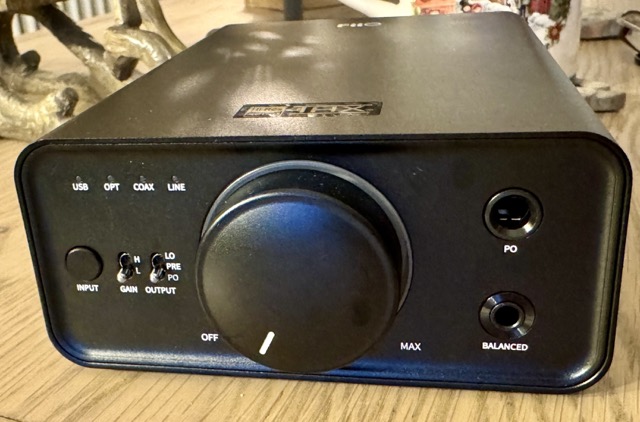
Introduction
So early this year I decided to upgrade my headphones from the usual Sennheiser and AKG ones and I decided I needed some Planar magnetic headphones and while my previous headphone amp, a Fosi Audio one was fine with the dynamic drivers I had previously it only sounded ok with these harder to drive Planar’s. It didn’t seem to have sufficent power especially with the low frequencies bass, to get these new headphones sounding as good as I expected. So after doing some research I decided a FiiO K7 and it was a revelation the difference a quality headphone Amp with sufficient power can make is incredible. So I thought after about 6 months of usage I would share some of my experience with the K7.Since it is a while since the K7 was released and there are lots of other reviews already online, I decided to focus on a few key points that I believe are still relevant after 6 months of usage, so read on to see what I think of the K7.
Packaging and Unboxing:
My experience with FiiO products is they are exceptionally well packaged and FiiO when appropriate will provide a good range of accessories and with the K7 this is again evident.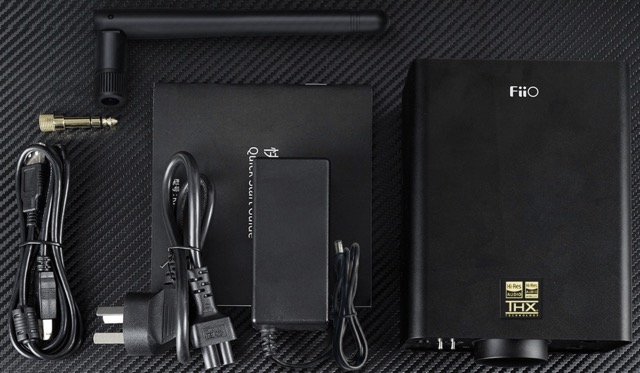
The box contained a quality power supply, a quality USB cable, a 6.35mm 1/4Inch Male to 3.5mm 1/8 Inch Female headphone adapter and of course the star of the show the “K7” itself.
Build Quality: FiiO K7
Note: I had no interested in bluetooth so got the non-BT version but I will reference the BT where I think it might be relevant.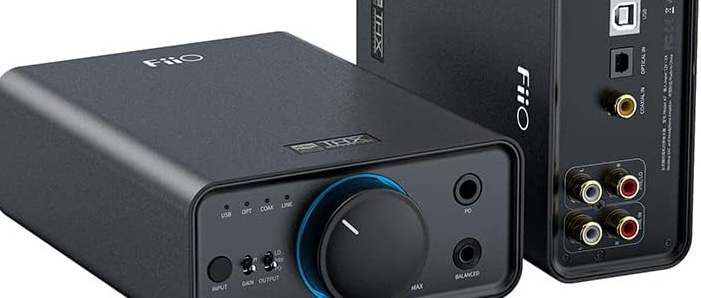
Front
The front panel of the K7 is similar to FiiO other offering, the K5Pro and the K9. It sports a sleek, low-profile input button replacing the traditional lever. This modification, coupled with two strategically placed switches for gain control and output selection, elevates the unit’s ergonomic appeal. Above these controls, four white LEDs, a visual cue for the active input is a nice touch.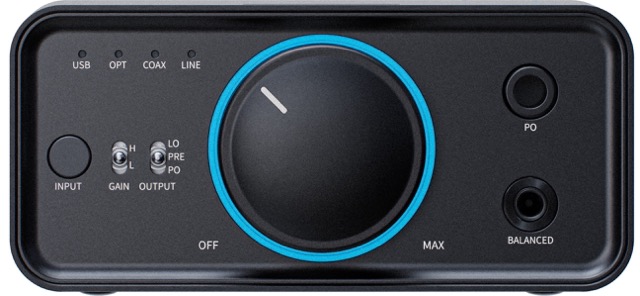
Notably, the K7’s volume wheel, a central feature is alson probably the most “controversal” aspect of the design. There are 2 key aspects of the design of the volume wheel are probably crucial to your feelings about the K7.
- It has ambient glow around the volume, with a different color depending on the source playing
- It’s a digital Volume control that is subtle at low volumes but much larger at higher volumes so can be non-intuitive compared to other devices.
With the second point, I actually appreciate what FiiO have done but it might depend on your use-case, if you have both easy to drive IEM’s and harder to drive headphone’s you will probably appreciate the way the volume control works. Basically the first 1/2 of the volume is for IEM’s giving you lots of control over subtle changes in volumes, but when using hard to drive headphones you won’t hear anything until you get to maybe the 2 o’clock position. It one of those things in audio, the massive contrast in SPL needed between easy to drive IEM’s (that need to work on low powered mobile devices) and headphones that require lots of power. The other notably thing about the volume control is that it is digital so perfectly matched but can be a minor 1/2-second delay between turning the control and the volume updating, I generally set a volume for my headphone of choice and then use the volume on my ‘streamer / pre-amp’ but if you were adjusting the volume continuously the minor delay is something to be aware off.
Back
The rear panel of the K7 hosts a comprehensive array of I/O options including RCA Line In, RCA Pre/Line Out, Coax, Optical, USB input and a 12V barrel connector. For the K7 BT variant, there is also a BL antenna socket near the power connector.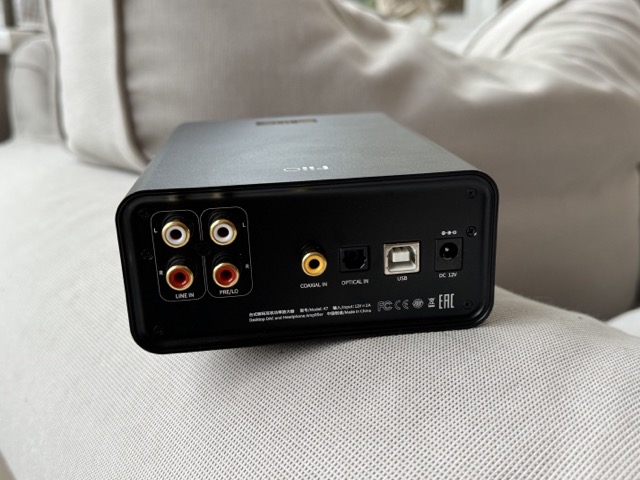
Internals
At the heart of the K7 lies a pair of AK4493SEQ DAC chips and an XMOS XUF 208 microcontroller, each channel being individually catered to. The inclusion of dual THX AAA 788+ modules, typically reserved for higher-end equipment, reflects FiiO’s uncompromising approach to sound quality.Furthermore, six different audio circuits are in place to prevent issues like crosstalk, enhancing signal purity. The presence of the XMOS XUF208 decoder chip and dual-clock management ensures compatibility with a wide range of music formats, adding to its versatility. FiiO have an impressive balanced architecture within the F7:
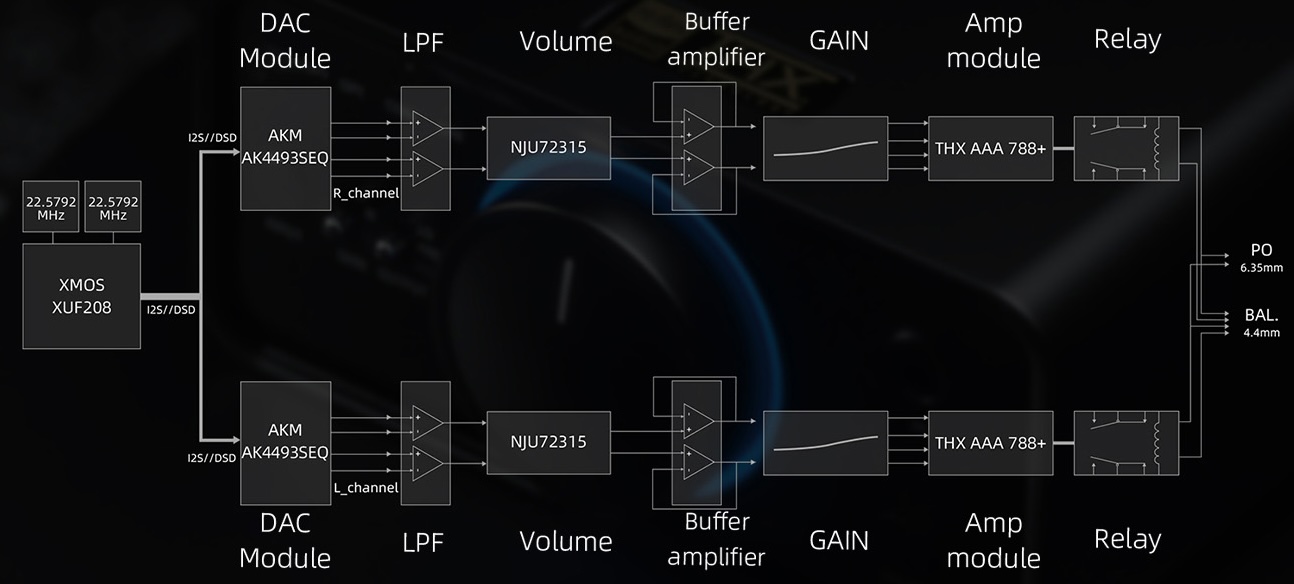
Key Specifications:
| Power | SE | 1.2W (@32Ω) |
| BAL | 2W (@32Ω) & 560mW (@300Ω | |
| THD+N | PO | <0.00028% (1 kHz,32Ω,dbA) |
| LO | <0.0005% (1kHz,10kΩ,dbA) |
Format Support:
In terms of audio support, the K7 is impressively versatile. It handles PCM audio up to 32-bit/384kHz and DSD256 via USB, 24-bit/192kHz through coaxial, and 24-bit/96kHz via optical.| Maximum supported sampling rate | Channel |
|---|---|
| PCM 384kHz-32bit/DSD256 | USB DAC |
| PCM 192kHz-24bit | COAX |
| PCM 96KHz-24bit | OPT |
Listening impressions and Key Measurements
Impressions:
Quiet simply at this price point this is the best sounding headphone amplifier you can get. Too many < $200 headphone amplifers just haven’t the power to really deliver a bass depth for planars (and provide power to other hard to drive headphones like the Sennheiser HD800 ). The “balanced audio architecture” that FiiO have implemented is exceptional for a clean sound, and as you will see in the measurement the K7 deliveries a flat “frequency response”, so it’s not coloring the sound in any way. So feed a clean digital source (via USB or optical ) and you are hearing how your headphones interpret the audio “transparently” as it should be with a headphone amplifier.High Gain:
It also has enough power that I did not normally have to use the high-gain with my planars, but again I appreciate that it is available for some future headphone purchases. I do have a few test tracks, for example, John Cage famous 4.33 where I switched to high gain and maximize the power to really test how well a headphone DAC performs. That famous ‘silent’ track is not silent at all, it’s recording obviously has some tape hiss given its age, but with super resolving headphones and a great Amp you can hear extra things like a ticking clock, and dinner plates and the occasional door in the background opening and closing. The FiiO with high gain did not distort the sound or introduce extra noise into the mix and these subtle details all came out crystal clear. This headohone amp therefore has an amazing ability to get all the detail out of a recording.Key Measurements:
As you can hopefully tell from my listening impressions this is a very clean sounding headphone amp with lots of power.So FiiO also produce some excellent measurements here but let’s briefly look at some indepedent measurements to back FiiO own measurements claims and I think are inline with my subjective opinions:
Frequency Response - digital input with balanced headphone output:
Thanks to Techpowerup: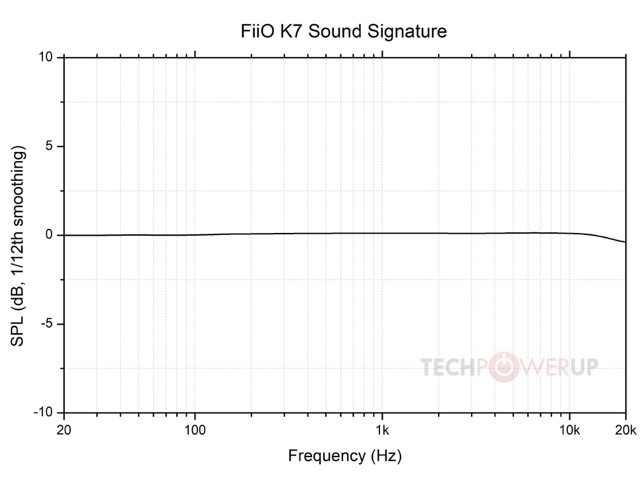
The left scale of this is important as it shows a perfectly linear FR up to 15k and then a slight roll off less than 0.5 dB as it approaches 20k
SINAD
Thanks to l7audiolabObviously SINAD is a slightly controversial metric but basically anything with better than 80 SINAD is ‘clean’ sounding and both from the single ended and the balanced the K7 is exceptional:

Here the SINAD of 115 dB is the balanced output (though the Single Ended is also exceptional 113 dB)
Multi-tone distortion:
And finally the multi-tone distortion (again thanks to l7audiolab):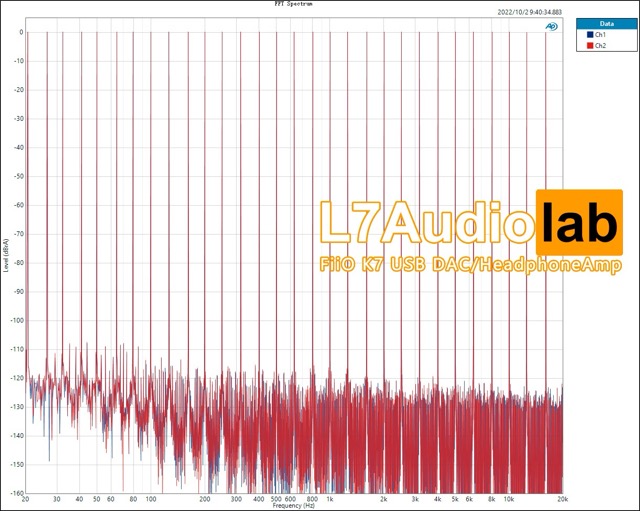
Again, this is exceptionally good, basically when multiple tones are simulateously fed into the Amp it is not producing any distortion below -109 dB well below the audible thresholds.
Rating
I gave this a pragmatic rating of 4 - while it’s still great there are other alternatives now including the FiiO’s K11 which while it has less power it has more features at an even more pragmatic price, but I still believe the K7 is probably the safer bet for someone starting off in the IEM and headphone hobby as it covers everything from the easiest to drive IEM’s to the hardest to drive headphones and has an exceptionally good DAC.Summary
This can be the only headphone amplifier you will ever need, it measures well, has lots of appropraite features, a great internal clean audio architecture and supports both low impedance headphones, IEMs and high impedance power hungry headphones.The K7 sets a new standard in what headphone driving performance you can get at a budget-friendly price, making it very much the perfect pragmatic choice.
Headphones and Coffee
Previously known as Wretched Stare
Pros: Power, low noise, and robust construction and cost
Cons: only two gain settings , no Bluetooth on this model.



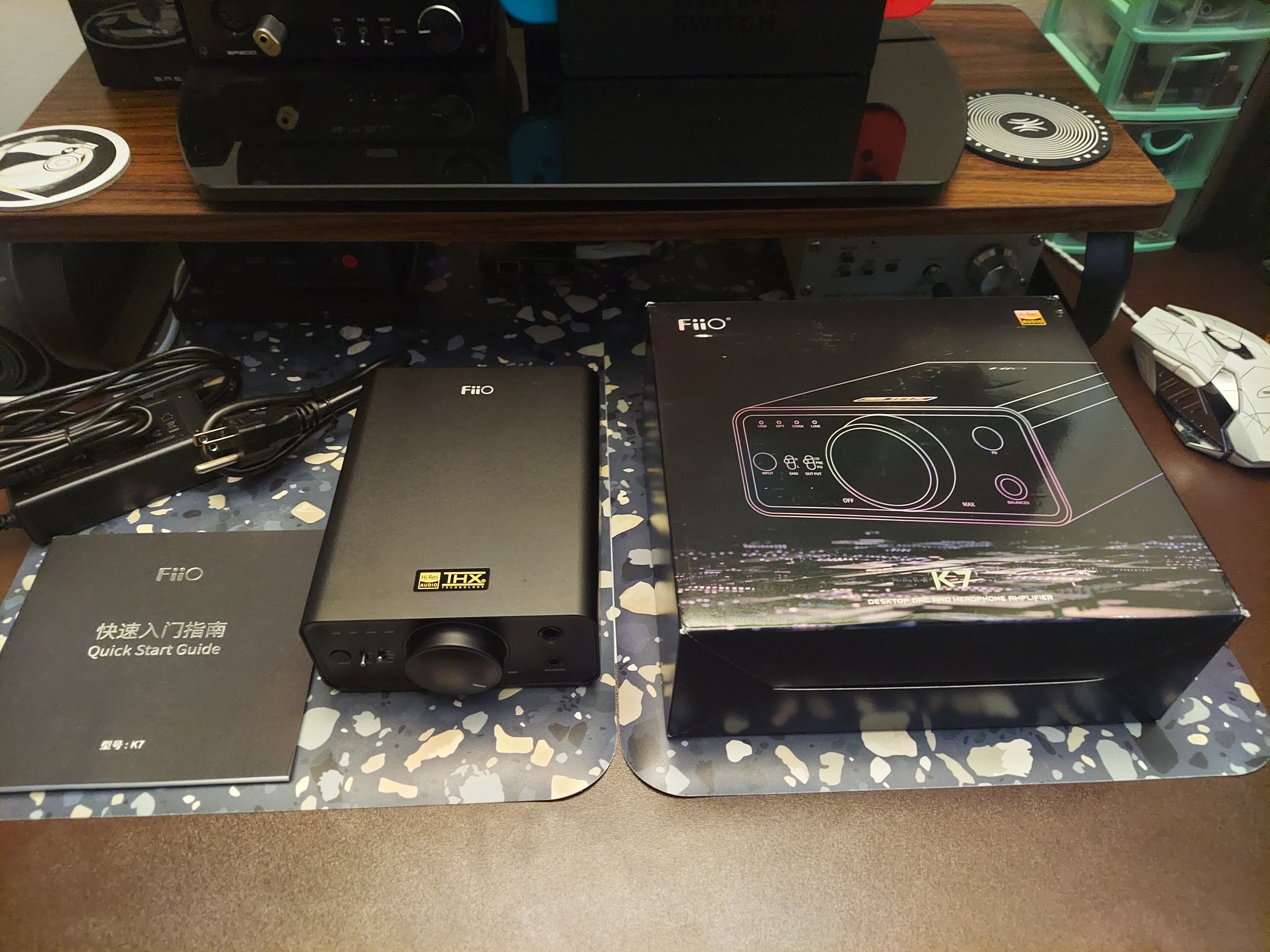
Specifications:
Model : K7
DAC : AK4493SEQ x2
Decoder : XMOS XUF 208
Amplifier : Dual THX AAA 788+
Volume Chips : NJU72315+OP
Outputs : 6.35mm Single-Ended + 4.4mm Balanced
Inputs : USB, Optical, Coaxial, RCA
6.35mm SE Output : up to 1220mW @ 32Ω / 140mW @ 300Ω
4.4mm BAL Output : up to 2000mW @ 32Ω / 560mW @ 300Ω
SNR : >120dB (A-weighted, UAC)
Noise floor : PO<4.1uV
THD+N : <0.0003% (1 kHz/32Ω/dbA)
Output impedance : <1Ω
Dimensions : 120 x 168 x 55mm
Weight : 610g
Inside the box :
1 x FiiO K7 Desktop Headphone DAC/Amplifier
1 x USB-A to USB-B cable
1 x Power Cable
1 x Power Adapter
1 x User Manual & Warranty card
The Fiio K7 is an all-in-one unit that sells for under $200. It features a Full Balanced HiFi DAC Headphone Amplifier AK4493S*2, XMOS XU208 PCM384kHz DSD256,USB/Optical/Coaxial/RCA Inputs, 6.35mm/4.4mm Outputs.
About the Fiio K7
The most competitive and cost-effective desktop balanced DAC/Amp within the 300-USD range.
Adopts the six-stage audio circuit as in FiiO’s high-end devices and features 2 AMK’s latest AK4493SEQ DACs and dual THX AAA 788+ amps.
Supports multiple outputs- 4.4mm balanced out, 6.35/3.5mm single-ended out, as well as multiple inputs- USB, optical, coaxial and AUX in.
Comes with versatile functions as well as robust output power- 1% THD+N under BAL output, 2000mW stable output power, which can drive most headphones, including full-size headphones.
Supports input selections, 2 gain levels and 3 output levels, and features RGB indicator lights that can display the working state and differentiate sampling rates.
Sound:
The Fiio K7 is clear and natural sounding with low noise and a hint of warmth to give it character. It is decently transparent, detailed and open sounding with great dynamics.
Performance:
The device performed well with full-sized Planar headphones and sensitive hybrid IEMs. All BA IEM however there was a slight hiss at start, but this dissipated with music.
Gear used:
AKG 712, and K240
HIFIMan Ananda, HE x-4 and HE350
Kinera Hodur, Celest pandamon, and Sif
Hidizs MS5 and MD4
KZ Krilla, AS24, and CCA Duo
o0genesis0o
Headphoneus Supremus
Pros: + Volume knob!
+ A lot of volume adjustment range for sensitive IEMs
+ Extract the most sound quality out of your IEMs
+ Versatility
+ Assuring build quality
+ Price
+ A lot of volume adjustment range for sensitive IEMs
+ Extract the most sound quality out of your IEMs
+ Versatility
+ Assuring build quality
+ Price
Cons: - Hiss on high-gain with ultra-sensitive IEMs
Over the past few months, you have seen FiiO K7 as the reference DAC/amp to review other IEMs and earphones. It is finally time for the K7 to get on my review table for dissection.
Let’s discuss FiiO K7 and whether an IEM listener should / should not get a desktop DAC/amp such as K7.
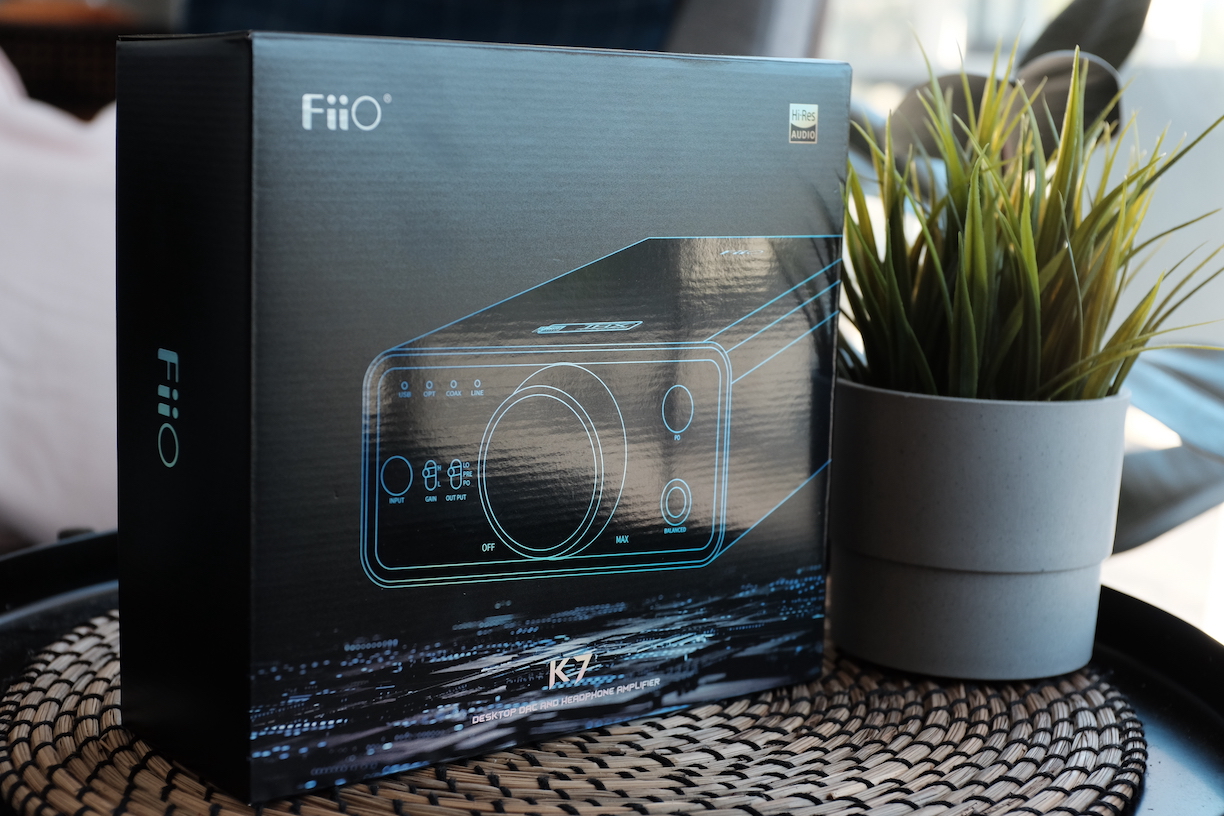
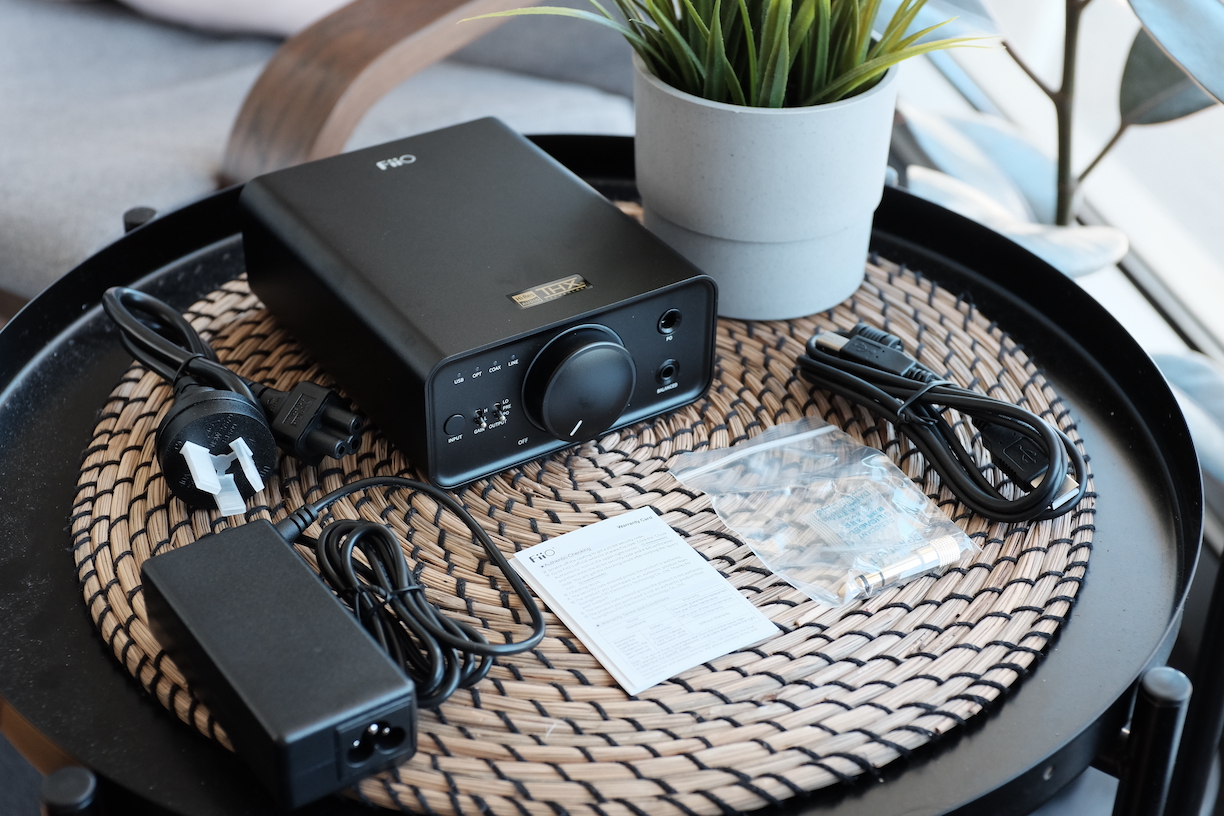
K7 comes in a large box with the familiar sci-fi design motif and holographic prints. Inside the box, you find the K7 itself, a USB-B to USB-A cable, a 6.35mm to 3.5mm adapter, a big power brick, and the K7 itself.
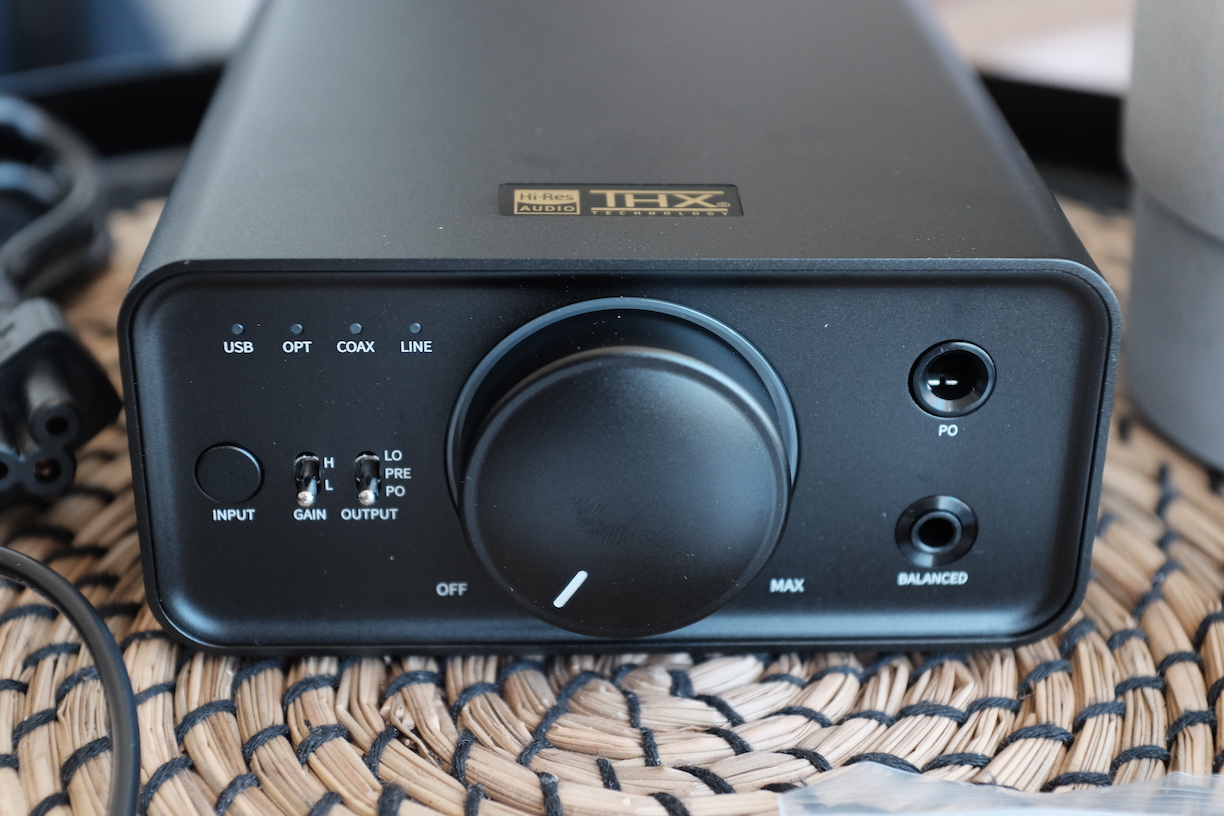
So what exactly is K7?
It’s an all-in-one unit with Digital-Analogue-Converter (DAC) and headphone amplifier. You can use K7 like a USB DAC/amp dongle: USB side to the laptop, audio side to your favourite headphones or IEMs. Noted that you need to plug the K7 into wall power.
Moreover, K7 would take over all audio output duties and disable the volume control feature on your laptop. I don’t mind because, would you look at that volume knob! That, alone, is worth getting a desktop setup.
The knob also doubles as the power switch. An RGB light ring around the knob indicates the resolution of the audio file being played. The volume adjustment is partially digital, so you don’t have channel imbalance at a lower volume. However, there is a delay between the turning of the knob and the volume adjustment.
An interesting feature of the knob is that the volume increase is not linear. It ramps up slowly in the first half and then increases quickly in the second half. It means that even with very sensitive IEMs like Andromeda, I still have much room to adjust the volume. Meanwhile, many dongles tend to be super loud, even at 1/100.
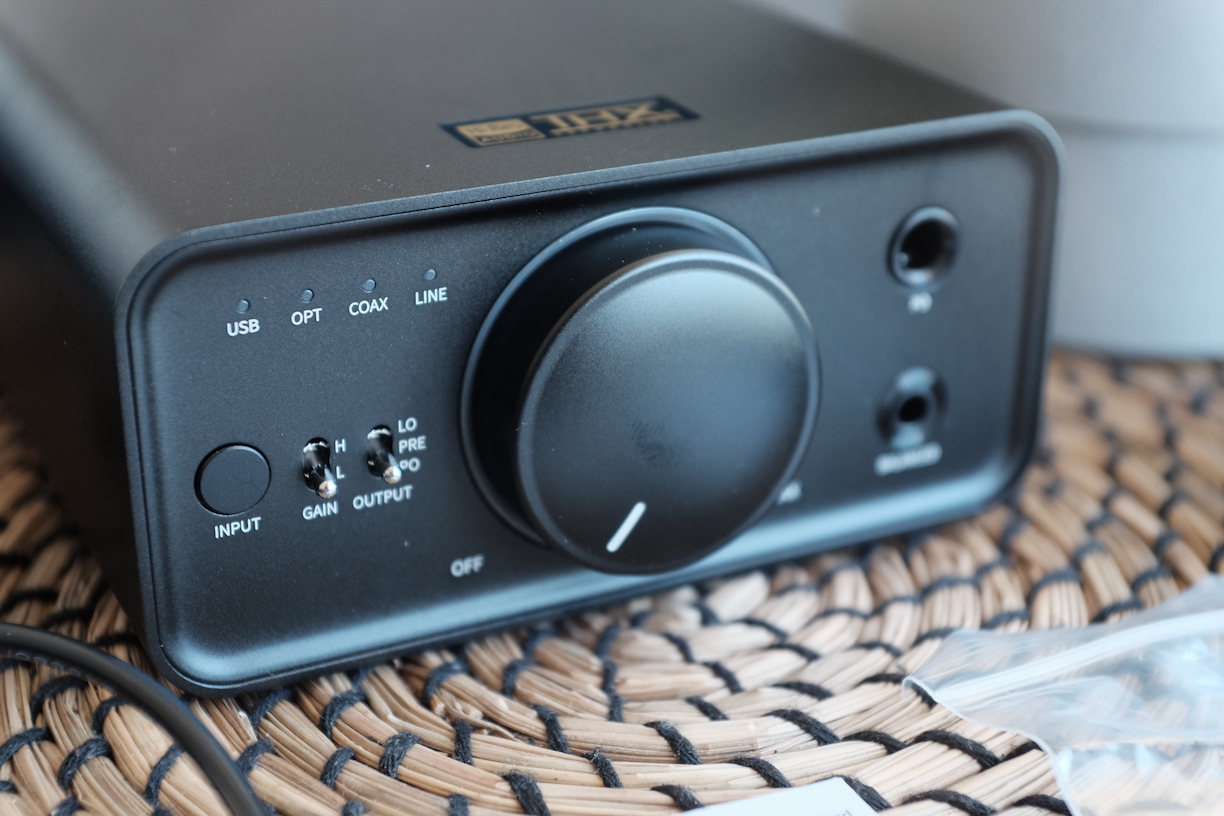
Speaking of volume, K7 has two gain settings. I hear a slightly more dynamic sound with more depth from the high-gain,single-ended, with my U12T, using Hotel California as a test track. The difference is even more prominent with demanding IEMs like Final E5000.
Still, the difference between gain settings is not as severe as the Topping G5, so I don’t think you need to worry too much. I decided to keep the gain high since the volume adjustment range is still relatively large, even with the ultra-sensitive Andromeda 2020.
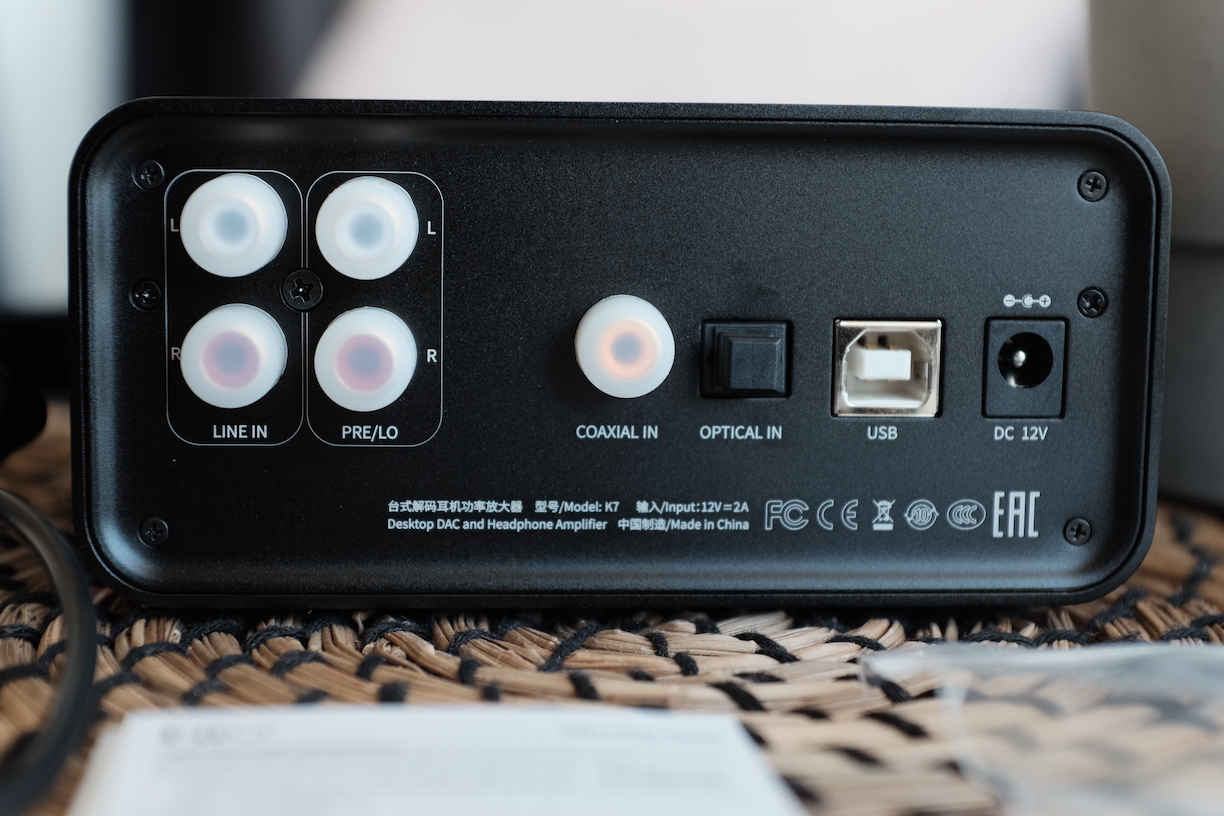
You can also use the DAC or the amplifier section of the K7 separately. For instance, you can feed analogue audio signals from a standalone DAC to K7 via the RCA line, then use the RCA output to pass the signal to the next device in your chain. For this use case, you need to switch the output of K7 to “PRE.”
You can also use the K7 as a standalone DAC by switching to the line-out (LO) output mode. The RCA output would carry the line output from the DAC section of K7.
I do not have a complicated hi-fi setup, so I use K7 as an all-in-one directly from my desktop. I use it for IEMs, headphones, and my active speakers.
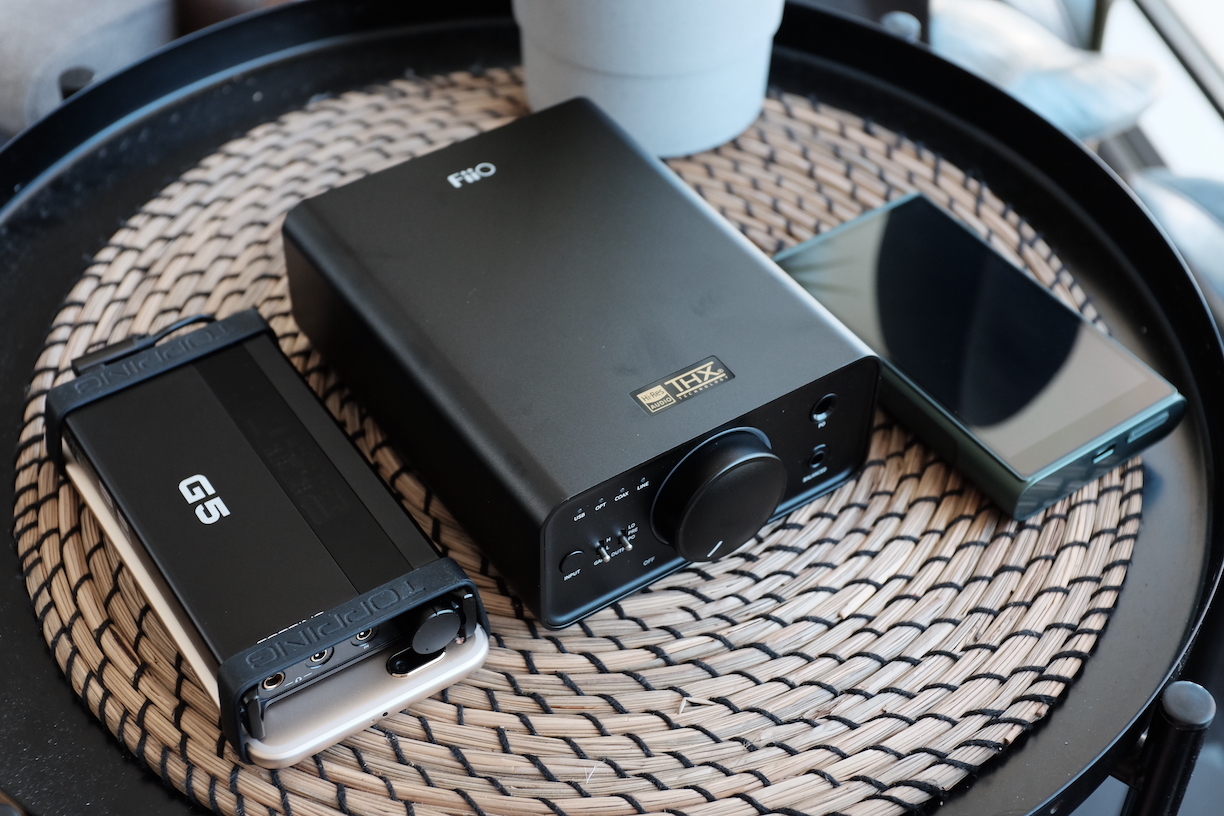
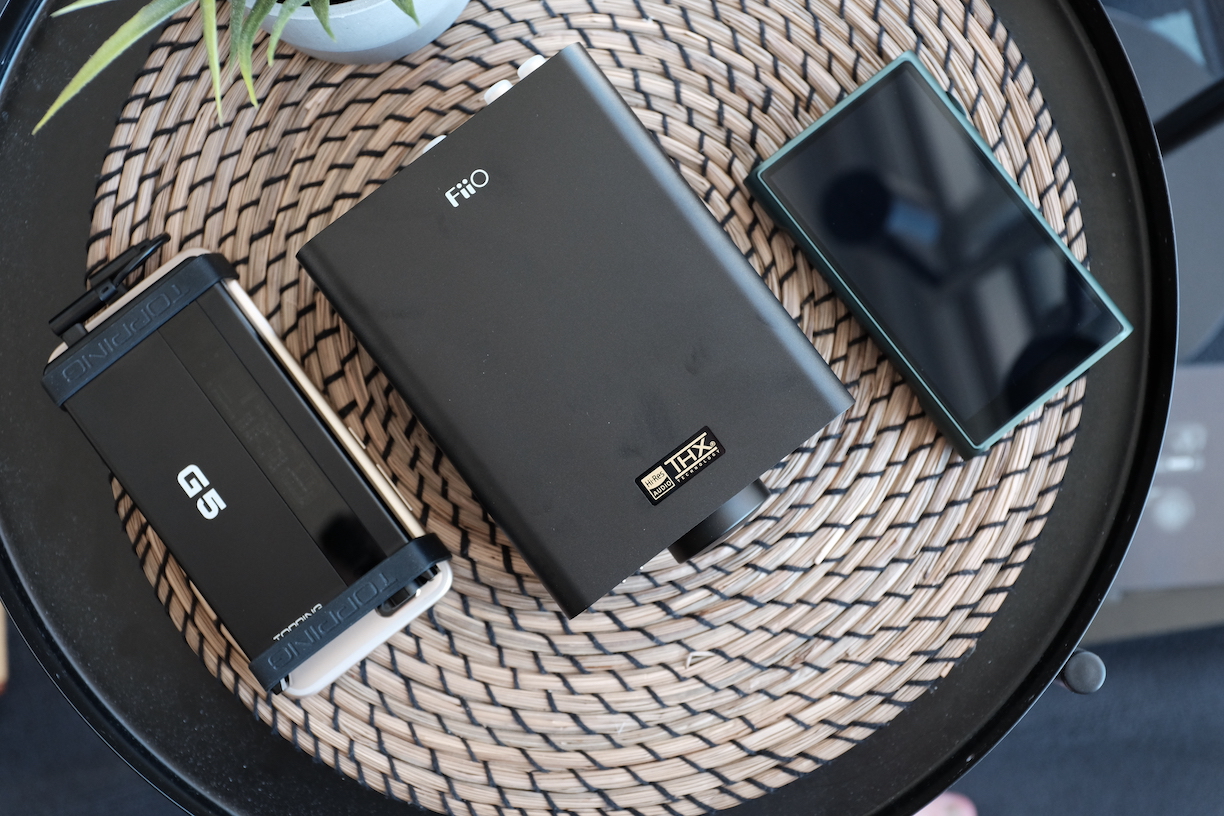
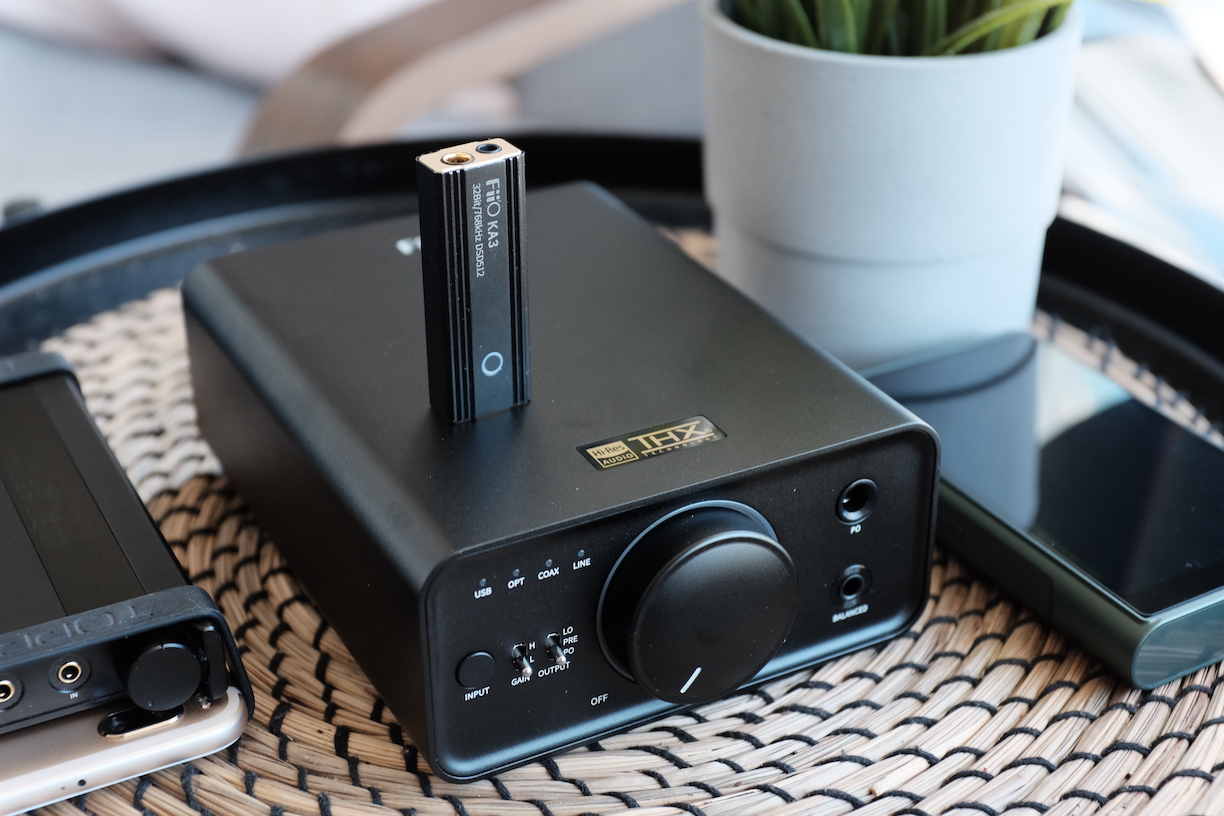
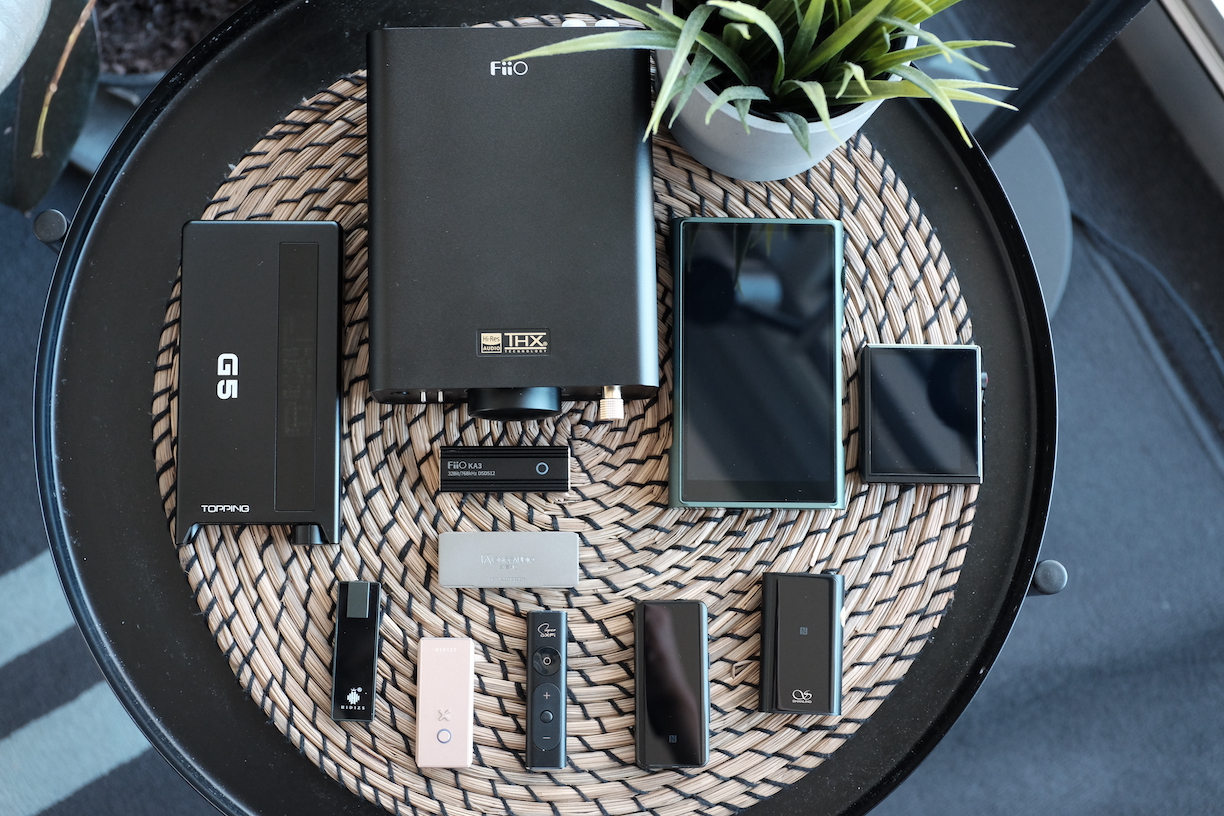
K7 is surprisingly large if you are used to petite portable gears. Against desktop competitors, the size of the K7 is more reasonable. From memory, the total volume of K7 is roughly the same as the Schiit Magni Modi stack and slightly less than the iFi Zen stack. K7 is way smaller than the Schiit Modius Magnius stack.
I find K7’s build quality assuring. It has a metal chassis that is cold to the touch but does get warm after a song or two. All buttons and switches are firm without any play or rattle.
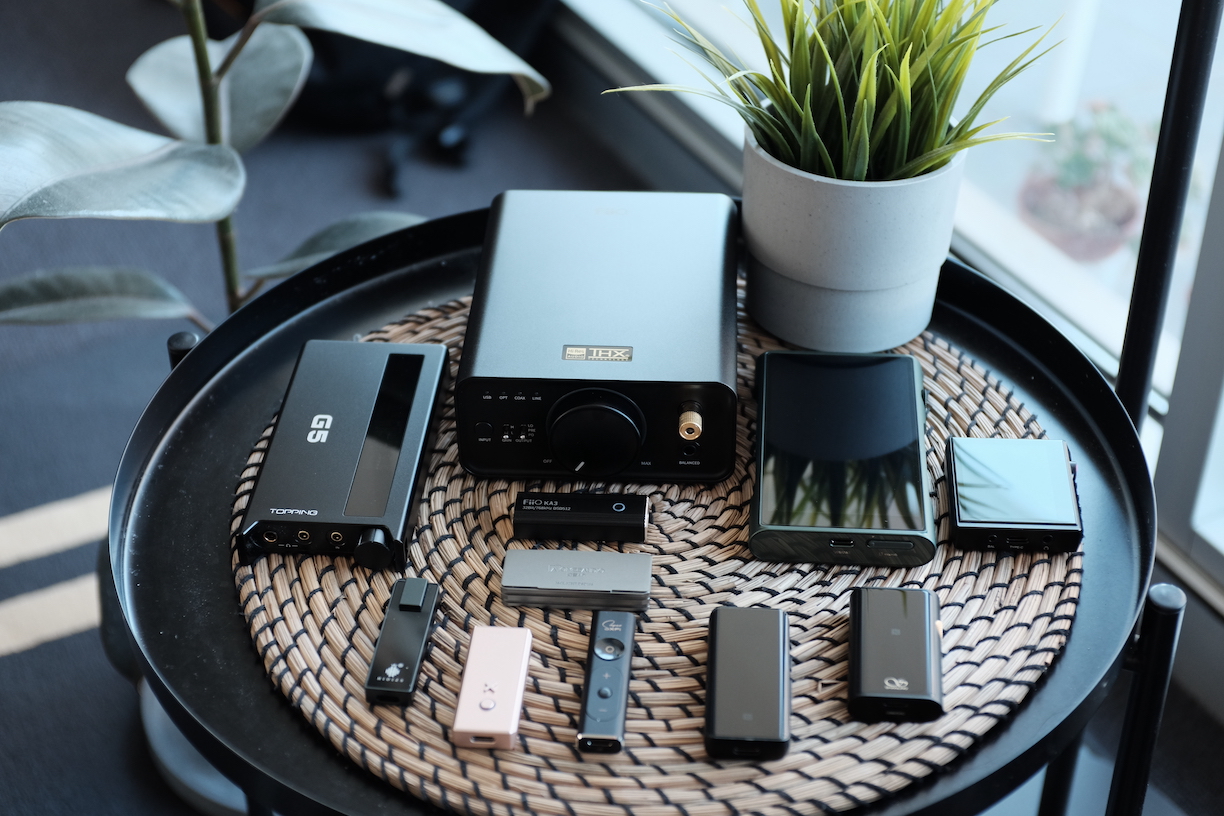
Gears for A/B tests:
The overall tonality of the K7 strongly reminds me of the Apple dongle. K7 sounds natural with proper note weight. It does not emphasise the high frequencies and reduce the midbass like some ESS-based dongles or my Topping G5. The treble region is extended and detailed without edginess, “grit”, or “glare”. At the same time, K7 does not have the deliberate colouration that adds a warm hue to the sound like Shanling M6 Ultra.
As a desktop DAC/amp, K7 can provide most IEMs that “desktop effect,” making the soundstage larger and instruments more separated. The crispness and separation of music notes across the frequency response, especially in the bass and upper treble region, are noticeably better than an average dongle. However, the degree of improvement you can hear depends significantly on the specific IEM you use.
We discuss some archetypes of IEMs and how K7 handles them below.
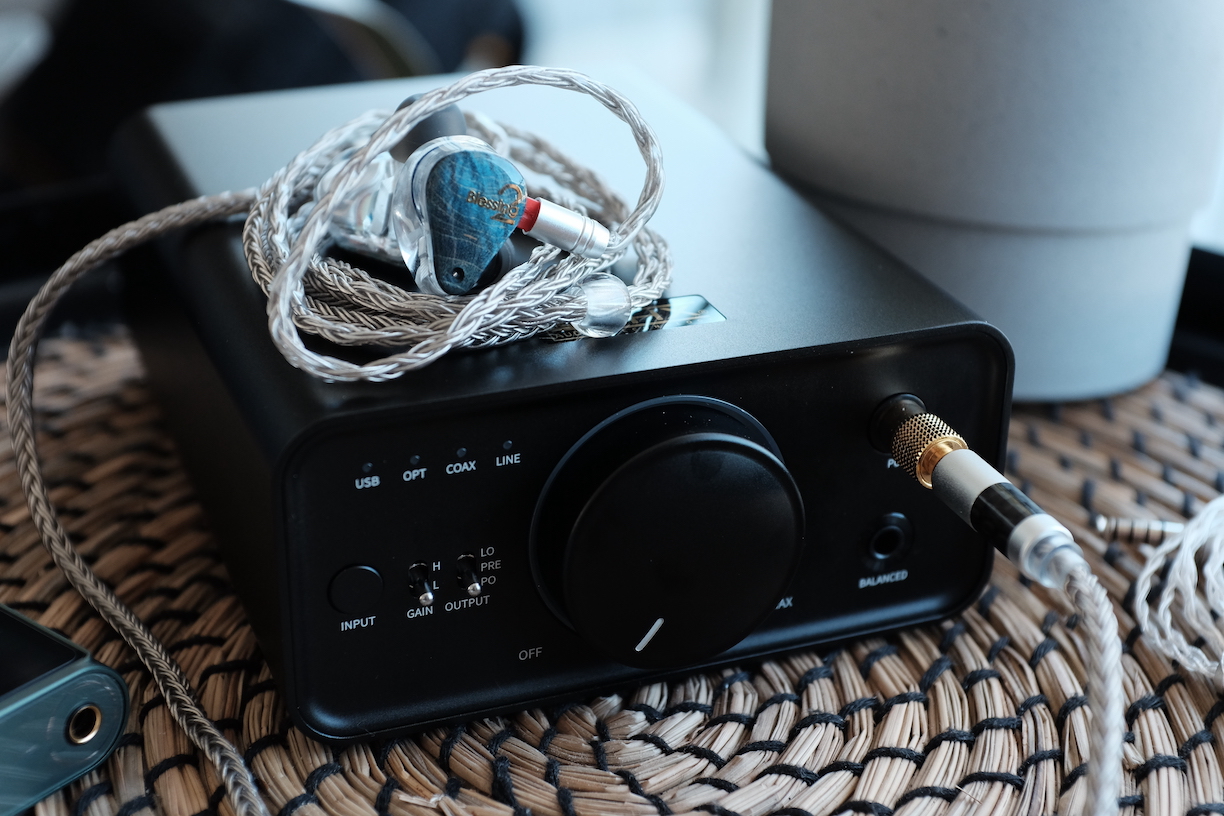
I use the 64 Audio U12T to represent an average IEM. A unique feature of U12T is a proprietary circuit called LID which ensures that the IEM’s tonality remains the same across multiple sources, regardless of sources’ output impedance. This feature makes U12T a uniquely valuable instrument to pinpoint deviations or colouring deliberately introduced by a source.
For the first test, I compared K7 with the Apple dongle, using Hotel California as a test track. At a glance, both devices sound very close. The tonality is identical because of the LID circuit within the U12T and the similar tuning of the K7 and the Apple dongle. The differences between K7 and the Apple dongles lie in note definition, separation, and bass response. These differences became apparent only after multiple back-to-back A/B tests. After pinpointing the differences, I couldn’t stop hearing the issues; thus, the Apple dongle became less appealing.
The most significant differences between K7 and the Apple dongle are the texture and details in the bass response. With the K7, I can hear the texture in the decay end of the kicks and easily separate the bass guitar from the kick drum. With the Apple dongle, the textures of the kicks are less apparent, and the bass guitar is not as clearly separated from the kicks. The sense of layering of instruments from closer to further away is also more robust with K7. The Apple dongle tends to place instruments on a few planes that are closer together, so the 3D effect of the soundstage is reduced.
Detail-rich classical recordings, such as Flute Partita in A Minor, BWV 1013: IV. Bourrée anglaiseperformed by Emmanuel Pahud, highlight the performance gap between K7 and the Apple dongle more than rock or commercial music. With K7, flute notes are more crisp and well-defined, and treble air details are precise and highlighted. There is a sense of realness and 3D that U12T can bring out with the help of K7, but not with the Apple dongle.
The performance gap between K7 and KA3 is similar in type and magnitude to that between K7 and the Apple dongle. With the flute partita, I can hear more ambience and reverberation of the room with K7. The treble response of KA3 has some “grit” that prevents the treble air from being rendered as clearly and highlighted as the K7. The clarity of flute notes is also higher on K7, albeit not much. I also hear a gap in bass texture and separation between K7 and KA3. Still, it’s difficult to spot without careful A/B and critical listening.
Conclusion: 5/5 - Excellent. K7 out-resolves both an Apple dongle and a good dongle, such as KA3, across the frequency spectrum. K7 can add a bit of oomph to the soundstage presentation. However, the sound quality gap between K7 and a good dongle is very minute when driving an average IEM.

Andromeda 2020 is a notoriously picky IEM. It easily reveals the hissing noises of an audio source. It is also sensitive to the impedance of the source and the cable itself. Connecting to a mismatched audio source can ruin the sound signature of these sensitive IEMs or at least prevent them from revealing their full potential.
What can a device like K7 offer the Andromeda that the Apple dongle cannot? Two things: bass and separation. In the iconic opening of the Hotel Califonia, I immediately noticed stronger and more physical kicks with K7. On the other hand, the kicks with the Apple dongle are barely recognisable. Guitars and vocals have more precise note attacks and extended decay with K7. The separation between foreground and background, such as between the band and the audience’s cheer at 3:00, is also more distinctive with K7. As a result of these differences, the Andromeda feels more lively and 3D with K7 compared to the Apple dongle.
The gap in resolution and separation between KA3 and K7 is slimmer. However, the KA3 still cannot power the bass kicks of Andromeda like K7. Due to the bass, I would say Andromeda sounds better on K7 compared to KA3.
Whilst the sound quality improvement is a welcome upgrade, the critical advantage of K7 is the volume control. With most dongles, I need to turn the volume to a very low level to avoid blowing my ears out with the Andromeda. There have been times when I don’t have a volume level left to reduce when a track is mastered with too high volume. With the dongles, I also lack the granular volume control offered by K7’s knob.
K7 is not perfect, though. When I turn the volume very low, even at low gain, I hear a slight hissing noise. At high gain, the hiss is more prominent. You are unlikely to notice the hiss when listening to loud and dense music, such as Hotel California unless you actively look for the hiss. However, the hiss on the high gain is very prominent with sparse recordings such as Flute Partita in A Minor, BWV 1013: IV. Bourrée anglaiseperformed by Emmanuel Pahud.
Conclusion: 4/5 - Good. The K7 does an excellent job of revealing the full potential of Andromeda. However, it is held back by the noise floor.

Despite the petite appearance, Final Audio E5000 is one hell of an IEM to drive. Low impedance, low sensitivity, and significantly bass-boosted make a nasty combination. You can get the midrange 1kHz region loud with even an Apple dongle. However, the bass would become muddy, making the E5000 blunted, fuzzy, and congested. That’s not how these IEMs should perform. When powered by the proper desktop amplifier, E5000 is a bass-head dream with an overwhelming amount of tight and deep bass. The clarity of the midrange and treble region is also more than adequate, and the soundstage is broad and deep.
K7 drives E5000 like a champ. In fact, the description above regarding how E5000 should sound is based on how K7 drives these stubborn IEMs.
The differences between K7 (high-gain) and Apple dongle are immediately noticeable when replaying Hotel California, centering around aspects. Firstly, the depth and layering of the soundstage. The Apple dongle does not convey any sense of depth and layering, pushing the primary vocal right up to my face. The K7 conveys a strong sense of depth, putting the main vocal in front of me as if I’m listening to a 2-channel system. K7 also renders a strong separation between the band in the foreground and the audience’s cheers in the background.
Secondly, the kick drums sound tighter and deeper on K7. The Apple dongle renders kicks and bass guitar as loud “thud thud” sounds with fuzzy attack and long decay. K7 tightens up and extends the bass deeper into the sub-bass, making you feel more bass whilst reducing the boominess.
Thirdly, K7 increases the clarity across the whole frequency range. Instruments and vocals become easier to track. More nuances are revealed.
The gap between KA3 and K7 is smaller and requires more careful A/B tests. Using Hotel California again as a test track, I found that K7 and KA3 place main vocals almost the same distance. However, K7 conveys a stronger sense of layering between the band and the audience. E5000 also sounds more detailed and vibrant on K7. Guitars have more brightness and bites. The cheer of the audience comes across more clearly and detailed.
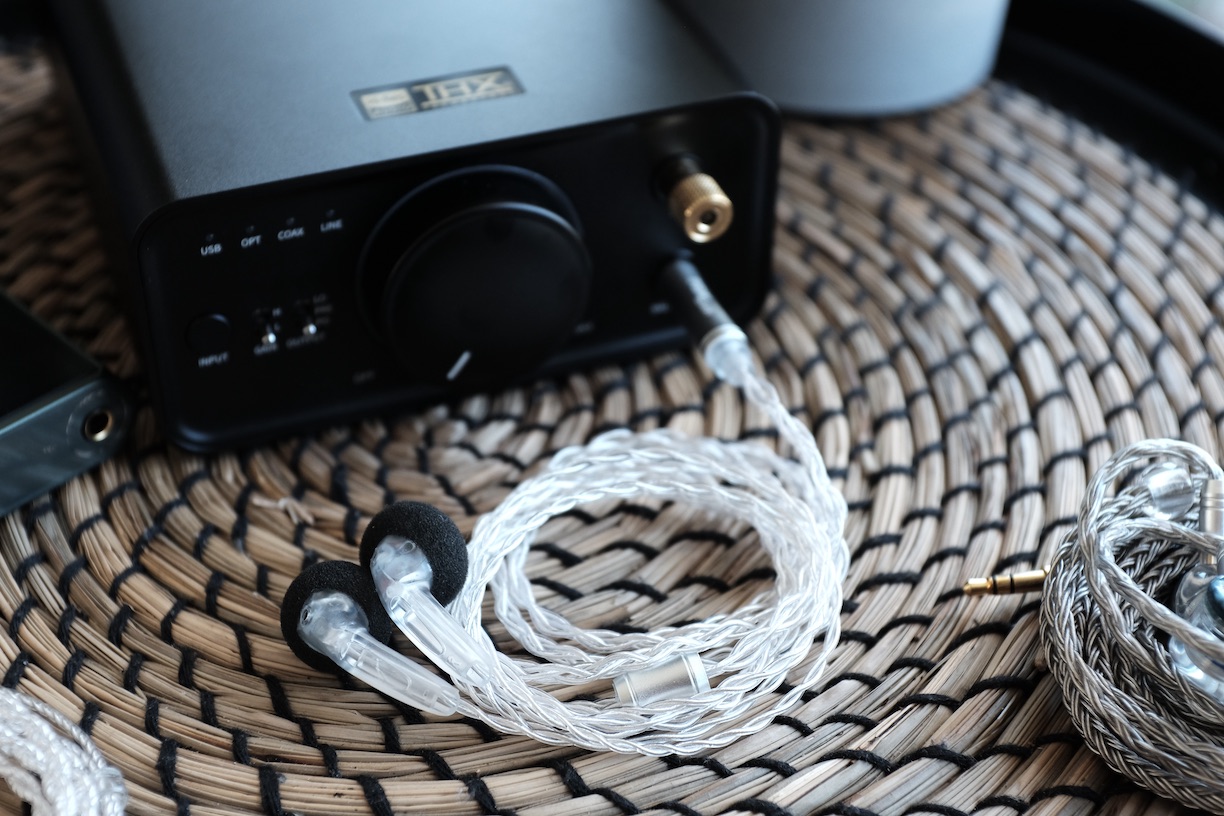
Serratus is a pair of 300ohm flathead earbuds made by a fellow head-fi reviewer known as tgx78. These earbuds have achieved legendary status amongst enthusiasts due to their resolution and soundstage imaging. It’s also excellent for testing the ability of an amplifier to drive high-impedance devices.
Since the Apple dongle does not have 4.4mm termination, I will skip and focus on comparing K7 and KA3. With Hotel Califonia, I immediately hear a larger soundstage with K7. The band sits further from me, and all instruments are spread out, creating a nice 3D illusion. KA3 feels more congested in comparison. Vocals and guitars sound duller and less detailed with KA3, even though the KA3 sounds more “trebly” than K7.
Using Flute Partita in A Minor, BWV 1013: IV. Bourrée anglaise as another test track, I can confirm that K7 has more richness in the lower end and more details in the top end comparing to KA3. The concert flute has more warmth and body. The reverberation of the flute in the recording hall is also crisper and more detailed, adding a strong sense of ambience to the performance.
In conclusion, K7 drives 300 ohms loads to the next level compared to an average USB dongle. 5/5.
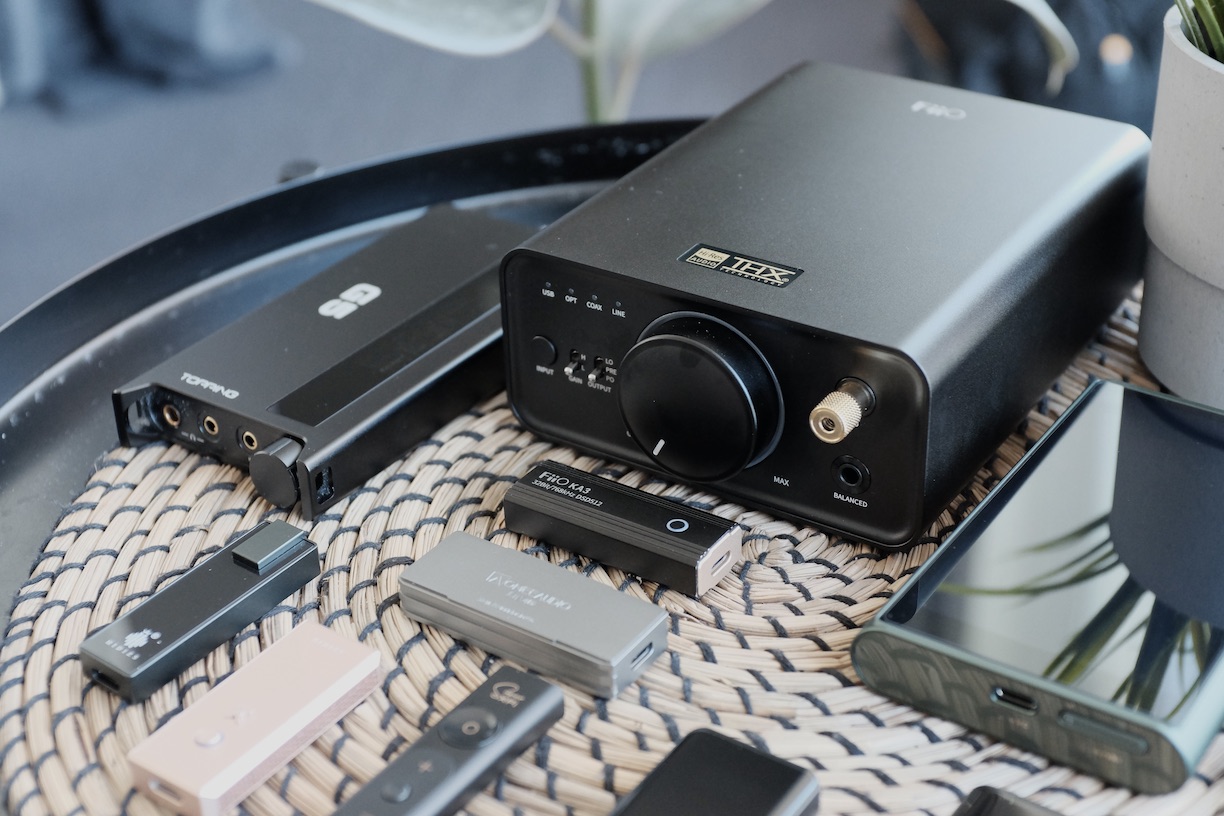
Should you get a K7 if you only listen to IEMs? It depends on whether you have a desk setup at home or office. If you have a fixed spot where you sit down and work on your computer daily, a desktop DAC/amp like K7 is a good addition. The sound quality improvement, however slim, is there. The key benefits are quality-of-life improvements such as the volume knob, the wide adjustment range for sensitive IEMs, and flexibility. And the most important of all is the peace of mind, the freedom from the nagging thought, “am I bottlenecking my IEMs with these dingy dongles?” It’s hard to bottleneck your IEMs when you drive them with a beefy desktop device. Recommendation without reservation.
Pros:
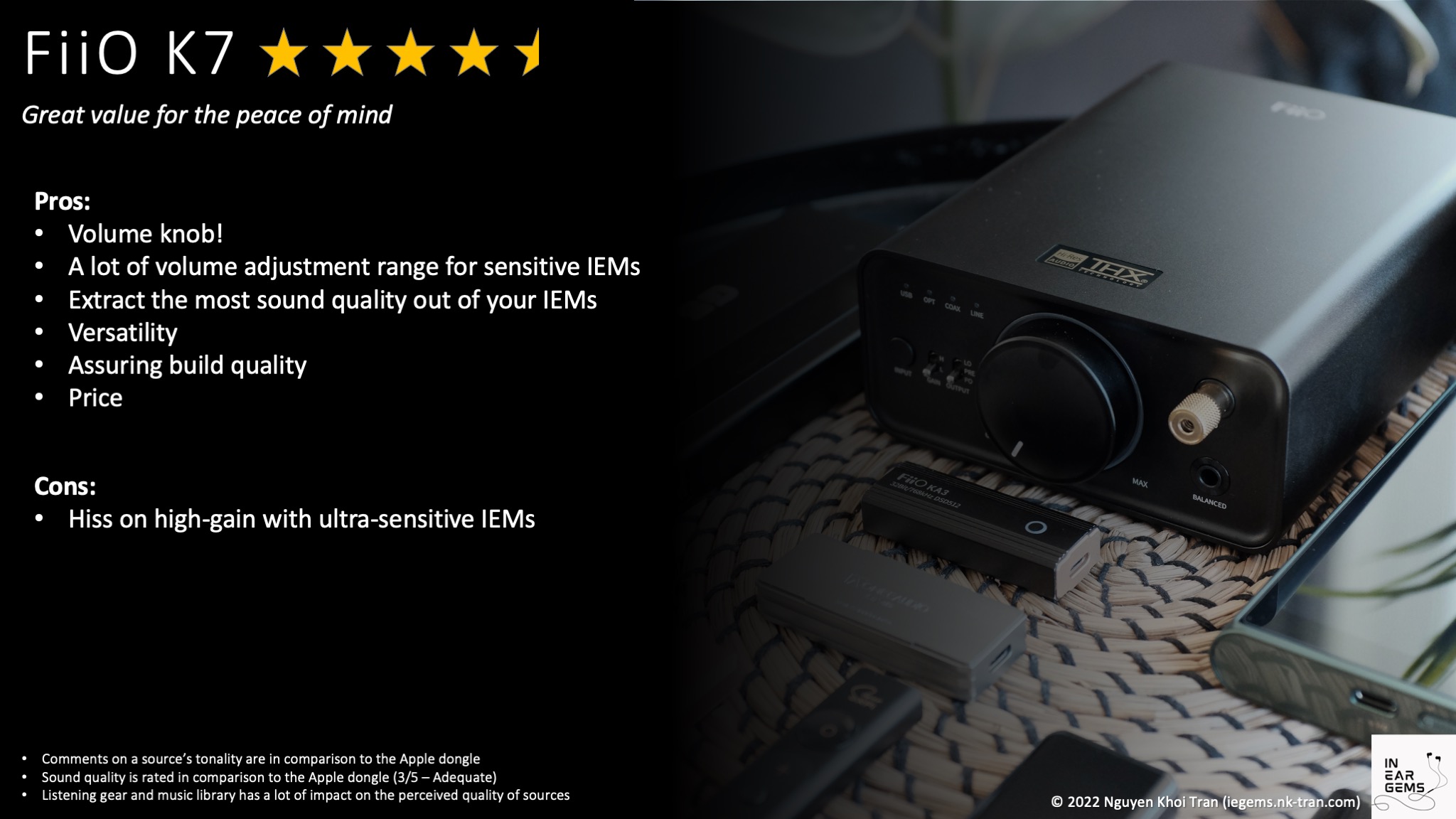
Updated: March 25, 2023
Let’s discuss FiiO K7 and whether an IEM listener should / should not get a desktop DAC/amp such as K7.
Preambles:
- I use the term “source” to denote a DAC + Amp combo.
- Sources do not make sounds. Therefore, when I say sources “sound” a certain way, I talk about the change they make to my IEMs and earphones.
- I want my music to be crisp, clear, well-separated and form a 3D soundstage around my head. Sources that intensify those characteristics of my IEMs are considered “better”.
- Ratings are given based on A/B tests with benchmark sources and IEMs.
- Making loud noises does not mean that a pair of IEMs or earphones are driven to their full potential.
- Despite my textual descriptions, improvements from sources are minor and nuanced. If you are beginning your head-fi journey, getting different IEMs or earphones would yield more benefits. If you know your gears very well, source improvements can be delightful.
- The K7 used for this review was a sample provided by FiiO (Thank you!). The unit is retailed for USD $200 (AUD $340). Australians can buy the K7 from the official retailers Addicted to Audio and Minidics. Folks elsewhere can refer to FiiO retailers list.
Specs:
- DAC Chips: AK4493SEQ x2
- Amplifiers: THX AAA 788+ x2
- Output ports: 6.35mm (Single-ended) and 4.4mm (balanced)
- Input ports: USB-B (data), RCA inputs, optical, coaxial
- Single-ended output power: 1220mW@32ohm per channel, THD+N < 1%
- Balanced output power: 2000mW@32ohm per channel, THD+N
- Output impedance: < 1ohm (32ohm load)
- MQA support: N/A
Non-sound Aspects


K7 comes in a large box with the familiar sci-fi design motif and holographic prints. Inside the box, you find the K7 itself, a USB-B to USB-A cable, a 6.35mm to 3.5mm adapter, a big power brick, and the K7 itself.

So what exactly is K7?
It’s an all-in-one unit with Digital-Analogue-Converter (DAC) and headphone amplifier. You can use K7 like a USB DAC/amp dongle: USB side to the laptop, audio side to your favourite headphones or IEMs. Noted that you need to plug the K7 into wall power.
Moreover, K7 would take over all audio output duties and disable the volume control feature on your laptop. I don’t mind because, would you look at that volume knob! That, alone, is worth getting a desktop setup.
The knob also doubles as the power switch. An RGB light ring around the knob indicates the resolution of the audio file being played. The volume adjustment is partially digital, so you don’t have channel imbalance at a lower volume. However, there is a delay between the turning of the knob and the volume adjustment.
An interesting feature of the knob is that the volume increase is not linear. It ramps up slowly in the first half and then increases quickly in the second half. It means that even with very sensitive IEMs like Andromeda, I still have much room to adjust the volume. Meanwhile, many dongles tend to be super loud, even at 1/100.

Speaking of volume, K7 has two gain settings. I hear a slightly more dynamic sound with more depth from the high-gain,single-ended, with my U12T, using Hotel California as a test track. The difference is even more prominent with demanding IEMs like Final E5000.
Still, the difference between gain settings is not as severe as the Topping G5, so I don’t think you need to worry too much. I decided to keep the gain high since the volume adjustment range is still relatively large, even with the ultra-sensitive Andromeda 2020.

You can also use the DAC or the amplifier section of the K7 separately. For instance, you can feed analogue audio signals from a standalone DAC to K7 via the RCA line, then use the RCA output to pass the signal to the next device in your chain. For this use case, you need to switch the output of K7 to “PRE.”
You can also use the K7 as a standalone DAC by switching to the line-out (LO) output mode. The RCA output would carry the line output from the DAC section of K7.
I do not have a complicated hi-fi setup, so I use K7 as an all-in-one directly from my desktop. I use it for IEMs, headphones, and my active speakers.




K7 is surprisingly large if you are used to petite portable gears. Against desktop competitors, the size of the K7 is more reasonable. From memory, the total volume of K7 is roughly the same as the Schiit Magni Modi stack and slightly less than the iFi Zen stack. K7 is way smaller than the Schiit Modius Magnius stack.
I find K7’s build quality assuring. It has a metal chassis that is cold to the touch but does get warm after a song or two. All buttons and switches are firm without any play or rattle.
Sound Performance

Gears for A/B tests:
- 64 Audio U12T (12.6ohm, 108dB/mW)
- Campfire Audio Andromeda 2020 (8.7ohm, 122.5dB/mW)
- Final Audio E5000 (14ohm, 93dB/mW)
- TGXear Serratus (300ohm)
- Apple USB-C to 3.5mm dongle (3/5 benchmark - Average)
- FiiO KA3 (4/5 benchmark - Good)
- Topping G5
- Shanling M6 Ultra
The overall tonality of the K7 strongly reminds me of the Apple dongle. K7 sounds natural with proper note weight. It does not emphasise the high frequencies and reduce the midbass like some ESS-based dongles or my Topping G5. The treble region is extended and detailed without edginess, “grit”, or “glare”. At the same time, K7 does not have the deliberate colouration that adds a warm hue to the sound like Shanling M6 Ultra.
As a desktop DAC/amp, K7 can provide most IEMs that “desktop effect,” making the soundstage larger and instruments more separated. The crispness and separation of music notes across the frequency response, especially in the bass and upper treble region, are noticeably better than an average dongle. However, the degree of improvement you can hear depends significantly on the specific IEM you use.
We discuss some archetypes of IEMs and how K7 handles them below.
Average IEM and earphones (5/5)

I use the 64 Audio U12T to represent an average IEM. A unique feature of U12T is a proprietary circuit called LID which ensures that the IEM’s tonality remains the same across multiple sources, regardless of sources’ output impedance. This feature makes U12T a uniquely valuable instrument to pinpoint deviations or colouring deliberately introduced by a source.
For the first test, I compared K7 with the Apple dongle, using Hotel California as a test track. At a glance, both devices sound very close. The tonality is identical because of the LID circuit within the U12T and the similar tuning of the K7 and the Apple dongle. The differences between K7 and the Apple dongles lie in note definition, separation, and bass response. These differences became apparent only after multiple back-to-back A/B tests. After pinpointing the differences, I couldn’t stop hearing the issues; thus, the Apple dongle became less appealing.
The most significant differences between K7 and the Apple dongle are the texture and details in the bass response. With the K7, I can hear the texture in the decay end of the kicks and easily separate the bass guitar from the kick drum. With the Apple dongle, the textures of the kicks are less apparent, and the bass guitar is not as clearly separated from the kicks. The sense of layering of instruments from closer to further away is also more robust with K7. The Apple dongle tends to place instruments on a few planes that are closer together, so the 3D effect of the soundstage is reduced.
Detail-rich classical recordings, such as Flute Partita in A Minor, BWV 1013: IV. Bourrée anglaiseperformed by Emmanuel Pahud, highlight the performance gap between K7 and the Apple dongle more than rock or commercial music. With K7, flute notes are more crisp and well-defined, and treble air details are precise and highlighted. There is a sense of realness and 3D that U12T can bring out with the help of K7, but not with the Apple dongle.
The performance gap between K7 and KA3 is similar in type and magnitude to that between K7 and the Apple dongle. With the flute partita, I can hear more ambience and reverberation of the room with K7. The treble response of KA3 has some “grit” that prevents the treble air from being rendered as clearly and highlighted as the K7. The clarity of flute notes is also higher on K7, albeit not much. I also hear a gap in bass texture and separation between K7 and KA3. Still, it’s difficult to spot without careful A/B and critical listening.
Conclusion: 5/5 - Excellent. K7 out-resolves both an Apple dongle and a good dongle, such as KA3, across the frequency spectrum. K7 can add a bit of oomph to the soundstage presentation. However, the sound quality gap between K7 and a good dongle is very minute when driving an average IEM.
Low-impedance, high-Sensitivity IEM (4/5)

Andromeda 2020 is a notoriously picky IEM. It easily reveals the hissing noises of an audio source. It is also sensitive to the impedance of the source and the cable itself. Connecting to a mismatched audio source can ruin the sound signature of these sensitive IEMs or at least prevent them from revealing their full potential.
What can a device like K7 offer the Andromeda that the Apple dongle cannot? Two things: bass and separation. In the iconic opening of the Hotel Califonia, I immediately noticed stronger and more physical kicks with K7. On the other hand, the kicks with the Apple dongle are barely recognisable. Guitars and vocals have more precise note attacks and extended decay with K7. The separation between foreground and background, such as between the band and the audience’s cheer at 3:00, is also more distinctive with K7. As a result of these differences, the Andromeda feels more lively and 3D with K7 compared to the Apple dongle.
The gap in resolution and separation between KA3 and K7 is slimmer. However, the KA3 still cannot power the bass kicks of Andromeda like K7. Due to the bass, I would say Andromeda sounds better on K7 compared to KA3.
Whilst the sound quality improvement is a welcome upgrade, the critical advantage of K7 is the volume control. With most dongles, I need to turn the volume to a very low level to avoid blowing my ears out with the Andromeda. There have been times when I don’t have a volume level left to reduce when a track is mastered with too high volume. With the dongles, I also lack the granular volume control offered by K7’s knob.
K7 is not perfect, though. When I turn the volume very low, even at low gain, I hear a slight hissing noise. At high gain, the hiss is more prominent. You are unlikely to notice the hiss when listening to loud and dense music, such as Hotel California unless you actively look for the hiss. However, the hiss on the high gain is very prominent with sparse recordings such as Flute Partita in A Minor, BWV 1013: IV. Bourrée anglaiseperformed by Emmanuel Pahud.
Conclusion: 4/5 - Good. The K7 does an excellent job of revealing the full potential of Andromeda. However, it is held back by the noise floor.
Low-impedance, low-sensitivity IEM (5/5)

Despite the petite appearance, Final Audio E5000 is one hell of an IEM to drive. Low impedance, low sensitivity, and significantly bass-boosted make a nasty combination. You can get the midrange 1kHz region loud with even an Apple dongle. However, the bass would become muddy, making the E5000 blunted, fuzzy, and congested. That’s not how these IEMs should perform. When powered by the proper desktop amplifier, E5000 is a bass-head dream with an overwhelming amount of tight and deep bass. The clarity of the midrange and treble region is also more than adequate, and the soundstage is broad and deep.
K7 drives E5000 like a champ. In fact, the description above regarding how E5000 should sound is based on how K7 drives these stubborn IEMs.
The differences between K7 (high-gain) and Apple dongle are immediately noticeable when replaying Hotel California, centering around aspects. Firstly, the depth and layering of the soundstage. The Apple dongle does not convey any sense of depth and layering, pushing the primary vocal right up to my face. The K7 conveys a strong sense of depth, putting the main vocal in front of me as if I’m listening to a 2-channel system. K7 also renders a strong separation between the band in the foreground and the audience’s cheers in the background.
Secondly, the kick drums sound tighter and deeper on K7. The Apple dongle renders kicks and bass guitar as loud “thud thud” sounds with fuzzy attack and long decay. K7 tightens up and extends the bass deeper into the sub-bass, making you feel more bass whilst reducing the boominess.
Thirdly, K7 increases the clarity across the whole frequency range. Instruments and vocals become easier to track. More nuances are revealed.
The gap between KA3 and K7 is smaller and requires more careful A/B tests. Using Hotel California again as a test track, I found that K7 and KA3 place main vocals almost the same distance. However, K7 conveys a stronger sense of layering between the band and the audience. E5000 also sounds more detailed and vibrant on K7. Guitars have more brightness and bites. The cheer of the audience comes across more clearly and detailed.
High-impedance earbuds (5/5)

Serratus is a pair of 300ohm flathead earbuds made by a fellow head-fi reviewer known as tgx78. These earbuds have achieved legendary status amongst enthusiasts due to their resolution and soundstage imaging. It’s also excellent for testing the ability of an amplifier to drive high-impedance devices.
Since the Apple dongle does not have 4.4mm termination, I will skip and focus on comparing K7 and KA3. With Hotel Califonia, I immediately hear a larger soundstage with K7. The band sits further from me, and all instruments are spread out, creating a nice 3D illusion. KA3 feels more congested in comparison. Vocals and guitars sound duller and less detailed with KA3, even though the KA3 sounds more “trebly” than K7.
Using Flute Partita in A Minor, BWV 1013: IV. Bourrée anglaise as another test track, I can confirm that K7 has more richness in the lower end and more details in the top end comparing to KA3. The concert flute has more warmth and body. The reverberation of the flute in the recording hall is also crisper and more detailed, adding a strong sense of ambience to the performance.
In conclusion, K7 drives 300 ohms loads to the next level compared to an average USB dongle. 5/5.
Valuation
At the time of writing, K7 retails for less than any other entry-level desktop setup in Australia, such as the Schiit Magni Modi stack, iFi Zen stack, JDS Labs ATOM, and Topping D50+A50. As an IEM listener, I found that these desktop setups mostly perform at the same level with only slight differences. Because I am an IEM listener, I appreciate the 4.4mm output more than XLR or 6.35mm (only) output. Finally, suppose you go with a stack. In that case, you must account for the RCA interconnection cables and additional wiring for the power supply. Therefore, I consider K7 as the best value product within this category.Conclusion

Should you get a K7 if you only listen to IEMs? It depends on whether you have a desk setup at home or office. If you have a fixed spot where you sit down and work on your computer daily, a desktop DAC/amp like K7 is a good addition. The sound quality improvement, however slim, is there. The key benefits are quality-of-life improvements such as the volume knob, the wide adjustment range for sensitive IEMs, and flexibility. And the most important of all is the peace of mind, the freedom from the nagging thought, “am I bottlenecking my IEMs with these dingy dongles?” It’s hard to bottleneck your IEMs when you drive them with a beefy desktop device. Recommendation without reservation.
Pros:
- Volume knob!
- A lot of volume adjustment range for sensitive IEMs
- Extract the most sound quality out of your IEMs
- Versatility
- Assuring build quality
- Price
- Hiss on high-gain with ultra-sensitive IEMs

Updated: March 25, 2023
View previous replies…
K
Kamano
I believe for $200 Canadian I paid, it's a great dac/amp combo to have on a desktop.
vandung2510
Hi mate. Right now i'm looking for a dac/amp set up for my upcoming earbuds, ranging from 100ohms to 600ohm and i'm considering between the Fiio K7 and the Topping G5. I don't mind the battery differences between the two, which one do you think i should get?
o0genesis0o
@vandung2510 if you mostly sit at one place, K7 is the one. One less battery to worry about.
Ichos
Reviewer at hxosplus
Pros: + Balanced and natural sound signature
+ Musical and engaging
+ Crystal clear and transparent
+ Minimum digital glare
+ Really balanced and powerful headphone amplifier
+ Single ended headphone output is not gimped
+ Analogue and digital inputs
+ Can be used as a DAC, preamplifier, headphone amplifier and all-in-one unit
+ Compact sized
+ Excellent build quality
+ Amazing value for money
+ Musical and engaging
+ Crystal clear and transparent
+ Minimum digital glare
+ Really balanced and powerful headphone amplifier
+ Single ended headphone output is not gimped
+ Analogue and digital inputs
+ Can be used as a DAC, preamplifier, headphone amplifier and all-in-one unit
+ Compact sized
+ Excellent build quality
+ Amazing value for money
Cons: - Not that dynamic and impactful as some of the competition with discrete output stages
- Makes the K5 PRO ESS pretty obsolete
- Not compatible with the FiiO control application
- You can't dim or disable the RGB light
- Makes the K5 PRO ESS pretty obsolete
- Not compatible with the FiiO control application
- You can't dim or disable the RGB light
The review sample was kindly provided free of charge in exchange for an honest review.
I didn't receive monetary or any other kind of compensation and I don't use affiliate links.
The price of the FiiO K7 is $199.99 and you can buy it from here.

FiiO K7
As always with FiiO we skip the lengthy introductions because they are so well known that they don't need one.
The FiiO K7 is the balanced version of the much acclaimed K5 PRO ESS which is one of the best selling FiiO desktop DAC/amps.
For the K7, FiiO have ditched the ESS chip for two pieces of the new AK4493SEQ DAC chip from AKM which is the newest version of the AK4493.
The FiiO K7 has a six-stage audio circuit with truly balanced analogue and digital sections.
Using two pieces of the same THX AAA 788+ amplifiers as the K9 Pro, the FiiO K7 is capable of outputting 560mW into a 300 Ohm load at 1% distortion and 2000mW into 32 Ohm load at 1% distortion from the balanced output.
The XMOS XUF208 input controller uses dual clock management to handle various audio formats.
The K7 can decode 32-bit 768kHz PCM and DSD512 but there is no MQA support.

The K7 features a power design consisting of multiple independent stages, with the voltage of each stage regulated by low-noise LDOs. Feeding this power design is an external 12V switching power supply. All in all, the K7’s power design supplies plentiful, clean power for an extraordinary listening experience.
Overheating, overload, and DC protection systems ensure that the K7 always operates at its best, so you can always enjoy a worry-free listening experience.
Thanks to its ADC curve reconstruction, the volume potentiometer features 112 smooth steps of adjustable volume free of channel imbalances and noise.
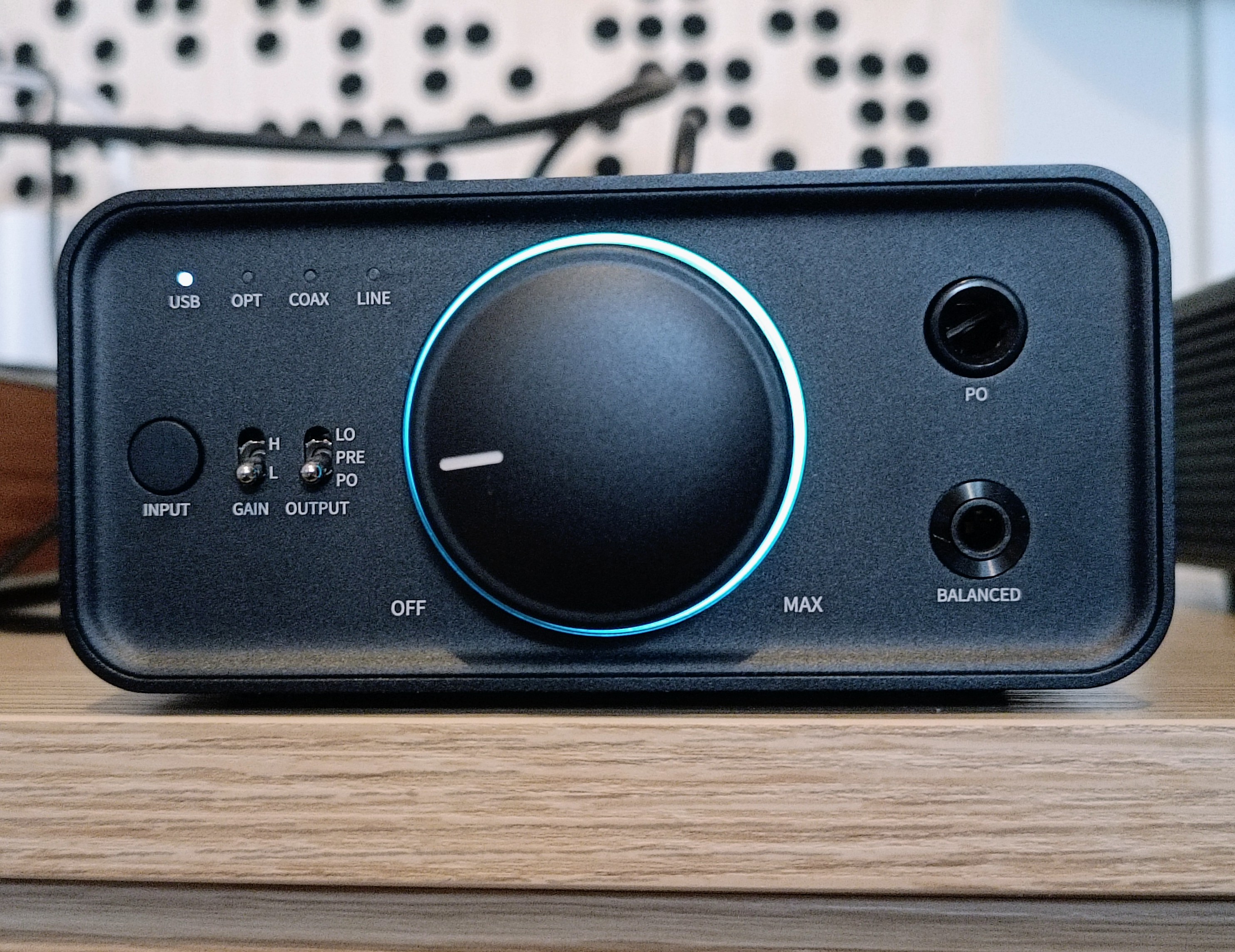
Appearance and build quality
The K7 is just slightly larger than the K5 and it features an all-aluminum alloy construction, carefully finished with CNC and other processes.
It has an excellent build quality and a smooth finish with an elegant black color that is perfectly complemented by the gold accents of the THX and Hi-Res Audio badges.
The circular RGB indicator light is capable of displaying single colors as well as mixed colors, with a unique light flow effect during power on/off or input switching.
Blue for ≤48kHz, yellow for >48kHz and green for DSD.
The K7 will not communicate with the FiiO control application so there is no way to disable or dim the RGB light.

User interface
This is a pretty simple to use DAC/amp with three digital inputs (USB, coaxial and optical), a line level input, a line level output and two headphone outputs.
Except for the volume control knob, that also acts as the on/off switch, there is a button for selecting between the various inputs and two toggle switches, one for setting the gain to high or low and another for selecting the desired output (headphone, line out or pre out).
At the right side of the front face there are located the two headphone outputs, one balanced 4.4mm and another single ended 6.35mm.

Accessories
The K7 comes bundled with an external power adapter, a USB cable and a 6.35mm to 3.5mm adapter.
Associated gear and power output
The K7 can do 1.2W/32Ω from its single ended output, exactly the same as the K5 PRO ESS, while the balanced output is almost doubling to a whole 2W/32Ω.
So it can run pretty much anything except for some exotic headphones and at the same time it is very silent with excellent channel balance.
I have used various earphones to test the performance, like the FiiO FD7, the Penon Vortex and the Meze ADVAR.
A mid gain setting would be nice to have for better headphone matching but I am really nitpicking here.
I did most of my listening tests with the Focal Clear Mg, the HiFiMan Ananda Stealth and the Meze 109 Pro, all of them with pure silver cables made by Lavricables.
As an example of the power output, with the Focal Clear Mg I never needed more than ¾ of the volume range at the low gain setting to get very loud and with excellent driver control while listening to classical music.

Listening impressions
FiiO has a great expertise with the AKM DAC chips and you don't have to listen a lot to the K7 to understand what is really happening.
A perfectly balanced and neutral tuning with a touch of warmness and a more natural timbre than the K5 PRO, make the K7 one of the most musical and engaging sounding FiiO products.
This is the old beloved FiiO house sound with the AKM flavor that I bet that many of you have been missing during the recent switch to the ESS chips.
A DAC that is perfectly capable of a clean and transparent sound with a mirror-like source fidelity but without sounding clinical, artificial or metallic.
The timbre is very natural and realistic, almost analogue-like and quite organic with plenty of harmonic variety and a colorful tonal palette.
The K7 is highly successful in connecting the listener to his favorite music while it offers very good technicalities for the category.

The bass is extended, fast, tight and controlled with excellent definition and clarity while it sounds quite full bodied and weighty, definitely more visceral than the K5 PRO ESS.
It is dynamic and impactful, certainly not that powerful and authoritative as some other DAC/amps with discrete output stages, like the Aune X1S GT or the Yulong Aurora but still very contrasted and definitely satisfying with bass intense music.
The mid-range is open sounding, lucid and sweet with a high quality texture and fine articulation.
The K7 offers plenty of resolution and refinement for the category with a high spirited and energetic treble which is kept smooth and controlled with a minimum digital glare and without harshness despite the excellent clarity and its luminous nature.
The K7 is very versatile and a great match with every headphone and all types of music, from modern electronic stuff to classical.
I have listened to dozens of recordings and I really remained impressed with the consistency of performance, from favorite rock tunes together with the Meze 109 PRO to the highly demanding Bruckner's symphony No.9 with the Focal Clear Mg.

The K7 is surprisingly open sounding with an expansive and quite grand presentation with excellent ambient information and a rather sharp imaging especially from the balanced output.
Single ended vs balanced
The single ended output is excellent sounding and very competitive, you shouldn't be worried at all if you plan to buy the K7 for single ended only use.
But you are still greatly encouraged to upgrade to the balanced, when possible, because it is technically superior, more expansive and articulate with an effortless power delivery that results in a more dynamic and controlled sound with extra headroom.
As a headphone amplifier
Using the line level input and taking the internal DAC out of the equation, the K7 is a very competitive analogue headphone amplifier and preamplifier with great transparency and a sound signature that shares a lot in common with all the characteristics as described above.
A nice option that allows the owner to use an external DAC or a vinyl set-up.
The icing on the cake
I know that spending another $150 to add an LPS to a $200 DAC/amp is a little hard to swallow but trust me that it is worthwhile.
The addition of the FiiO PL50 raises the performance even higher as it makes the most out of the K7 by adding a blacker background that offers deeper detail retrieval.
Additionally you will hear more impactful and contrasted dynamics, fuller and weightier sound with an even more realistic and natural timbre.
No, you don't need the PL50 to really enjoy your K7 but if you manage to get one at some point in the future then you are going to have a system with a performance level that is quite close to much more expensive products like the FiiO K9 PRO.

Compared to the K5 PRO ESS ($209)
The K7 is fuller sounding than the K5 PRO ESS, especially in the bass department but not exclusively so because the whole frequency range is conceived as more intense and weightier.
The timbre is also slightly more realistic in the K7, the sound is a touch more musical and less artificial, it is also more resolving and refined than the K5 PRO ESS with a larger and grander soundstage.
The differences are audible from the single ended output while the balanced raises the bar even higher.
The initial launch price of the K5 PRO ESS was $219 but after the release of the K7 the street price was lowered to $149.
So the K7 is about $50 more expensive but they are not that much when considering that they buy you a slightly better sounding and more versatile product.
In my opinion, the release of the K7 has made the K5 PRO ESS pretty redundant and obsolete, the only reason for buying it is if your budget is really strictly limited.
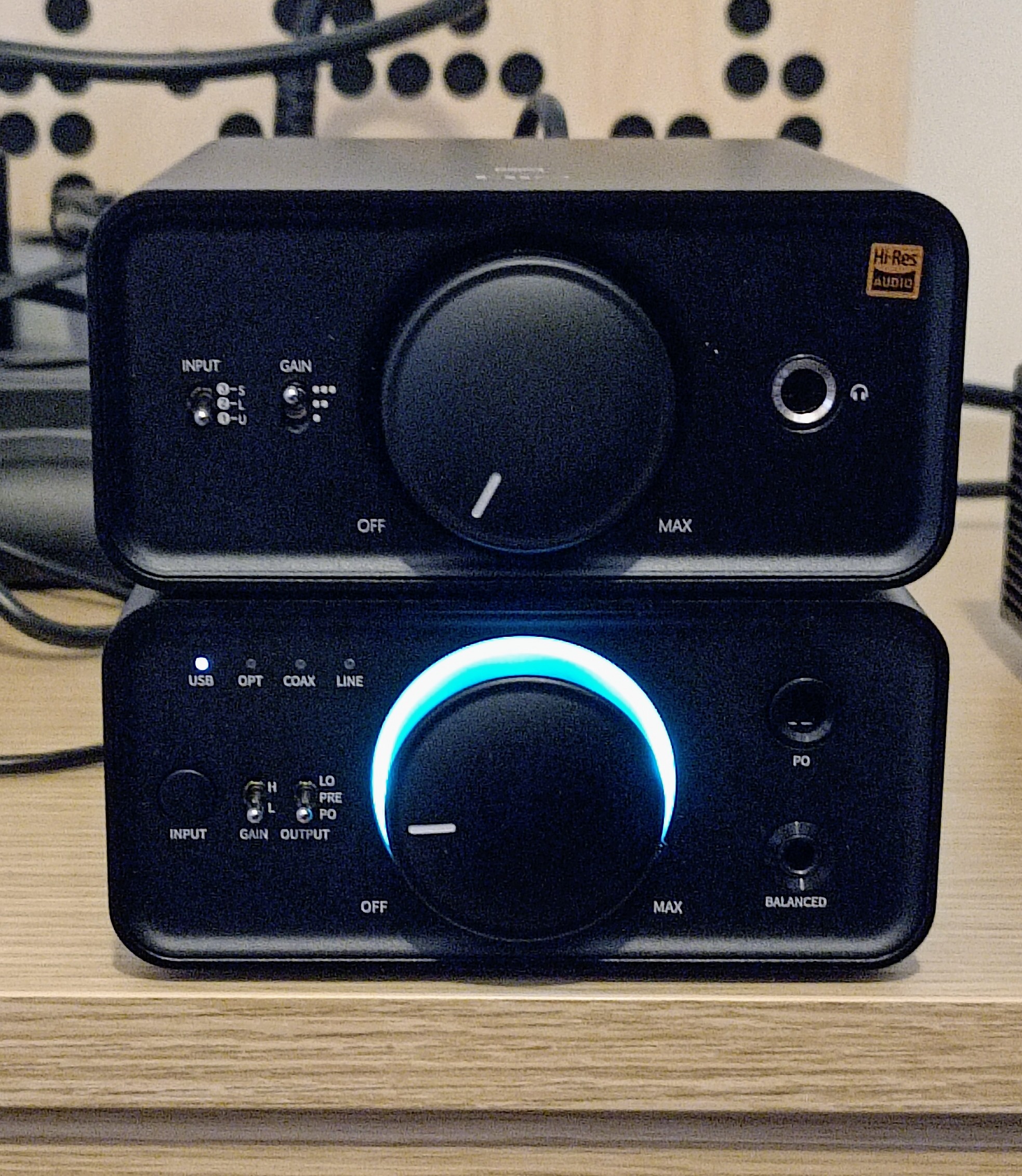
In the end
The release of the K7 marks the return of FiiO back to their roots where everything has started.
The AKM DAC chips, in my opinion, better suit the FiiO house sound and the K7 is the living proof of it.
A bullseye for the company, the K7 is one of the most competitively priced DAC/amps in the market right now and it combines a very musical sound signature with great technicalities, great versatility and excellent power delivery.
FiiO is also preparing a Bluetooth version with a minor price increase.
I am pretty sure that the K7 is going to surpass the K5 PRO in sales and become the most successful and best selling product of FiiO ever.
My only wish now, is that they are back to the drawing board already designing the successor to the K9 PRO with AKM DAC chips.
Test playlist
Copyright - Petros Laskis 2023.
I didn't receive monetary or any other kind of compensation and I don't use affiliate links.
The price of the FiiO K7 is $199.99 and you can buy it from here.

FiiO K7
As always with FiiO we skip the lengthy introductions because they are so well known that they don't need one.
The FiiO K7 is the balanced version of the much acclaimed K5 PRO ESS which is one of the best selling FiiO desktop DAC/amps.
For the K7, FiiO have ditched the ESS chip for two pieces of the new AK4493SEQ DAC chip from AKM which is the newest version of the AK4493.
The FiiO K7 has a six-stage audio circuit with truly balanced analogue and digital sections.
Using two pieces of the same THX AAA 788+ amplifiers as the K9 Pro, the FiiO K7 is capable of outputting 560mW into a 300 Ohm load at 1% distortion and 2000mW into 32 Ohm load at 1% distortion from the balanced output.
The XMOS XUF208 input controller uses dual clock management to handle various audio formats.
The K7 can decode 32-bit 768kHz PCM and DSD512 but there is no MQA support.

The K7 features a power design consisting of multiple independent stages, with the voltage of each stage regulated by low-noise LDOs. Feeding this power design is an external 12V switching power supply. All in all, the K7’s power design supplies plentiful, clean power for an extraordinary listening experience.
Overheating, overload, and DC protection systems ensure that the K7 always operates at its best, so you can always enjoy a worry-free listening experience.
Thanks to its ADC curve reconstruction, the volume potentiometer features 112 smooth steps of adjustable volume free of channel imbalances and noise.

Appearance and build quality
The K7 is just slightly larger than the K5 and it features an all-aluminum alloy construction, carefully finished with CNC and other processes.
It has an excellent build quality and a smooth finish with an elegant black color that is perfectly complemented by the gold accents of the THX and Hi-Res Audio badges.
The circular RGB indicator light is capable of displaying single colors as well as mixed colors, with a unique light flow effect during power on/off or input switching.
Blue for ≤48kHz, yellow for >48kHz and green for DSD.
The K7 will not communicate with the FiiO control application so there is no way to disable or dim the RGB light.

User interface
This is a pretty simple to use DAC/amp with three digital inputs (USB, coaxial and optical), a line level input, a line level output and two headphone outputs.
Except for the volume control knob, that also acts as the on/off switch, there is a button for selecting between the various inputs and two toggle switches, one for setting the gain to high or low and another for selecting the desired output (headphone, line out or pre out).
At the right side of the front face there are located the two headphone outputs, one balanced 4.4mm and another single ended 6.35mm.

Accessories
The K7 comes bundled with an external power adapter, a USB cable and a 6.35mm to 3.5mm adapter.
Associated gear and power output
The K7 can do 1.2W/32Ω from its single ended output, exactly the same as the K5 PRO ESS, while the balanced output is almost doubling to a whole 2W/32Ω.
So it can run pretty much anything except for some exotic headphones and at the same time it is very silent with excellent channel balance.
I have used various earphones to test the performance, like the FiiO FD7, the Penon Vortex and the Meze ADVAR.
A mid gain setting would be nice to have for better headphone matching but I am really nitpicking here.
I did most of my listening tests with the Focal Clear Mg, the HiFiMan Ananda Stealth and the Meze 109 Pro, all of them with pure silver cables made by Lavricables.
As an example of the power output, with the Focal Clear Mg I never needed more than ¾ of the volume range at the low gain setting to get very loud and with excellent driver control while listening to classical music.

Listening impressions
FiiO has a great expertise with the AKM DAC chips and you don't have to listen a lot to the K7 to understand what is really happening.
A perfectly balanced and neutral tuning with a touch of warmness and a more natural timbre than the K5 PRO, make the K7 one of the most musical and engaging sounding FiiO products.
This is the old beloved FiiO house sound with the AKM flavor that I bet that many of you have been missing during the recent switch to the ESS chips.
A DAC that is perfectly capable of a clean and transparent sound with a mirror-like source fidelity but without sounding clinical, artificial or metallic.
The timbre is very natural and realistic, almost analogue-like and quite organic with plenty of harmonic variety and a colorful tonal palette.
The K7 is highly successful in connecting the listener to his favorite music while it offers very good technicalities for the category.

The bass is extended, fast, tight and controlled with excellent definition and clarity while it sounds quite full bodied and weighty, definitely more visceral than the K5 PRO ESS.
It is dynamic and impactful, certainly not that powerful and authoritative as some other DAC/amps with discrete output stages, like the Aune X1S GT or the Yulong Aurora but still very contrasted and definitely satisfying with bass intense music.
The mid-range is open sounding, lucid and sweet with a high quality texture and fine articulation.
The K7 offers plenty of resolution and refinement for the category with a high spirited and energetic treble which is kept smooth and controlled with a minimum digital glare and without harshness despite the excellent clarity and its luminous nature.
The K7 is very versatile and a great match with every headphone and all types of music, from modern electronic stuff to classical.
I have listened to dozens of recordings and I really remained impressed with the consistency of performance, from favorite rock tunes together with the Meze 109 PRO to the highly demanding Bruckner's symphony No.9 with the Focal Clear Mg.

The K7 is surprisingly open sounding with an expansive and quite grand presentation with excellent ambient information and a rather sharp imaging especially from the balanced output.
Single ended vs balanced
The single ended output is excellent sounding and very competitive, you shouldn't be worried at all if you plan to buy the K7 for single ended only use.
But you are still greatly encouraged to upgrade to the balanced, when possible, because it is technically superior, more expansive and articulate with an effortless power delivery that results in a more dynamic and controlled sound with extra headroom.
As a headphone amplifier
Using the line level input and taking the internal DAC out of the equation, the K7 is a very competitive analogue headphone amplifier and preamplifier with great transparency and a sound signature that shares a lot in common with all the characteristics as described above.
A nice option that allows the owner to use an external DAC or a vinyl set-up.
The icing on the cake
I know that spending another $150 to add an LPS to a $200 DAC/amp is a little hard to swallow but trust me that it is worthwhile.
The addition of the FiiO PL50 raises the performance even higher as it makes the most out of the K7 by adding a blacker background that offers deeper detail retrieval.
Additionally you will hear more impactful and contrasted dynamics, fuller and weightier sound with an even more realistic and natural timbre.
No, you don't need the PL50 to really enjoy your K7 but if you manage to get one at some point in the future then you are going to have a system with a performance level that is quite close to much more expensive products like the FiiO K9 PRO.

Compared to the K5 PRO ESS ($209)
The K7 is fuller sounding than the K5 PRO ESS, especially in the bass department but not exclusively so because the whole frequency range is conceived as more intense and weightier.
The timbre is also slightly more realistic in the K7, the sound is a touch more musical and less artificial, it is also more resolving and refined than the K5 PRO ESS with a larger and grander soundstage.
The differences are audible from the single ended output while the balanced raises the bar even higher.
The initial launch price of the K5 PRO ESS was $219 but after the release of the K7 the street price was lowered to $149.
So the K7 is about $50 more expensive but they are not that much when considering that they buy you a slightly better sounding and more versatile product.
In my opinion, the release of the K7 has made the K5 PRO ESS pretty redundant and obsolete, the only reason for buying it is if your budget is really strictly limited.

In the end
The release of the K7 marks the return of FiiO back to their roots where everything has started.
The AKM DAC chips, in my opinion, better suit the FiiO house sound and the K7 is the living proof of it.
A bullseye for the company, the K7 is one of the most competitively priced DAC/amps in the market right now and it combines a very musical sound signature with great technicalities, great versatility and excellent power delivery.
FiiO is also preparing a Bluetooth version with a minor price increase.
I am pretty sure that the K7 is going to surpass the K5 PRO in sales and become the most successful and best selling product of FiiO ever.
My only wish now, is that they are back to the drawing board already designing the successor to the K9 PRO with AKM DAC chips.
Test playlist
Copyright - Petros Laskis 2023.
Last edited:
Syan25
Oh very good. My mind was originally drawn to the K9 pro which uses the ESS chip. But it's just for my office rig. I didn't want to spend that much on the amp. I've got to get a balanced cable for the XS too. I'm impressed you were listening to Bruckner. Huge Bruckner fan here and Sibelius fan. I'm looking forward to listening to classical and soundtracks on here...as well as jazz, fusion etc
Ichos
This is very good for the price, you can save to add later on the FiiO PL50 which is not very expensive but raises the performance.
I have listened to a lot of Bruckner in my youth, I was familiar with every last note, especially in the late symphonies.
I must have listened to every single available commercial recording!
Now that my time is limited I can't afford to listen to a whole symphony, they are too lengthy but I am always tempted by new readings.
I have listened to a lot of Bruckner in my youth, I was familiar with every last note, especially in the late symphonies.
I must have listened to every single available commercial recording!
Now that my time is limited I can't afford to listen to a whole symphony, they are too lengthy but I am always tempted by new readings.
shampoosuicide
500+ Head-Fier
Pros: + Superlative sound quality with both low-sensitivity planars and high-impedance dynamic headphones
+ Sonic performance that punches way above its class (and then some)
+ Transparent, clean, accurate, and precise, yet full-bodied, vigorous, and robust
+ Macrodynamics and slam deserve special mention
+ Excellent low-end grip and control
+ Transients are clean, smooth, and incisive; never excessively sharp
+ Sophisticated aesthetics
+ Refined and polished fit and finish
+ Big, smooth, and sturdy volume knob
+ Remarkably low to nearly-undetectable channel imbalance
+ Sonic performance that punches way above its class (and then some)
+ Transparent, clean, accurate, and precise, yet full-bodied, vigorous, and robust
+ Macrodynamics and slam deserve special mention
+ Excellent low-end grip and control
+ Transients are clean, smooth, and incisive; never excessively sharp
+ Sophisticated aesthetics
+ Refined and polished fit and finish
+ Big, smooth, and sturdy volume knob
+ Remarkably low to nearly-undetectable channel imbalance
Cons: + Dead zone between 7 o'clock and a little before 10 o'clock
+ Slow volume ramp up until 1 o'clock
+ Soundstage appears about average
+ Not for listeners seeking a warm, lush, romantic, or tube-like signature
+ Slow volume ramp up until 1 o'clock
+ Soundstage appears about average
+ Not for listeners seeking a warm, lush, romantic, or tube-like signature
Tidal via Roon on Mac > FiiO K7 [ 4.4mm balanced ] > Hifiman Edition XS
Let me make a disclaimer first and foremost that I paid for my K7 out of my pocket. I have never been compensated in any way for any of my reviews or impressions, nor do I intend to go down that route.
My only piece of FiiO source/amplifier gear hitherto was the humble FiiO E10K Olympus some years back. Most recently, my primary DAC/amp was the iFi micro iDSD Signature, then the JDS Element II and JDS Atom stack prior to that, with the iFi ZEN DAC Signature and Gustard H10 and iFi ZEN CAN being my staples for the last year or so. Other amps I've owned that are worth mentioning include the Drop + THX AAA 789, Monolith Liquid Platinum, Schiit Asgard 3, and Schiit Valhalla 2.
Note that I no longer own any of the units mentioned above nor do I have any other sources to conduct a direct comparison with the K7, so do take the following impressions with a reasonable grain of salt.
My first impression of the K7 and the Hifiman Edition XS via the 4.4mm balanced output was: airy, transparent, pristine, clean, refined, effortless, spacious, vibrant, full-bodied, and robust.
By comparison, and from memory, the iFi micro iDSD Signature I most recently owned sounded distinctly softer, mellower, warmer, more intimate, less precise, and less detailed, even with the GTO filter. At the same time, I would not describe the K7's sound as sterile, cool, or limp. It also does not exhibit the flatness and two-dimensional presentation of the JDS Atom, the sometimes overtly analytical and lean character of the THX AAA 789, or the compressed and strained quality of the Topping gear I've owned and auditioned (namely the Topping G5 and NX4).
I'm in the honeymoon phase at the moment to be sure, but the K7 seems to quite remarkably combine the effortlessness and naturalness of the iFi house sound with the precise and pristine quality of the Drop + THX AAA 789 and JDS Atom, the spaciousness and expansiveness of the Gustard H10, while injecting a healthy dose of vibrancy and robustness of its own all at once. Keep in mind, however, if you are seeking the warm, lush, romantic, or tube-like sound that is so sought after, you will not find it in the K7.
As for tangibles, build quality is solid with excellent fit and finish, and the volume pot is smooth, sturdy, with a pleasant amount of resistance. My main nitpicks so far are the dead zone on the volume pot between 7 o'clock and a little before 10 o’clock, along the slow initial ramp up in volume before 1 o’clock, and its relatively large footprint.
These are early impressions, and time will tell how they hold up in terms of quality control and if the magic sustains itself. For now, colour me very impressed.
Update - 15 December 2022
Tidal via Roon on Mac > FiiO K7 [ Single-ended ] > Beyerdynamic DT 150
Now with a high-impedance dynamic, the Beyerdynamic DT 150.
Again, as with the Edition XS: pristine, clean, open, transparent, vibrant, with excellent low-end control and grip.
I don’t recall ever hearing the DT 150 sound this detailed, open, transparent, and precise—not out of the iFi ZEN CAN balanced, not out of the Gustard H10, not out of the JDS Element II or the JDS Atom stack, and not out of the iFi micro iDSD Signature.
One of my main quibbles with the DT 150 with stock pads is that its low-end could often sound boomy and overblown and it could get congested on busy tracks—not so with the K7.
I had my doubts for a while with the iFi micro iDSD Signature and JDS Element II, but boy does the DT 150 scale with the K7.
Update - 29 December 2022
Further thoughts
Tidal via Roon on Mac > FiiO K7 [ Balanced ] > Beyerdynamic DT 150 / Hifiman Edition XS
- Transients are clean, smooth, and incisive; never excessively sharp
- Excellent low-end grip and control
- Macrodynamics and slam deserve special mention
- Soundstage seems about average upon further listening
- Tonality: Neither tube-like, warm, organic, or analog, nor analytical, cool, and lean. I’d characterise it as clean, accurate, precise, full-bodied, vigorous, and robust, with excellent control. It’s a modern sound, all things considered, but without being sterile, limp, or lifeless or plagued by digititus.
Last edited:
holsen
I think I'll get me one!
Thanks for the original review and the updates. I've only got IEMs and was ready to go the Burson route but that's likely over-kill.
Thanks for the original review and the updates. I've only got IEMs and was ready to go the Burson route but that's likely over-kill.
D
DewanPretorius
Could I ask if there's any way to use a tube amp as a pre amp or pass through in some way or another with the fiio k7? Thanks a bunch
Moonstar
100+ Head-Fier
Pros: Natural, Clean & Dynamic Presentation,
Pairs pretty well with both Sensitive IEM’s & Power Hungry Headphones,
Hardware Features (THX AAA-788+ Amplifier Section, AK4493SEQ, etc.),
Wide variety of Input & Output Options,
Size, Build Quality & RGB Indicator,
Excellent Value for your Money
Pairs pretty well with both Sensitive IEM’s & Power Hungry Headphones,
Hardware Features (THX AAA-788+ Amplifier Section, AK4493SEQ, etc.),
Wide variety of Input & Output Options,
Size, Build Quality & RGB Indicator,
Excellent Value for your Money
Cons: No MQA Decoding,
Wireless Connectivity options (Wi-Fi and/or Bluetooth) would be welcome
Wireless Connectivity options (Wi-Fi and/or Bluetooth) would be welcome
FiiO K7 DAC & Headphone Amplifier Review
Introduction:
The K7 is FiiO’s latest true balanced desktop DAC & Headphone Amplifier that comes with some interesting specs such like a Dual AK4493SEQ DAC Chip setup, 2x THX AAA 788+ amplifiers, XMOS USB receiver and NJU72315+OP Volume chips. Moreover, the device features USB, Optical, Coaxial, RCA inputs and both 6.35mm Single-Ended + 4.4mm Balanced analog output interfaces.
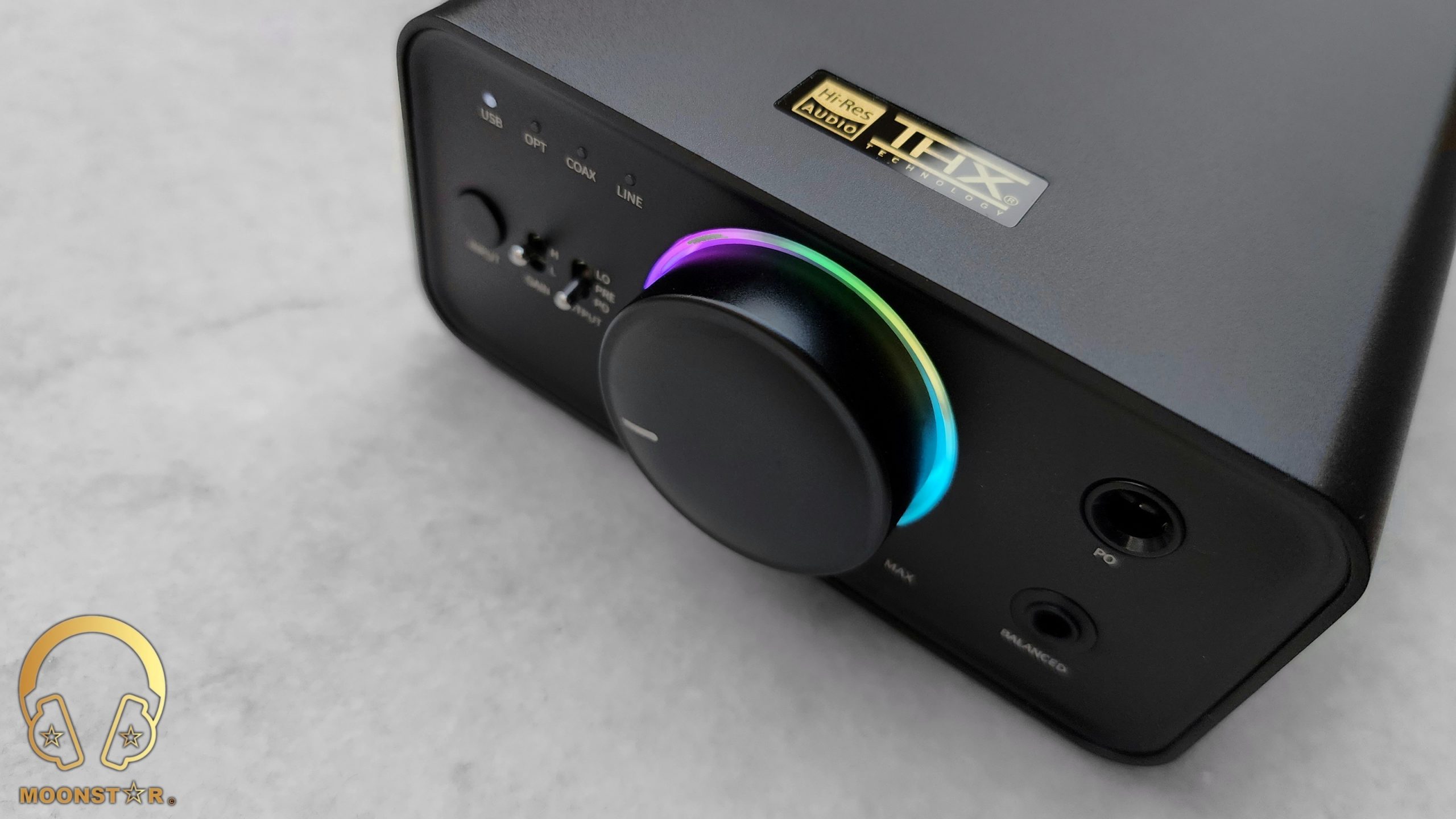
Disclaimer:
I would like to thank FiiO for providing me the K7 DAC & Headphone Amplifier as review sample. I am not affiliated with FiiO beyond this review and these words reflect my true and unaltered, opinions about the product.
Price & Availability:
The FiiO K7 is a quite reasonable priced Headphone DAC/Amplifier that is actually available for 199.99 US$. More information’s can be found under the link below;
Package & Accessories:
The FiiO K7 came inside a square shaped black box that was wrapped with a cardboard sleeve that has a fancy design that sport the illustration and some product related brandings with an iridescent finish on its surface.

The box of the K7 contains the following items:
- 1 x FiiO K7 Desktop Headphone DAC/Amplifier
- 1 x USB-A to USB-B cable
- 1 x Power Cable
- 1 x Power Adapter
- 1 x User Manual & Warranty card
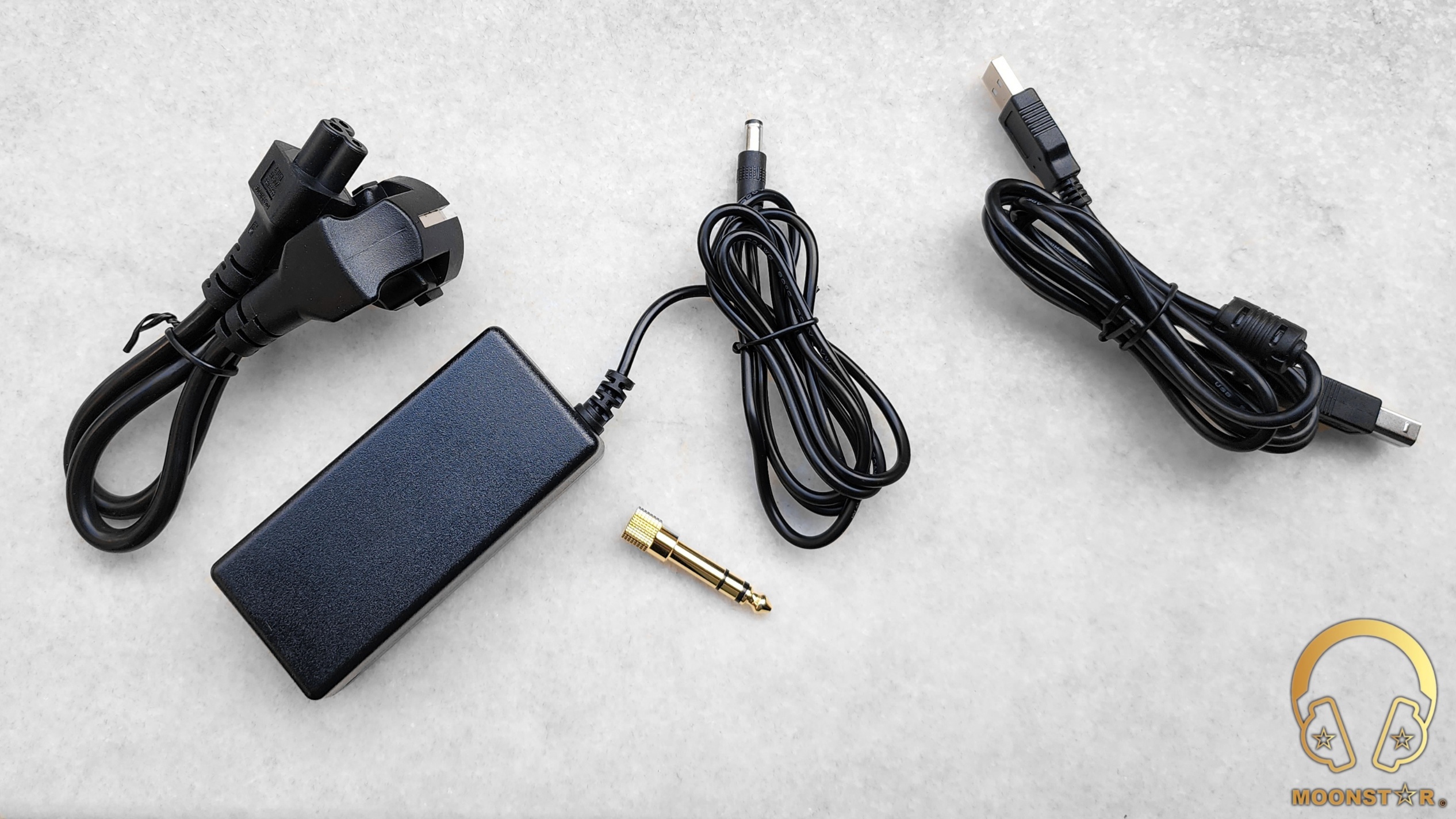
Design & Build Quality:
The FiiO K7 is the company’s latest true balanced desktop type DAC & Headphone Amplifier that features a pretty robust CNC machined Aluminum body with a black finish. The K7 is equipped with multiple input, output and control interfaces that are located on the front and rear side of the device. The device has dimensions of about 120 x 168 x 55mm and weights approx 610grams.
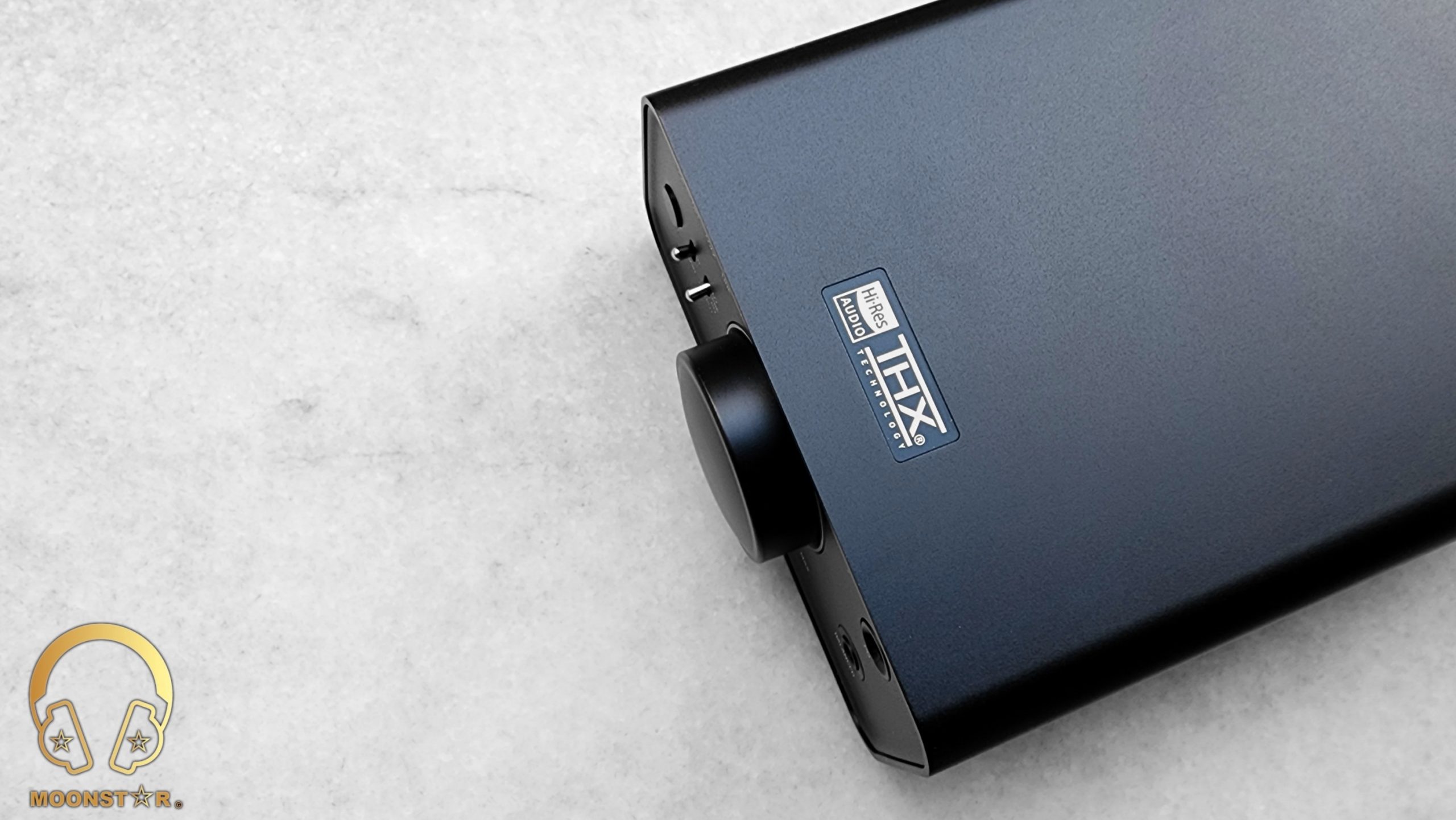
On the top of the device are the FiiO brand logo and a label with the Hi-Res Audio & THX Technology branding.
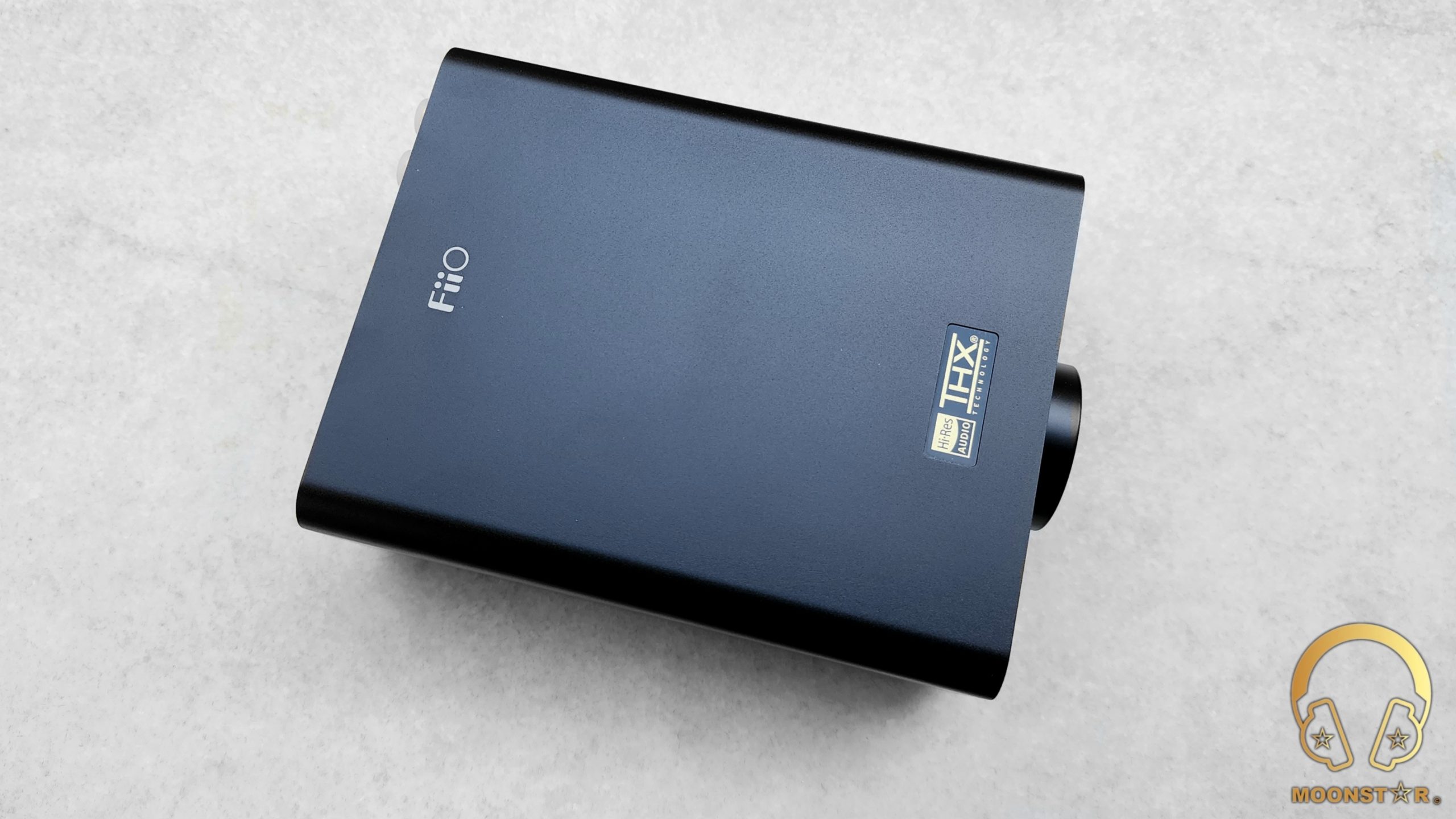
The front panel of the K7 is equipped with the analog outputs and multiple control tools such like buttons, potentiometers and switches.
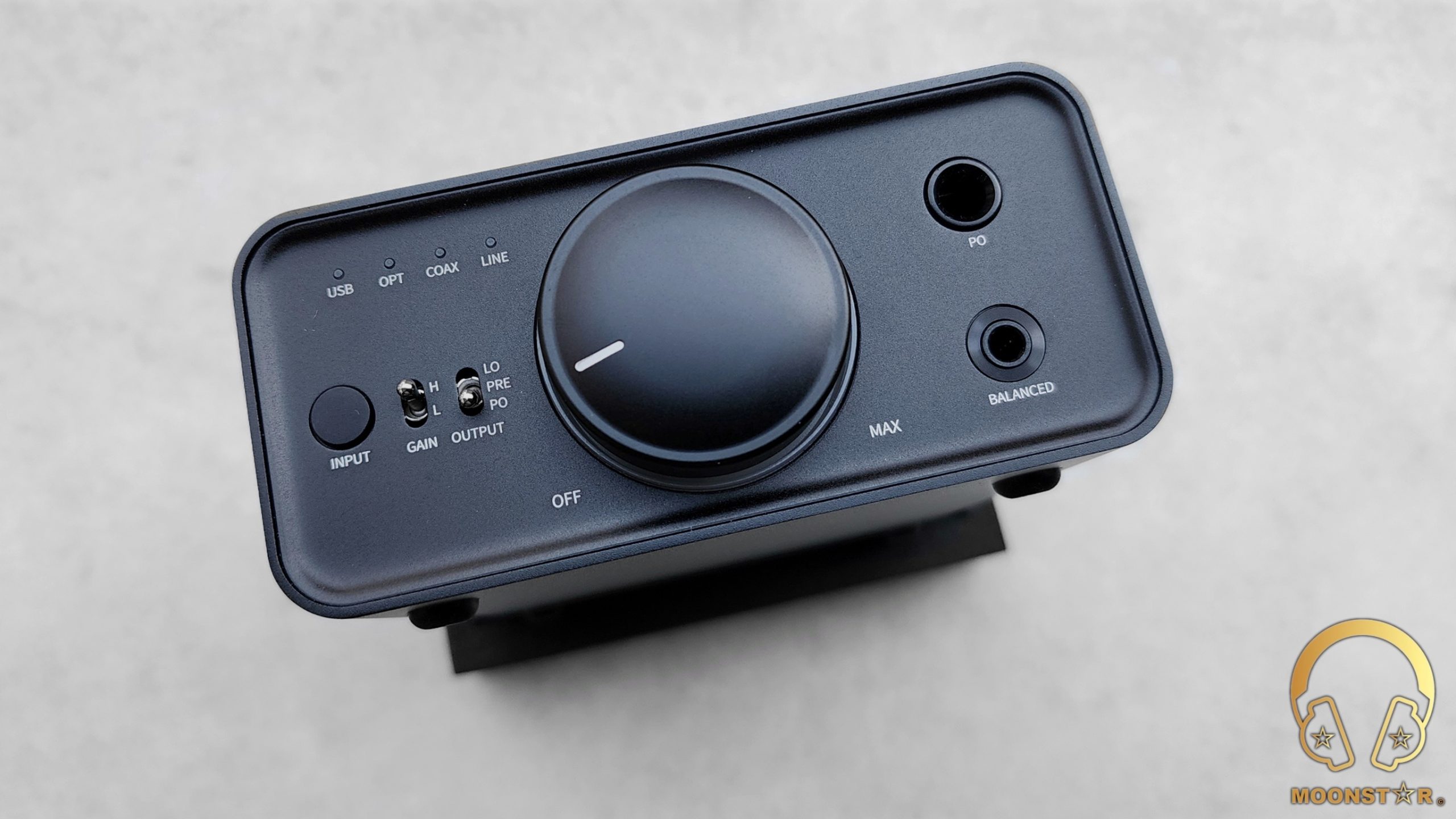
The right side of the front panel features the 6.35mm Single Ended and 4.4mm Balanced headphone outputs.
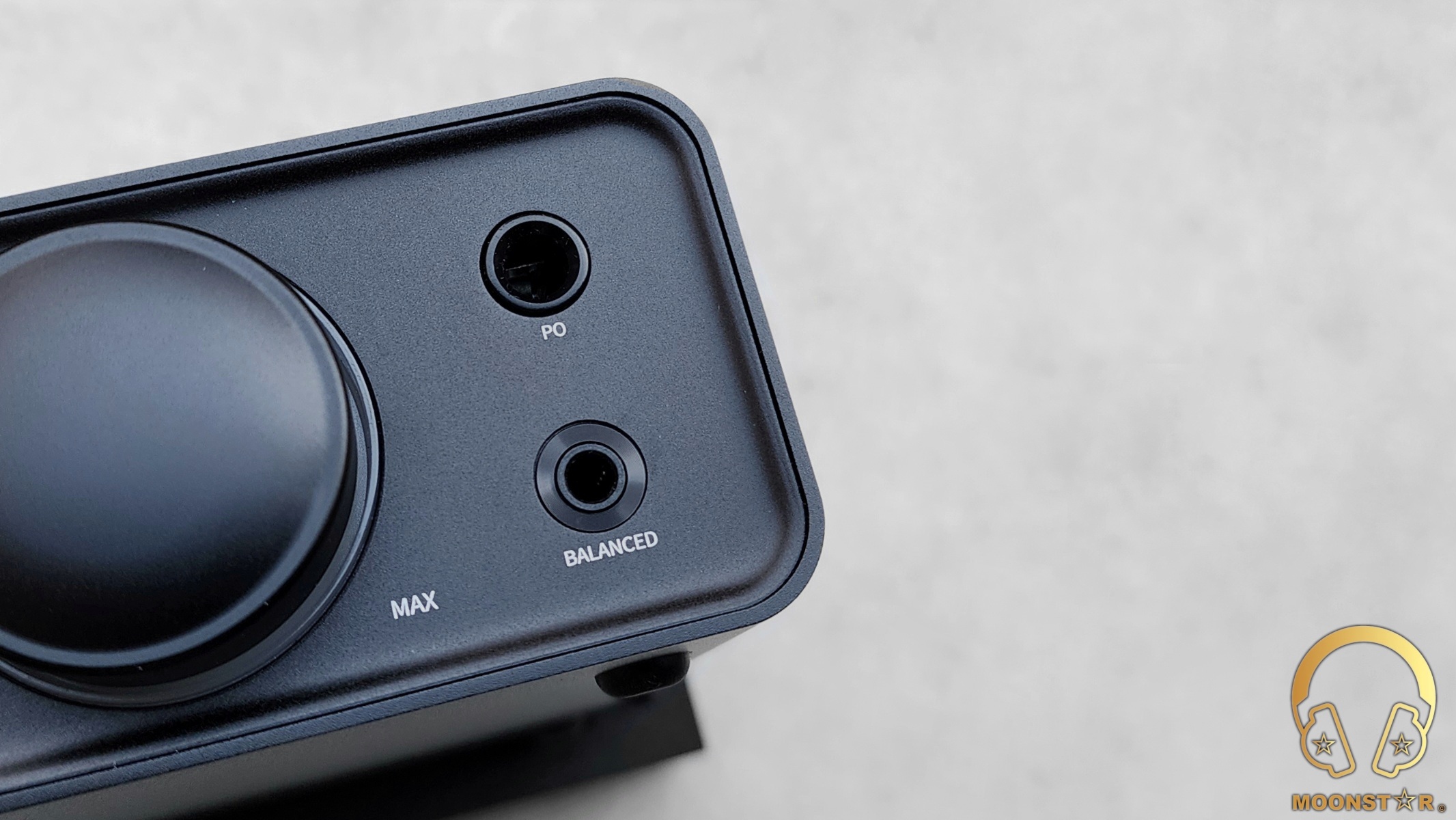
The center of the front panel is equipped with a volume wheel/potentiometer that sports a fancy looking RGB status indicator in form a ring that glows up in various colors depending of the codec and operating status of the device.
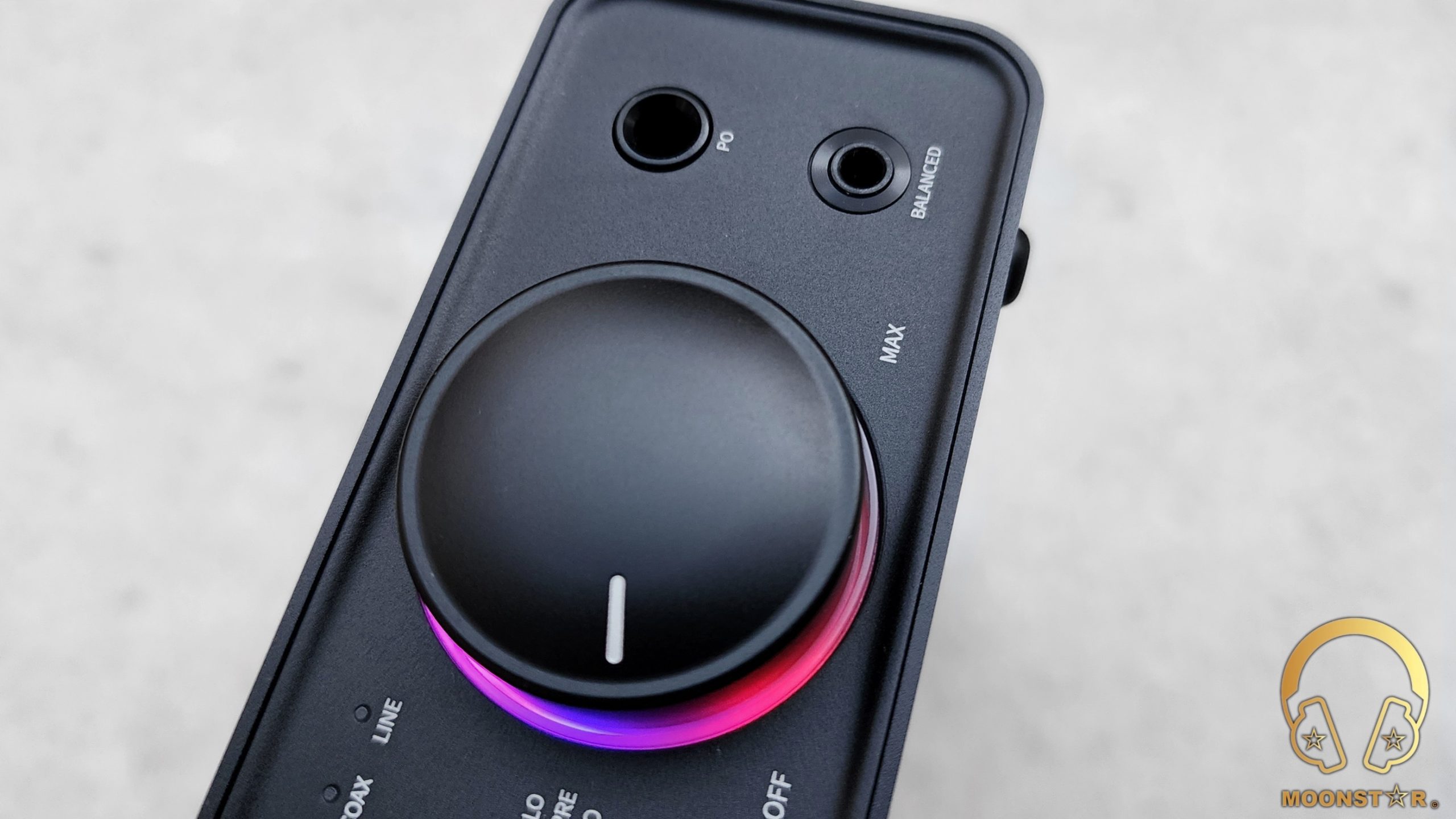
The left side of the front panel sports an input button and 4 LED indicators that give you information about the actual selected source. Moreover, here are two witches one for High/Low gain and one to select the output.
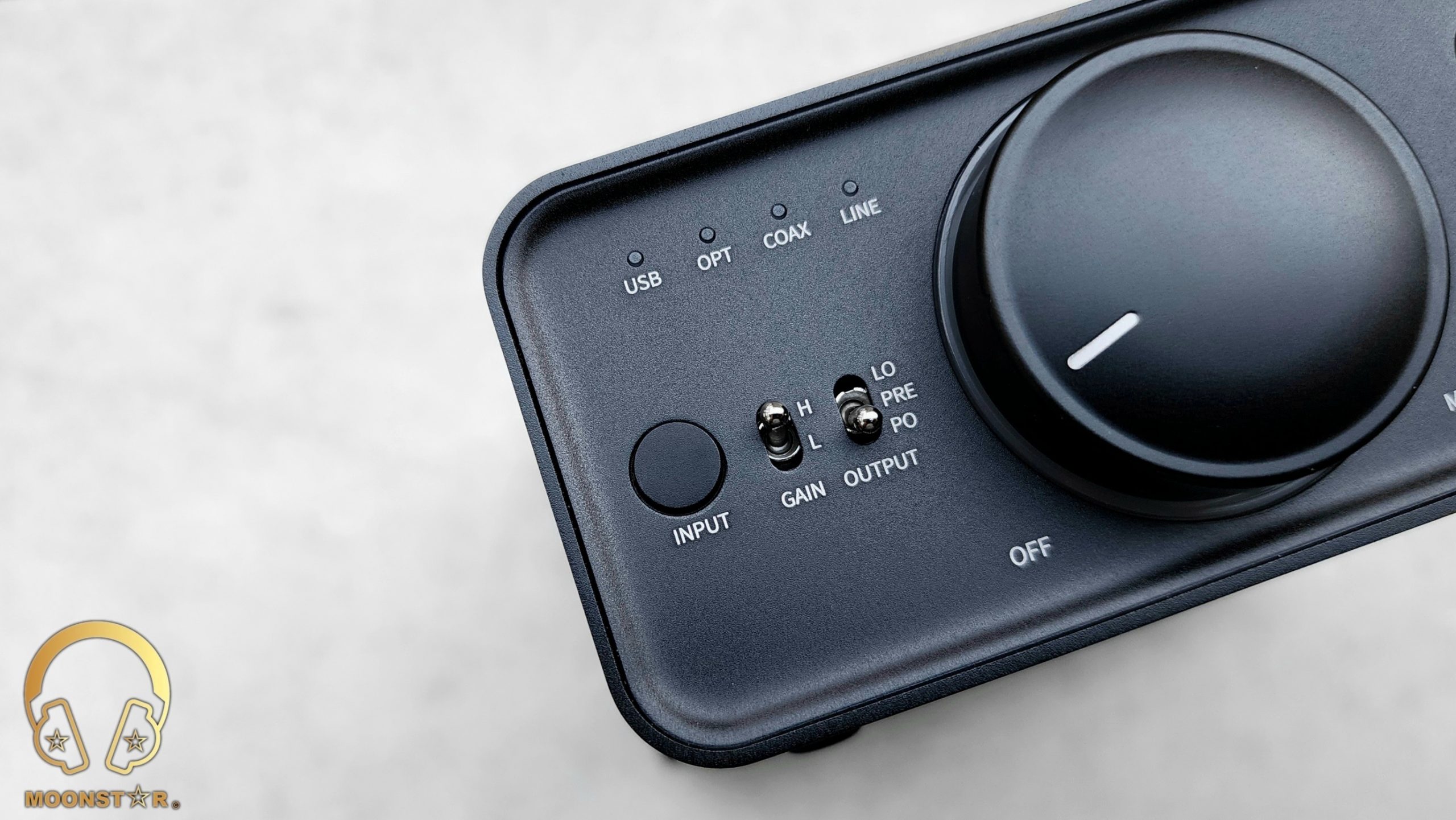
The rear panel of the K7 features a Single Ended Line-In, USB Type-B, Optical (Toslink), Coaxial Inputs and Single-Ended output interface. Here is also the power input of the device.
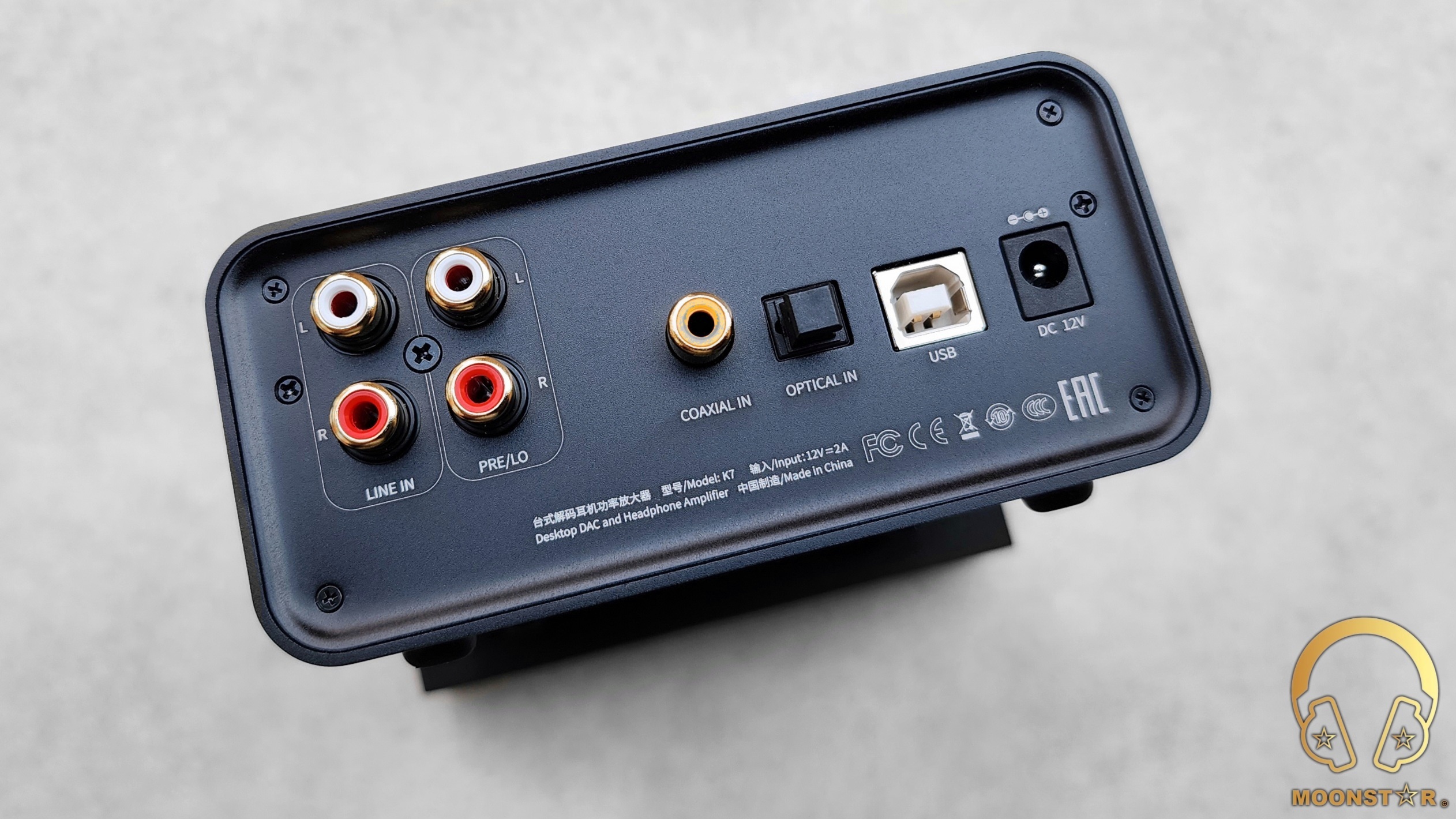
The overall build quality of the K7 meets my expectations from a devices at this price level same like other FiiO products.
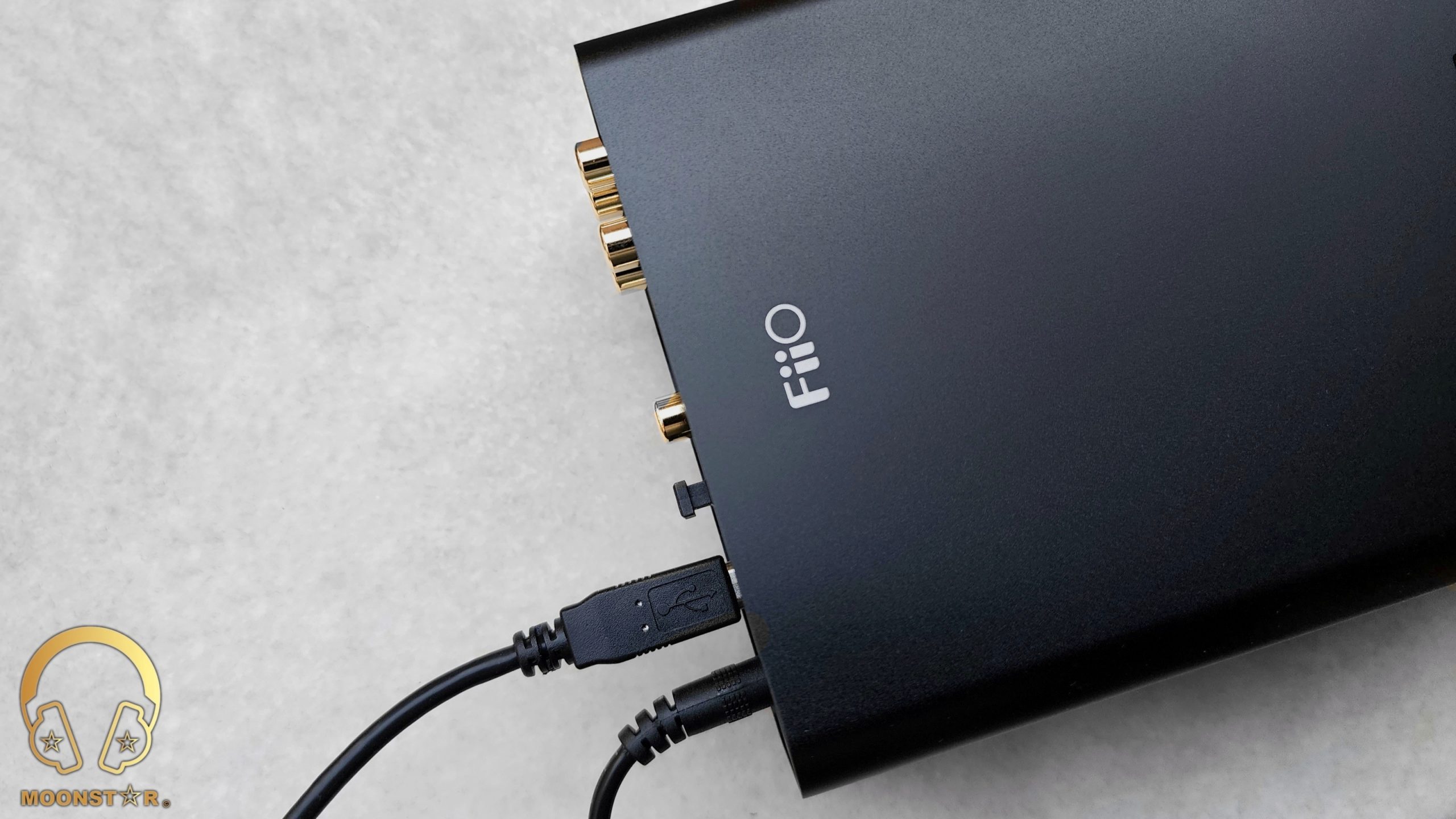
Specifications:
- Model : K7
- DAC : AK4493SEQ x2
- Decoder : XMOS XUF 208
- Amplifier : Dual THX AAA 788+
- Volume Chips : NJU72315+OP
- Outputs : 6.35mm Single-Ended + 4.4mm Balanced
- Inputs : USB, Optical, Coaxial, RCA
- 6.35mm SE Output : up to 1220mW @ 32Ω / 140mW @ 300Ω
- 4.4mm BAL Output : up to 2000mW @ 32Ω / 560mW @ 300Ω
- SNR : >120dB (A-weighted, UAC)
- Noise floor : PO<4.1uV
- THD+N : <0.0003% (1 kHz/32Ω/dbA)
- Output impedance : <1Ω
- Dimensions : 120 x 168 x 55mm
- Weight : 610g
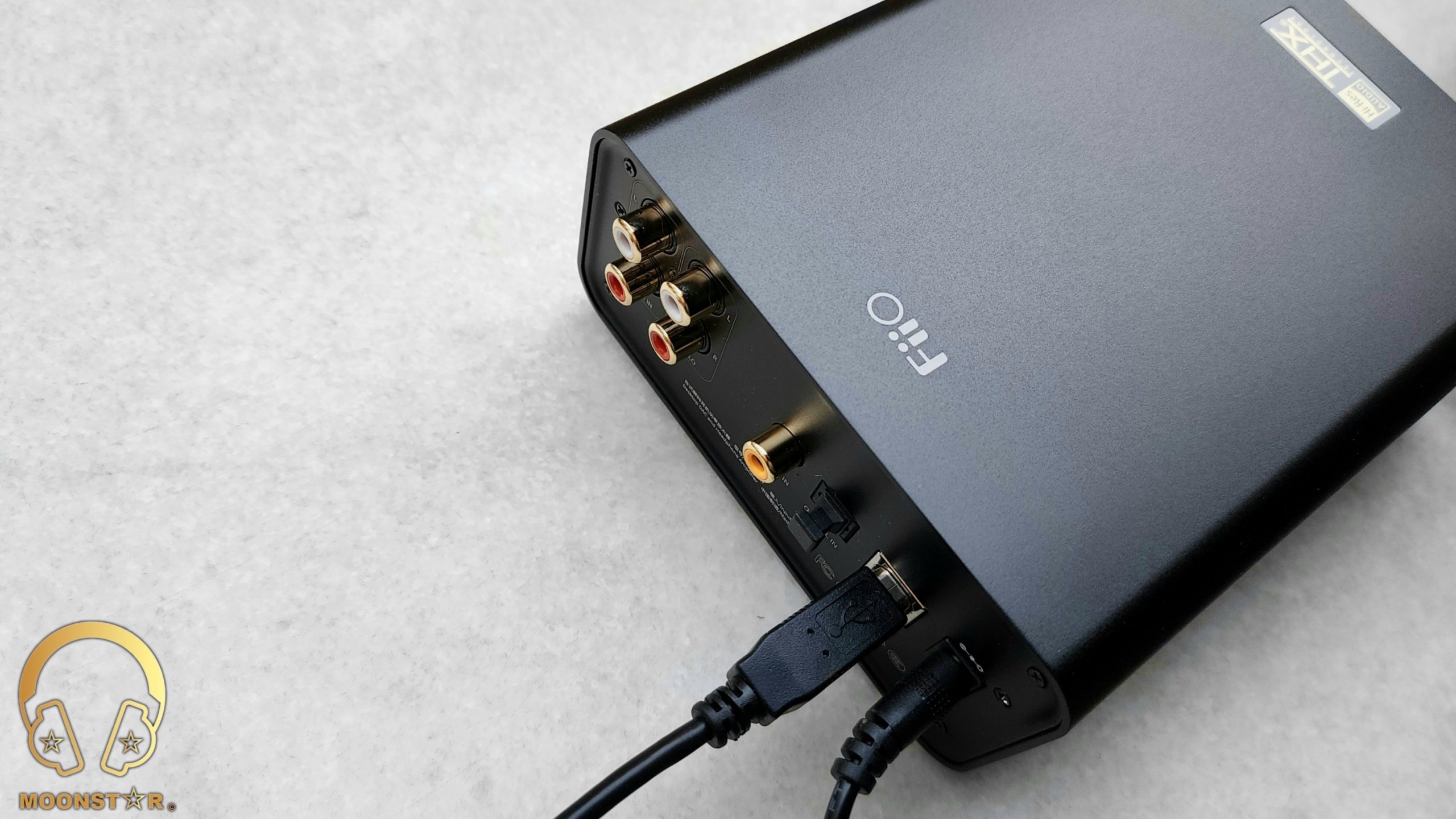
Hardware Features:
The FiiO K7 is a desktop DAC & Headphone Amplifier that features some interesting hardware specs such like a Dual AK4493SEQ DAC Chip setup, 2x THX AAA 788+ amplifiers, XMOS USB receiver and NJU72315+OP Volume chips.
AK4493SEQ DAC Chip:
The FiiO K7 is equipped with 2x AK4493SEQ DAC Chips of the company Ashai Kasei for its true balanced architecture. The AK4493SEQ is a high-performance 32-Bit Digital to Analog converter designed for audiophile-grade applications such as Digital Music players, Portable and Desktop type DAC’s and DAC/Amplifiers.
The AK4493SEQ inside the K7 offers a SNR (Signal to Noise Ratio) value of 120dB (A-weighted, UAC) and THD+N <0.0003% (1 kHz/32Ω/dbA).
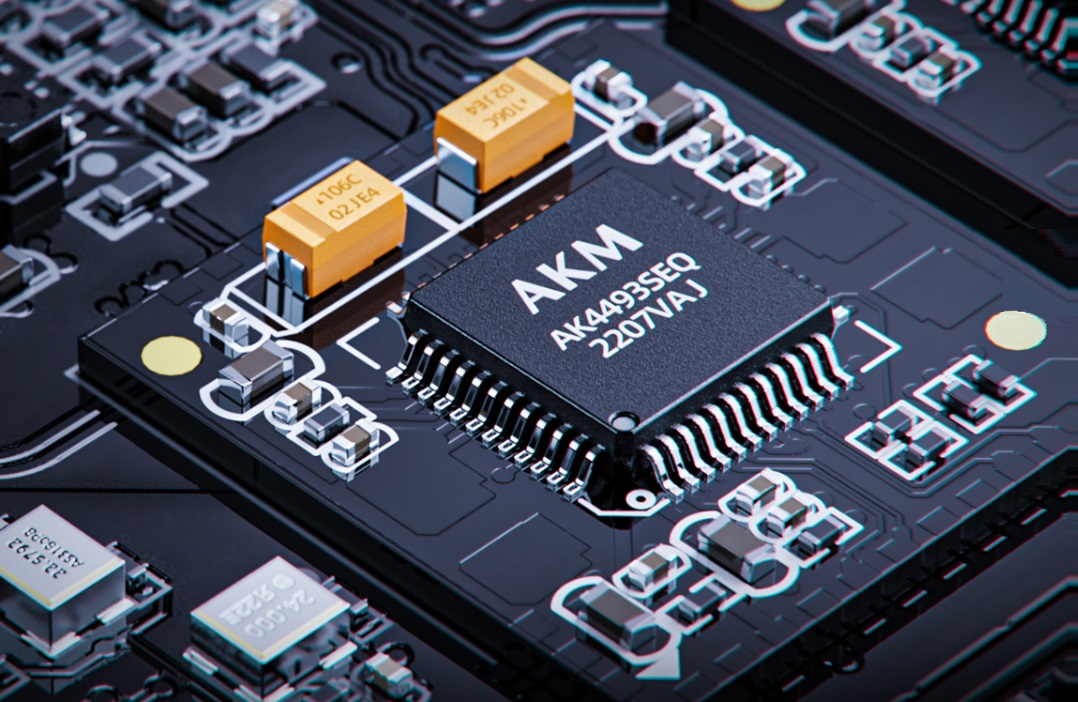
Analog Outputs & Amplification (2x THX AAA 788+):
The FiiO K7 is a quite powerful amplifier with a true balanced architecture, which means that each channel is driven independently. The K7 is equipped with both a 6.35mm Single-Ended and 4.4mm Balanced 3.5mm Single Ended (TRS) and 4.4mm Balanced (TRRRS) balanced outputs.
Another remarkable feature of the K7 is its THX AAA™ “Achromatic Audio Amplifier” design that was used to create a clean and powerful analog output. The K7 is able to create up to 1220mW per channel @ 32ohm over the 6.35mm Single-Ended output, while the 4.4mm Balanced out is even more powerful with up to 2000mW @ 32Ω and 560mW @ 300Ω, all with just 1% distortion, which is quite impressive.
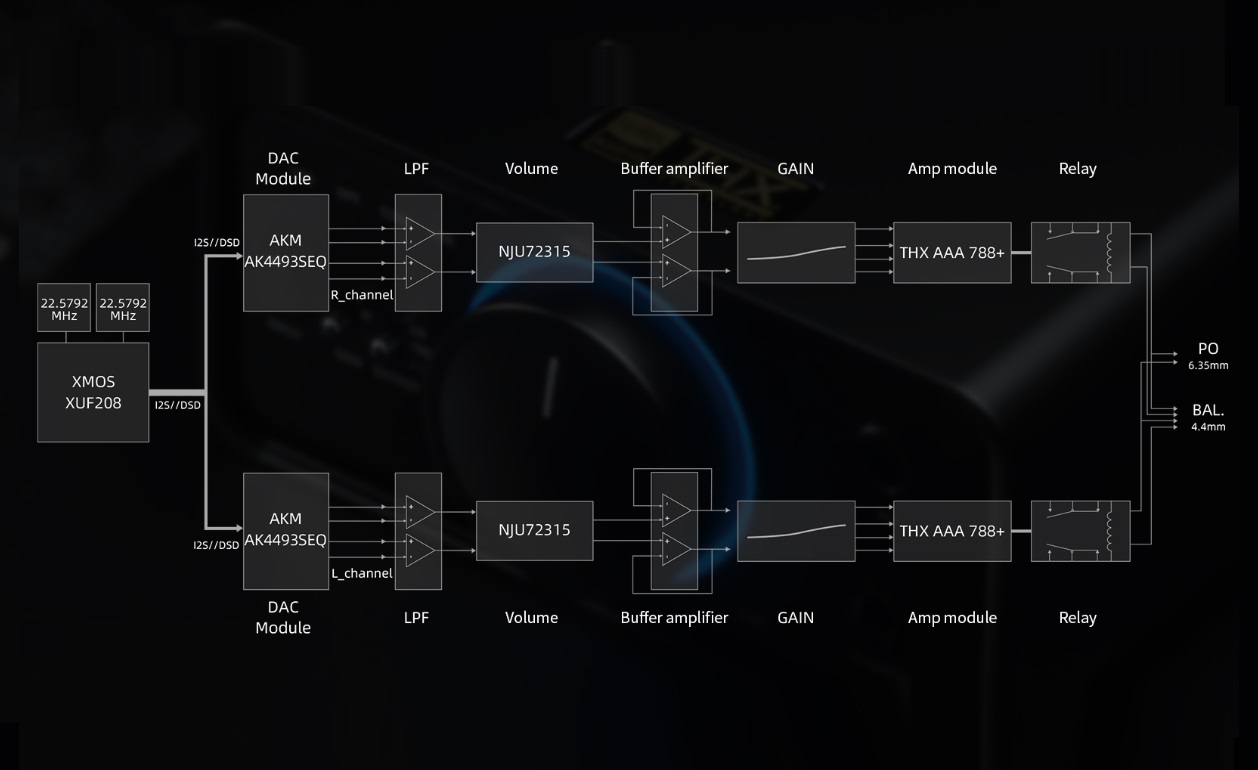
Here are some detailed Audio Parameters:
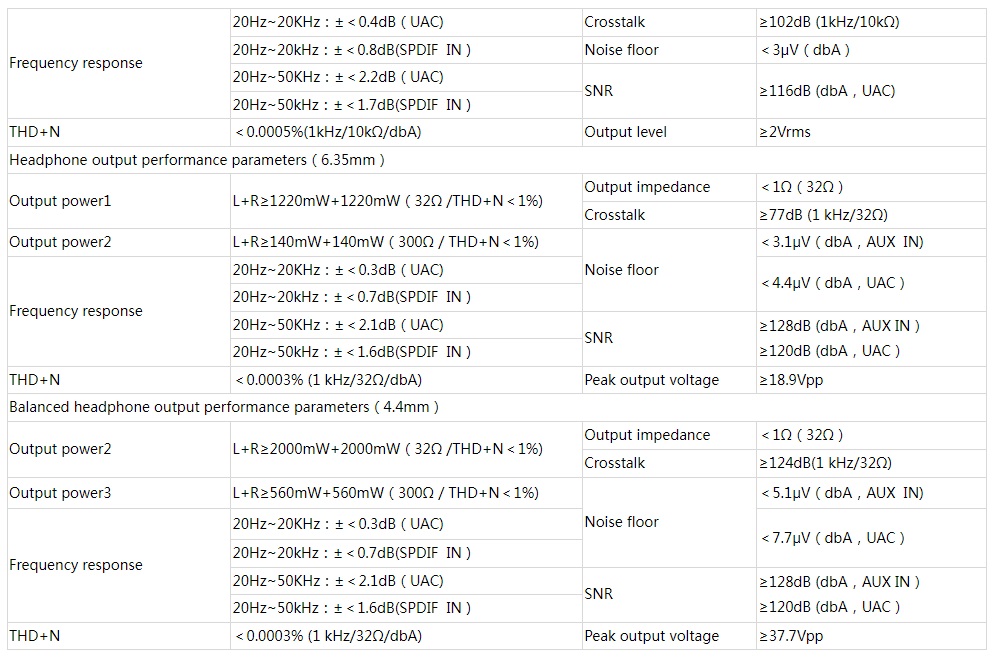
XMOS XU208 for Native DSD:
The FiiO New K7 is equipped with the XMOS XUF208 decoder chip that uses dual clock management in order to handle various music formats. XUF208 USB chip handles up to 384kHz-32bit PCM and Native DSD decoding up to DSD256 in USB DAC Mode.
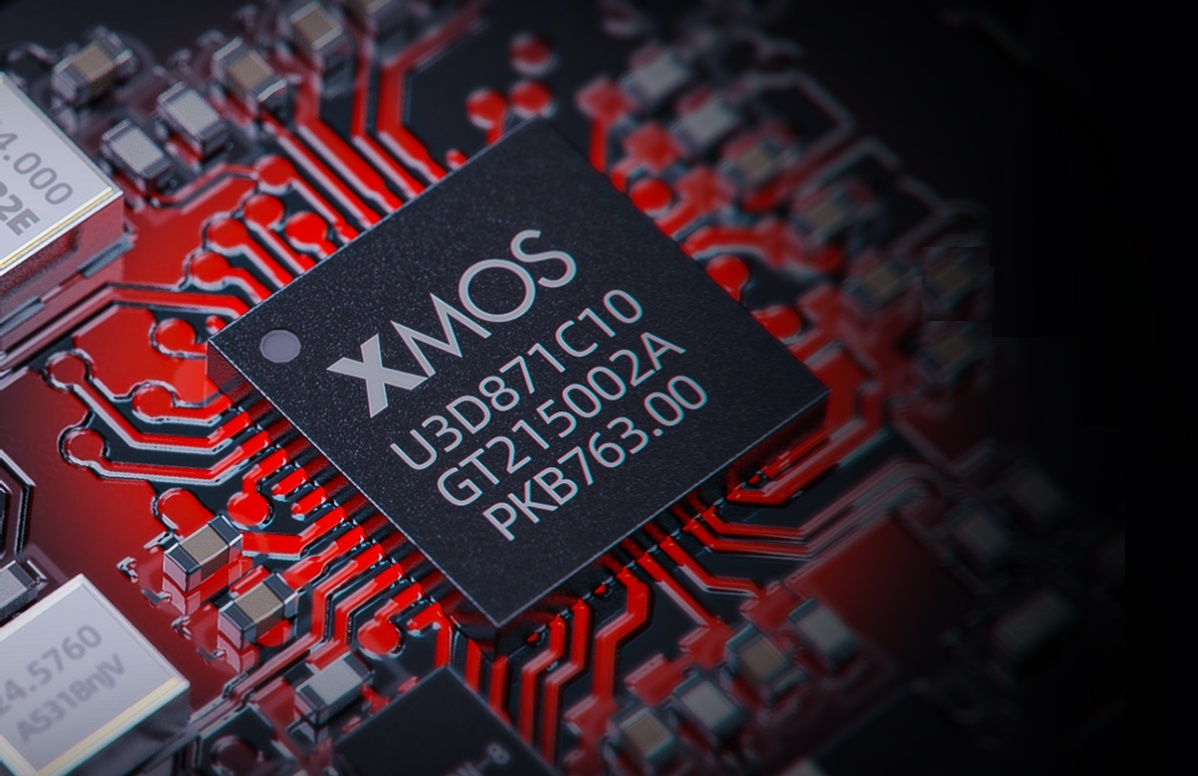
The RGB LED Indicator that surrounds the Potentiometer shows up the following sampling rates:
- Blue : 44.1KHz/48KHz
- Yellow :88.2/96/176.4/192/352.8/384KHz
- Green :DSD64/128/256

Low-Noise Power Supply:
The K7 features a power design consisting of multiple independent stages, with a voltage of each stage being regulated by low-noise LDO’s. Feeding this power design is an external 12V switching power supply.
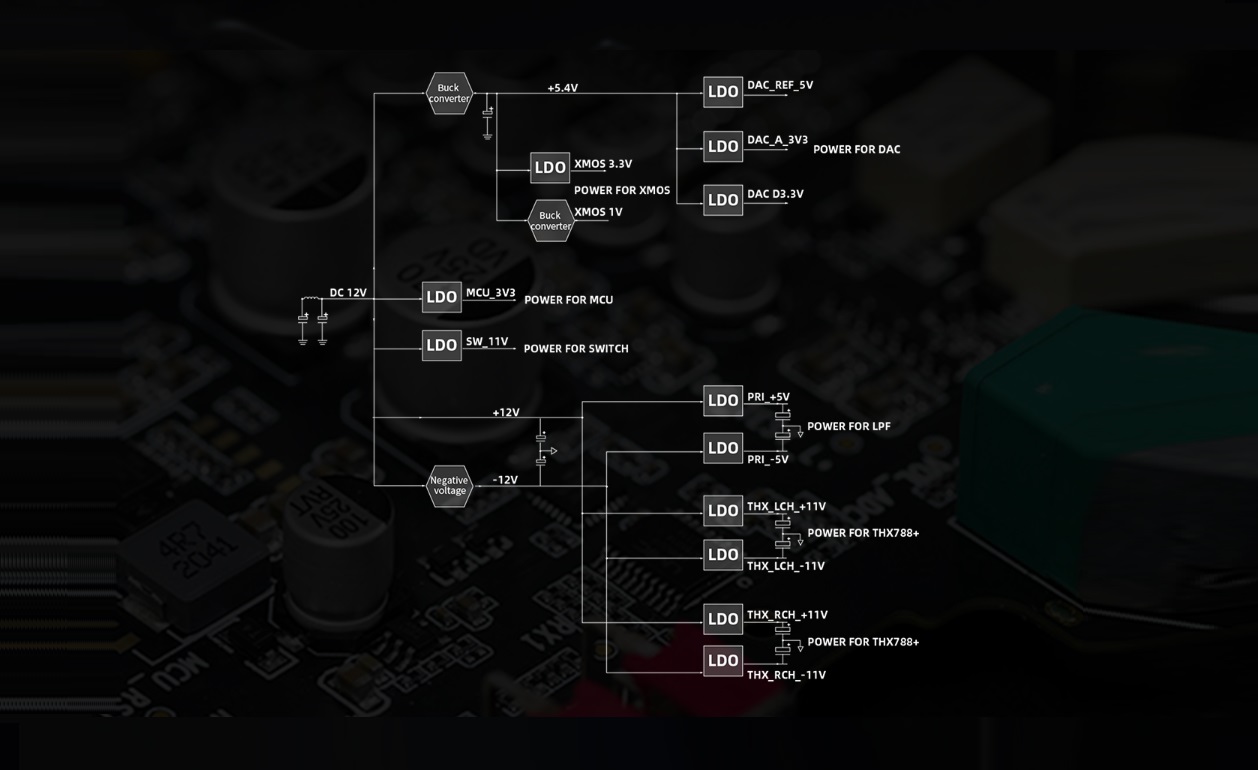
Equipment’s used for this review:
- DAC/Amplifier’s : FiiO K7
- Sources : ASUS TUF FX504GD
- IEM’s : FiiO FH9, FiiO FH7S, Meze Audio RAI Penta
- Headphones : HiFiMAN Sundara Closed-Back, HiFiMAN Edition XS
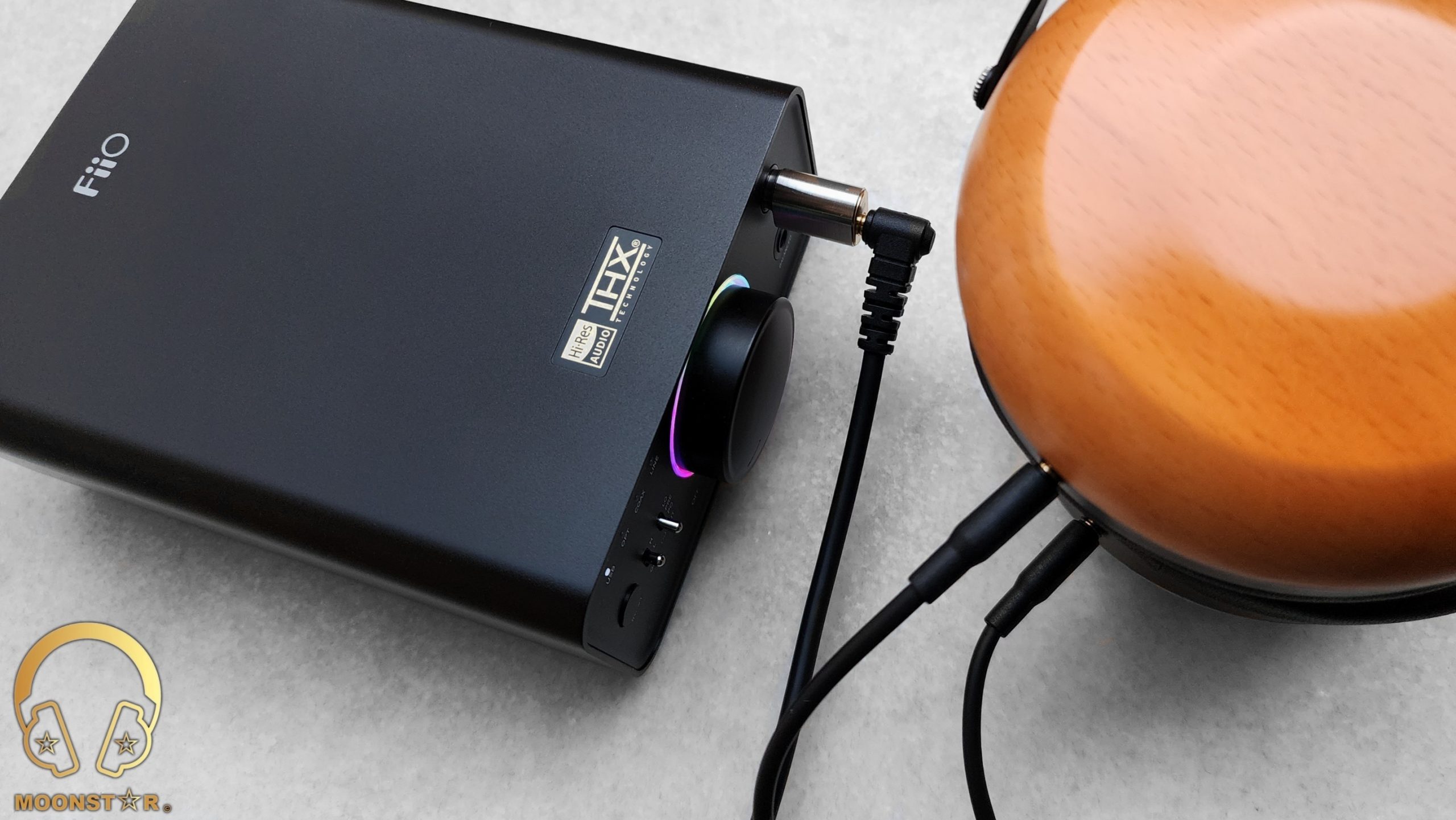
Albums & tracks used for this review:
- Adele – My Little Love (Dezzer HiFi)
- Randy Crawford – On Day I Will Fly Away (Flac 16bit/44.1kHz)
- Hayley Westenra – Odyssey Album (Dezzer HiFi)
- Dionne Warwick – Walk On By (Flac 16bit/44.1kHz)
- Sarah McLachlan – Angel (Flac 24bit/48kHz)
- Sertap Erener – Aşk (Flac 16bit/44.1kHz)
- Edith Piaf – Non Je Ne Regrette Rien (Flac 16bit/44.1kHz)
- Diana Krall – So Wonderful (DSF)
- Aretha Franklin – I Say A Little Payer (Flac 24bit/96kHz)
- Sonya Yoncheva – (Giuseppe Verdi) II Trovatore, ActI (Flac 24bit/96kHz)
- George Michael – Don’t Let the Sun Go Down on Me (Flac 24bit/192kHz)
- David Bowie – Heroes (Flac 24bit/192kHz)
- Elton John – Rocket Man ((Flac 24bit/96kHz)
- Barry White – Just The Way You Are (Flac 24bit/48kHz)
- Isaac Hayes – Walk On By (Flac 16bit/44.1kHz)
- Sting – Englishman in New York – (Flac 24bit/48kHz)
- Eric Clapton – Wonderful Tonight (Flac 24bit/96kHz)
- B. King – Riding With The King (Tidal Hi-Fi)
- Dave Gahan – Kingdom (Tidal Hi-Fi)
- U2 – Sunday Bloody Sunday (Flac 16bit/44.1kHz)
- Bro Safari, UFO! – Drama (Deezer HiFi)
- Armin Van Buuren – Vini Vici (Flac 16bit/44.1kHz)
- Daft Punk – Doin’ it Right (Flac 24bit/96kHz)
- Jo Blankenburg – Meraki (Spotify)
- Lorde – Royals (Flac 24bit/48kHz)
- Massive Attack – Angel (Flac 24bit/48kHz)
- Toutant – Rebirth (Deezer HiFi)
- Gogo Penguin – Raven (Flac 24bit/192kHz)
- Gogo Penguin – Murmuration (Flac 24bit/192kHz)
- Portishead – It Could Be Sweet (Spotify)
- Max Richter – On the Nature of Daylight (Flac 24bit/96kHz)
- Charly Antolini – Duwadjuwandadu (Flac 24bit/192kHz)
- Ferit Odman – Look, Stop & Listen (Flac 24bit/192kHz)
- Chopin – Nocturn No. 20 In C-Sharp Minor (Flac 16bit/44.1kHz)
- Fazıl Say – Nazım Oratoryosu (Live) (Flac 16bit/44.1kHz)
- Vivaldi – Le QuarttroStagioni “The Four Season” (Deezer HiFi)
- Otto Liebert & Luna Negra – The River (Flac 24bit/192kHz)
- Lunatic Soul – The Passage (Flac 16bit/44.1kHz)
- Deftones – My Own Summer (Shove it) (Flac 16bit/44.1kHz)
- Metallica – Sad but True (Flac 24bit/96kHz)
- Metallica – Master of Puppets (Flac 24bit/96kHz)
- Opeth – Windowpane (Flac 16bit/44.1kHz)
- Megadeth – Sweating Bullets (Tidal Hi-Fi)
- Rush’s – Leave That Thing Alone (Flac 16bit/44.1kHz)
- Slayer – Angel of Death (Spotify)
- Liquid Tension Experiment 2 – Acid Rain (Spotify)
- Yosi Horikawa – Bubbles (Spotify)
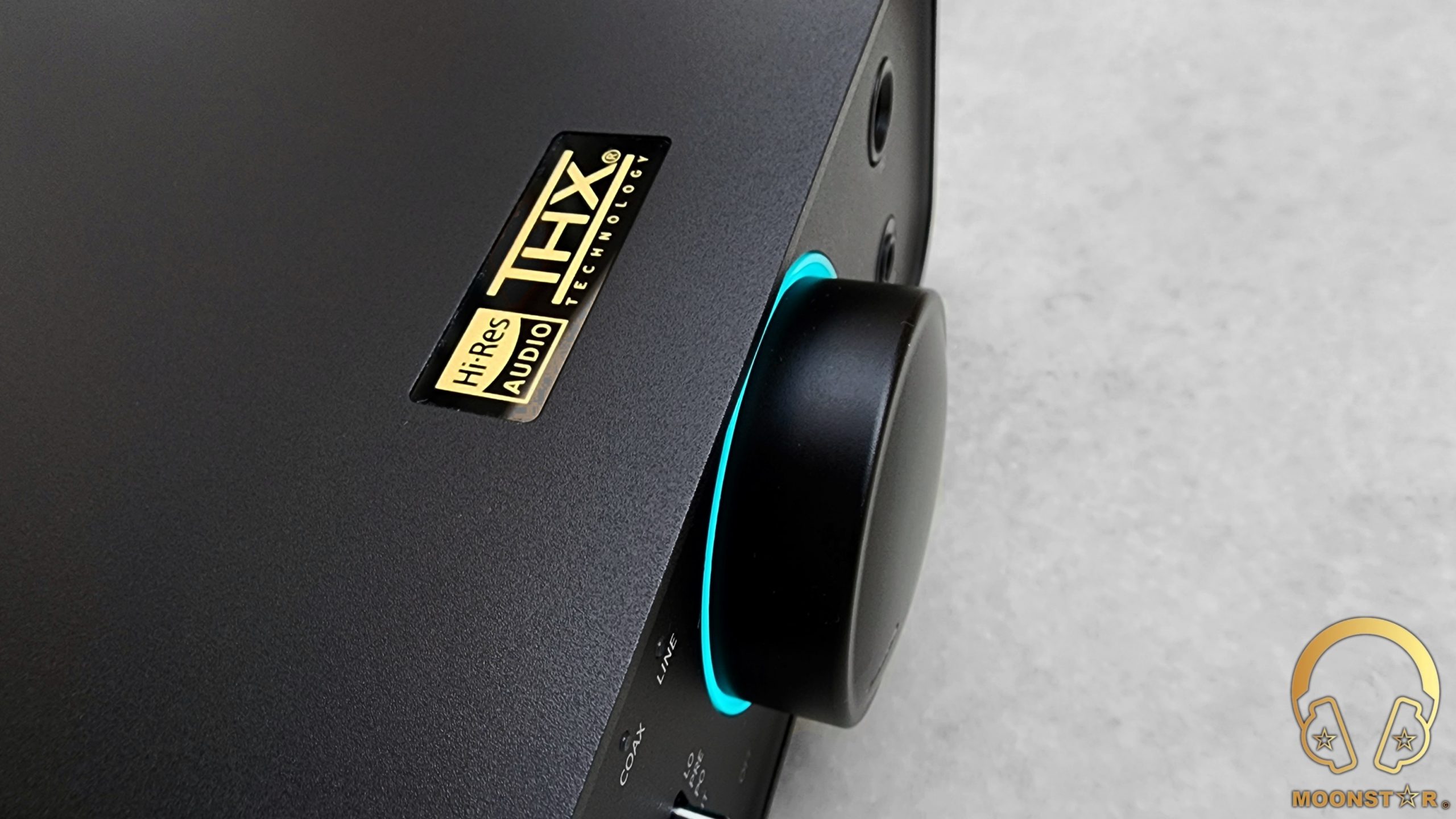
The Sound:
The FiiO K7 is a highly versatile and powerful DAC & Amplifier solution that impressed me with its very clean and natural presentation, that shows just the right amount of coloration in order to create a pretty musical and to avoid a to sterile overall sound presentation. The K7 is a pretty detailed and natural sounding source with decent sense of technicality and dynamics for its price that works great with both power hungry full sized Headphones and pretty sensitive In-Ear Monitors.
This review has been written after a burn-in period of around 100 – 110 hours. My sound experience below are mainly based on my impressions over the 4.4mm Balanced output paired with In-Ear Monitors such like the FiiO FH9, FH7S and Headphones like the HiFiMAN Sundara and SIVGA Oriole.
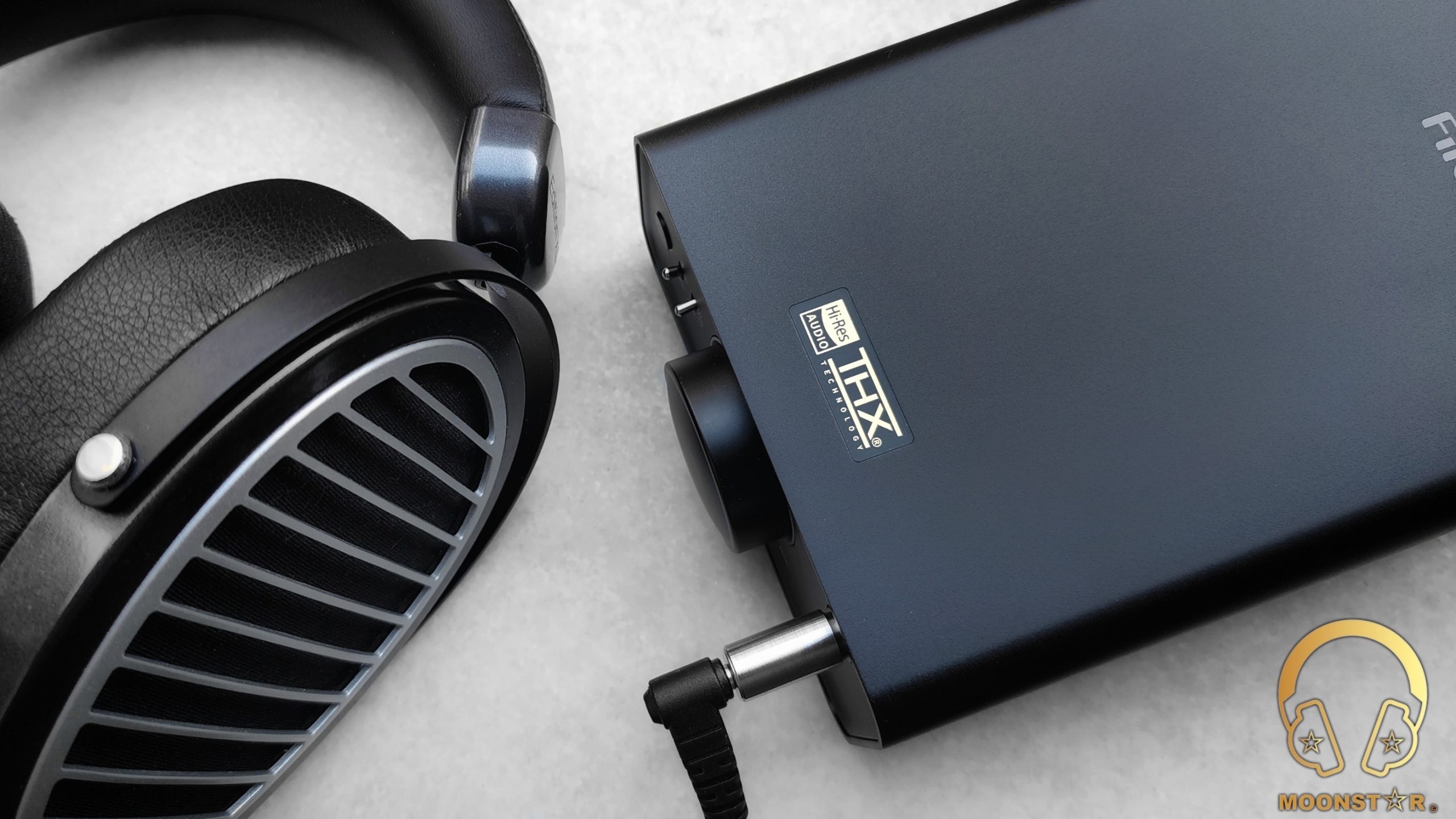
Bass:
The FiiO K7 offers a pretty natural, clean and nicely detailed overall bass response from the subbass up to the midbass region. It was also able to handle all headphones (HiFiMAN Sundara CB, HiFiMAN Edition XS) and IEM’s (FiiO FH9, FiiO FH7S, Meze Audio RAI Penta) in this area with decent sense of authority.
The subbass region of the K7 shows a decent grade of depth and authority with almost all IEM’s and Headphone I have listen to it. Some of my reference songs such like Lorde’s “Royals”, Massive Attack’s “Angle” or to Daft Punk “Doin’ it Right” have been produced with good level of rumble and extension.
The midbass region on the other hand is reproduced in a pretty natural and controlled manner along with a good sense of impact and intensity when I have listened to complex bass passages in songs like Gogo Penguin’s “Raven” or Charly Antolini’s “Duwadjuwandadu”. This is quite impressive for a device with such a reasonable pricing.
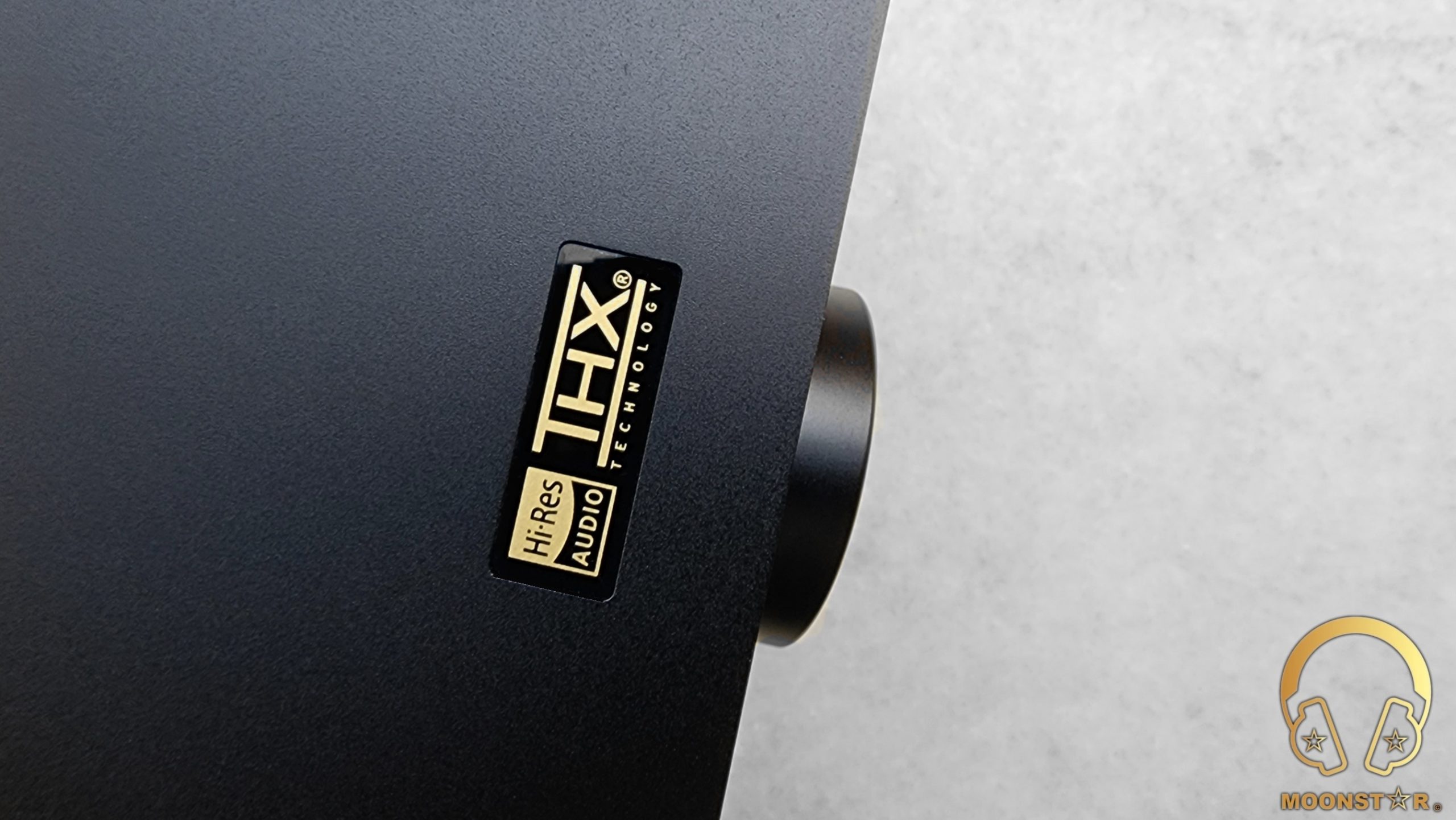
Midrange:
The midrange of the FiiO K7 stands out with it highly transparent and airy atmosphere when I listen to both vocals or to a wide variety of instruments, which shows again how capable this device is as a headphone/earphone DAC & Amplifier.
The sense of resolution from the lower up to the upper midrange area is excellent, especially with respect to the price of this device, which is also shown with an additional dynamism that comes with support from its pretty powerful THX AAA 788+ amplifier circuit.
I have listen to the K7 to a wide variety of instruments including violins, side flutes, cellos or pianos that have been reproduced with a decent level of resolution and naturalness, especially when paired with good In-Ear Monitors or headphones such like the FiiO FD7, Meze RAI Penta and HiFiMAN Edition XS, thanks to its quite airy and transparent midrange atmosphere.
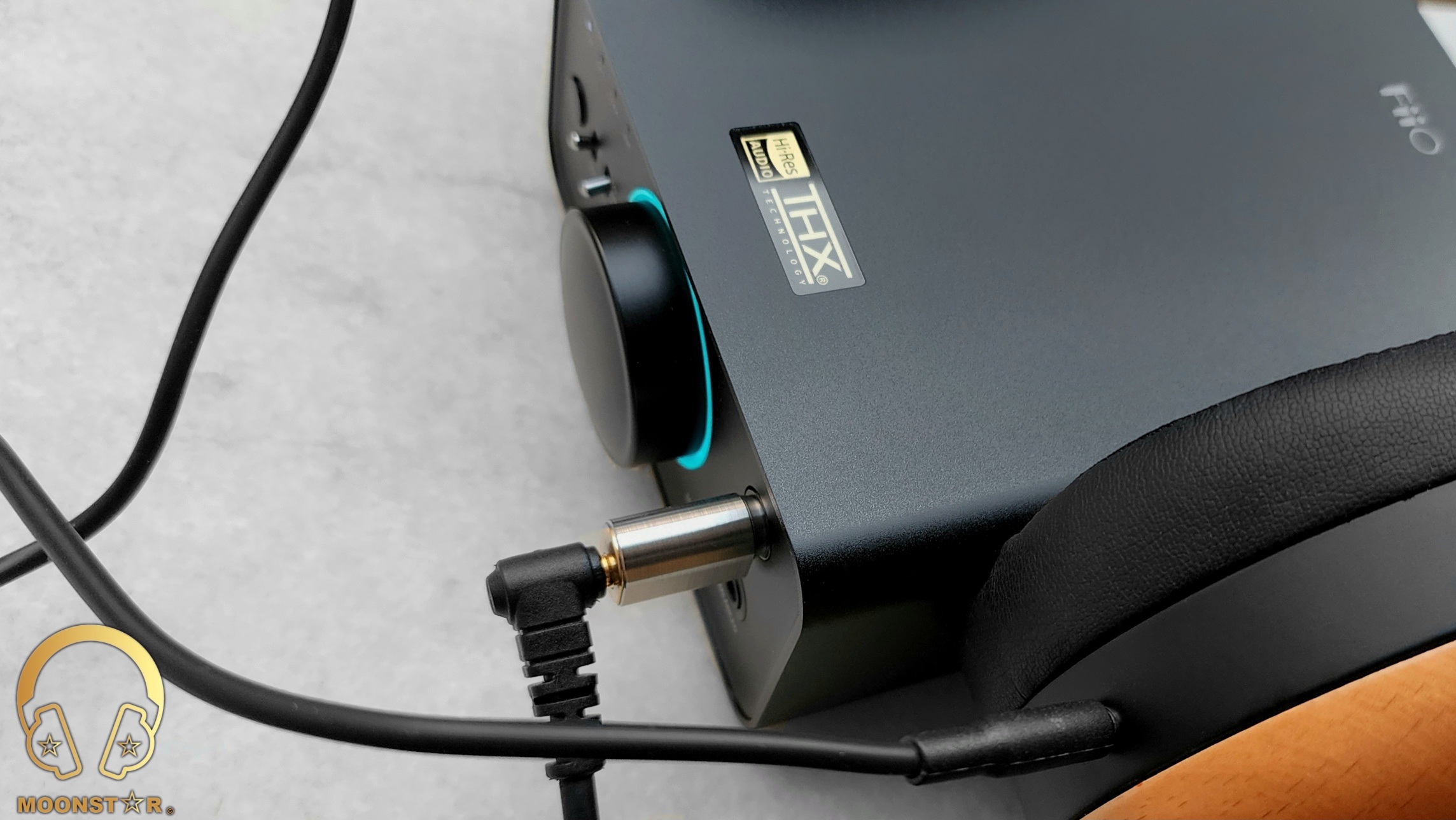
Treble:
What I really like about the treble presentation of the FiiO K7 is its pretty uncolored nature, which is also able to create a decent sense of clarity and sparkle with all IEM’s and Headphones I have paired the device. The grade of resolution and extension fulfills my expectation from a desktop DAC/Amplifier at this price level especially when I do listen to woodwinds, percussions and to soprano vocals.
Both the lower and the upper treble range are shown with a good level of balance. The lower treble area is shown with a decent grade of clarity and definition, while each individual instrument has been stand out pretty clearly. Instruments from hi-hats in metal music up to violins in classical music are reproduced with good level of presence and extension.
The upper treble area of the FiiO K7 creates a fairly open and airy atmosphere with good sense of brightness that is needed for vocals and for instruments such like cymbals, violins or clarinets without to show any remarkable hissing. The general extension and resolution of this area is again, excellent for a DAC/Amplifier at this level.

Soundstage & Imaging:
The FiiO K7 has a general soundstage presentation that is spacious and airy, which creates decent conditions for a pretty precise separation and placement of instruments and vocals. The soundstage is both fairly wide and deep, while the height of the stage is on a sufficient level.
Conclusion:
The K7 is another solid product from FiiO that impressed me with its versatility in terms of hardware features, compatibility and overall sound performance that pairs pretty well with both sensitive In-Ear Monitors and power hungry Planar Headphones. Moreover, it offers a clean, powerful and quite detailed listening experience that surprised me very well with respect to its reasonable price. The result is a DAC & Amplifier with a pretty small form factor that I can Highly Recommend!
Thank you for the Read!
Dsnuts
Headphoneus Supremus
Pros: Solidly well engineered DAC/AMP
Aluminum alloy housing.
Not too big, but big on sound.
AK4493SEQ chips. THX AAA-788+chips
Low and High gain.
A good variety of usable connectivity.
Simple toggle switches for ease of use.
Large digital volume wheel with no channel imbalance at any volume.
Subjectively one of the best SQ for the bucks.
With a big, large dynamic musical sound quality.
Supreme low noise floor, for enhanced dynamism
Supreme for IEMs even sensitive IEMs
Supreme power for CANs of all types.
Supreme bang for buck for DAC/AMPs
RGB lighting-some don't like.
Laws of diminishing returns start from the K7
$200! You simply couldn't ask for better sound for the money.
Aluminum alloy housing.
Not too big, but big on sound.
AK4493SEQ chips. THX AAA-788+chips
Low and High gain.
A good variety of usable connectivity.
Simple toggle switches for ease of use.
Large digital volume wheel with no channel imbalance at any volume.
Subjectively one of the best SQ for the bucks.
With a big, large dynamic musical sound quality.
Supreme low noise floor, for enhanced dynamism
Supreme for IEMs even sensitive IEMs
Supreme power for CANs of all types.
Supreme bang for buck for DAC/AMPs
RGB lighting-some don't like.
Laws of diminishing returns start from the K7
$200! You simply couldn't ask for better sound for the money.
Cons: Wish it had more gain levels. Not a big deal as it still covers all types of phones
No MQA- not a negative for many
No Wifi, bluetooth -not really a negative depending on your needs.
RGB-actually gives a modern touch to the K7
Makes your more expensive sources not sound as good.
No MQA- not a negative for many
No Wifi, bluetooth -not really a negative depending on your needs.
RGB-actually gives a modern touch to the K7
Makes your more expensive sources not sound as good.
Fiio K7

Fiio needs no introduction, I am certain you know the company that brings to the masses new and innovative audio products that are clearly made with passion and drive for audio enthusiasts around the world. The one aspect I appreciate about Fiio is that they have products that cover a broad range of needs for the audio enthusiast, be it the digital audio player to a nicely performing IEM. Over the years I have seen the humble beginnings of what is now a premiere force in the audio industry. Just my opinion on Fiio but as an enthusiast. I appreciate the dedication which clearly shows in their products.
What put Fiio on the map for many enthusiasts was their affordable line of audio sources and amps that has progressively gotten more advanced and objectively better through the years. I know folks turn a blind eye to advertised marketing material as we are constantly bombarded with the stuff, especially at this time of the year but with Fiio you can actually see the differences and advancements in their newer audio goods compared to their prior iterations. This does not seem to be a company competing with others in the industry but one that actually competes with itself. Don’t believe me check out the specs of something like their Fiio K5 or even the K5pro and then compare what you're getting in the K7 for a bit more. Or any of their previous DAPs and sources to what is available now. It's not that the prior dac/amps Fiio have made are somehow worse. They all have their pluses and minuses but one thing I do know about recent Fiio offerings.

All their audio goods seem to be produced with value in mind for what you're paying in the market. Fiio actually gives a buyer a reason to invest in a new piece of hardware they are making. If it's not an advancement in why you buy, then why even bother? Case in point we have the new K7 today a simple yet powerful dac/amp which is sold in a price range most can afford at $200. The K7 doesn't have wifi, bluetooth or MQA, It doesn't have a built in screen nor does it have batteries that can recharge. Nope this one is simple.
Ok I can see a scenario of some that might look at it as a negative here. Does it need to have MQA? And wifi and bluetooth? Or have a battery? I suppose it all comes down to what your needs are in a dac amp. Take a look at what the K7 was meant for and you will get a good understanding of what Fiio has done with the K7 that makes it quite substantial. It's not a portable gadget dac/amp. They got other sources that do those things. Nope, the K7 is an old school straight up powerful DAC/AMP. Aka sound card for your audio/media needs.
Everyone knows integrated computer audio is just a step above your phone audio in some cases worse. Most definitely nowhere close to a dedicated source or a sound that comes from a well implemented DAC/AMP. Integrated stuff is about as plane jane and non dynamic as it gets for sound quality but what you get when you add the K7 in the mix, you get something that sounds every bit the desktop unit the K7 is and more.

With that I would like to thank Fiio for providing a sample of their newest K7 for the purpose of a review. You can read all about their latest master work here. Also like to thank Sunny of Fiio for having the grace to be patient with me you are an angle. You can look up the K7 and purchase one on their aliexpress page here. The K7 has been used for a period of a month and now I am ready to report what makes this particular dac/amp something you need to pay attention to.
There is a lot of good in audio nowadays and you can certainly get some fairly substantial upgrades for sound cards for around the price of the K7 but nothing that I consider ground breaking if I am to be honest. I own and use numerous portable sources and I have done a review of Fiios own BTR7 you can read about here. I was blown away by just how capable the BTR7 is and most importantly its sound quality and power at the price/ form factor. So it isn't that Fiio does not make other dac/amp devices that have all the bells and whistles. Sometimes you just want a desktop plug and play device that will have substantial power to drive your more demanding Cans and even sensitive IEMs, but most importantly need to have a clear upgrade in sound quality when you're at home or work. That is in fact what the K7 is all about. Just my opinion, but the K7 here is a groundbreaking device at the price it sold at and I will get to my reasoning why in this review.
In the K7, we have the opposite of the small form portable wireless BTR7; it is a straight up power driven DAC/AMP. I would say most would probably use it on their computers. This is how I was using the K7. It does have some universal functionality in that you can connect anything from a game console via optical, record player via RCA line in, an external amp via RCA line out, a phone/tablet/DAP via not included USB-C/ lightning to USB-B cable or even connect to some speakers. So it is not 100% bare bones but what is important is how its power output and sound quality translates to using them with your favorite IEM or headphones at home.

What you get.
The K7 comes with the unit measuring 4.5”x2”thick x 6”long. For the international readers. Approximately 114mm x 51mm thick x 152mm long. Comes with a smaller external DC power adaptor and a wall cord. A meter long or 3.2ft USB-A to a USB-B cable to connect your computer with. And that is it. ( A bit of a complaint but I was hoping Fiio could have included at least a USB-C to USB-B cable but that's just a minor complaint. Makes you go out to the webs to buy one if you plan on trying to connect your phone, tablet or DAP to the K7.
It is using the same aluminum alloy chassis as their K5 and K5 pro. Of course the internal design is a one off meaning it is unique to the K7 but one that is surprising for its price point that makes them stand out. The inclusion of using their higher end THX AAA 788+ amplifiers two of them in a true balanced out configuration. For folks that are new to THX amplification. The K7 goes down as the cheapest device to be using these particular Amp chips in dual configuration for Fiio. Not to be confused, the BTR7 uses a more compact, less powerful variation of this amp chip called the THX-AAA 28.
These are the same Amp chips Fiio is using on their flagship DAP the FIIO M17 and their flagship portable DAC/AMP the Q7 and their flagship DAC/AMP the K9 Pro. A powerful output is one aspect of the K7 throwing out a solid 2,000mW of power at 32 Ohm load and plenty of usable power at 560mW at 300 ohm load. This my friends is ample power for most Cans and every type of IEM, high impedance buds ect. I would say this dac/amp will drive most 600 Ohm Cans with good listenable volumes as well. It should be enough power to drive about 95% of headphones and most definitely 100% of IEMs and buds out there with ample headroom.

As an IEM reviewer all that power doesn't mean squat if it is a noisy 2000mW at 32 Ohms. Fortunately there is another aspect that Fiio keeps on getting better at with their newer devices. Compared to devices past, all their newest audio goods including the K7 has one of the cleanest noise floors imaginable on any such modern devices. I have IEMs with 10 ohm impedance and I have yet to detect any hiss of any type in the K7 on low gain. That is remarkable as I own DAPs that emit minor noise and those were pretty much made for IEM use is my point. A black background enhances dynamics for our music and that is that the K7 does. Hence the K7 is actually ideal for IEM use, This and it has to be one of the best bang for buck for sheer sound quality around. Will get back to these aspects on my sound tester later.
Going back on the lack of wifi and such. If I was a guessing man, I am thinking Fiio is going for all out sound quality and power on this one for the bucks. To me anyways this is what truly matters for a DAC/AMP. You can have all the bluetooth compatibility and wifi you want on a device, but does it have enough power to drive your Cans with a clear upgrade in sound quality to match? Are you willing to give up on those features as long as the sound quality is one of the best you have heard at this price and not to mention power output usually reserved for much higher end devices? If you answered Yes. Then the K7 will be for you.

K7 from the backside can be connected via USB, Coaxial, optical, RCA in single ended line in, RCA pre/single ended line out.

The front side of the K7 centrally includes an oversized knob for its digital volume wheel. This volume wheel has a slight lag especially when turned on. For me anyways, it is not a big deal. Volume adjustment is a fairly smooth experience. First 1/3rd of the wheel ramps up slower vs the later half where it can jump to higher volumes in a hurry. I was very surprised this works surprisingly well even for my 10 ohm highly sensitive IEMs. Volume adjustment becomes easy and intuitive the more you use it. Its smooth volume gain is greatly appreciated from an IEM reviewers perspective as I can’t have jankiness to the volume wheel. The best aspect of Fiios volume wheel is that it has no imbalance issues, some much more expensive devices I own have.
I suppose Fiio had to add a bit of a modern touch by adding in some RGB lighting around the volume knob which indicates the type of music file you're listening to. The lighting when turned on emanates a rainbow of colors and then fixates on one color that indicates the type of file you're using for sound or music. I know there have been some rumblings of folks that don’t like the RGB lighting. To be honest it isn’t all that bad. It does add a bit of a modern touch to the design which otherwise would be fairly bare bones looking. Certainly matches the RGB lighting to my main work/ play laptop. Fiio rep has told us that they might consider a way of turning that on and off via firmware.
Front panel contains two toggle switches with two levels of power. Low output obviously for your easy to drive Cans and IEM usage. High power output which gives you the full brunt of its clean power. I do wish there were 3 levels here: low, medium and high gain but the way these two levels work it will work for anything easy to drive to stuff that is much harder to drive and everything in between.
Next to that is the function switch. Line out to your external amps using the K7 as a DAC, Preamp mode to put that power to speakers, Phone out for your headphones. The input button toggles between the sources you are connected to USB,OPT,COAX,LINE.. Simple, clean and effective. There is a slight pause when toggling switches, which is actually a good thing.
Headphone out includes a full size 6.35mm and a balanced 4.4mm. K7 comes with a 6.35mm male to 3.5mm female adapter so it serves both types just fine. Of course the 4.4mm can be easily used with an adapter if need be for 2.5mm balanced connection, Or 4.4mm balanced to XLR for your Cans if need be but these extras were not included for the K7.

For a company known for including extras, the K7 is basically no frills and certainly no extras. But why so? You may ask. It's because they make it up in sheer sound quality that's why. If you need to get yourself some extra adaptors and cables to use the K7 that will be up to you. However once you actually hear the K7 perform. You will understand why Fiio didn’t have to provide a single extra.

The foundation for the K7 sound quality comes from two new AK4493SEQ DAC Chips. A newly developed chip by DAC chip manufacturer Asahi Kasei which is described as a 32bit premium stereo dac with AKs famous Velvetsound technology, achieving industry’s leading low level distortion characteristics and wide dynamic range. On a personal note. I own numerous DAPS with AK chips which I am a huge fan of.The AK4493SEQ reminds me a lot of their former AK4497 in performance and its sound quality. Could be AK just giving more to the consumer. Subjectively for folks that love musicality and dynamics the AK line with their Velvetsound is still highly sought out by audio manufacturers for their smooth natural dynamic take on the DAC sound which is clearly evident on the K7.
Then you add them THX AAA 788+ Amp chips. But then it goes beyond that. It is well known in the industry, to have power you have to have a clean source for that power. Short of actually doing a full linear power supply. Fiio included a 12V/24w power supply complete with low noise LDOs or low dropout regulators integrated into the hardware for clean usable power to the K7. What you should care about is how all this translates to how the K7 will sound.

I am gonna just say it for my readers here. The K7 is the best sound quality dac/amp I have ever heard at this price point. The closest dac/amp I own at the K7 price range is an older Audinst HUD-MX2 dac/amp that I have used over the years I bought for around $250 and believe me for sheer power and SQ nothing I own comes close. For prospective buyers that own the Fiio BTR7. Imagine that sound quality in a full blown desktop dac/amp and that is actually what the K7 sounds like.

When I first heard the K7 I was hit by a full blown powerful dynamic sound quality that I was not ready for. I own devices that cost way more than the K7 yet there is no comparison to anything at the price range. There just can’t be. Compared to mid fi level DAPs I own the K7 is on a different level for sheer sound quality and power. Compared to my Audinst which has an excellent neutral sound quality. No comparison. The sheer authority and dynamics are from something you would need to pay much more in order to achieve.
And this is the reason why Fiio did not offer extras in the box for the K7. I can see the board meeting with their engineers on this one. “ So what can you do with a $200 dac/amp that will raise the bar for such devices.” The answer was the K7.
Sound quality.
The first thing that hits you is its grand sense of its presentation. The sound that emanates effortlessly is its power and an enveloping way. Once you hear it you can’t unhear it. It has more than just power in a physical sense. Its sheer dynamics with that power that is again something you would never assume you can hear at this price range. I know Fiios own flagship K9 pros will have greater sound quality, and I have never heard the K9 pro but I would imagine the sound quality of the K7 coming awfully close at a fragment of the cost, especially their former original AK version of the K9 pro. The sound quality of the K7 is one of the best if not the best I have ever heard and at the $200 price level. My basis for this statement is that I actually use and own a fairly wide variety of devices from Fiio and its competition, Shanling, IFI and IBasso to name a few.
The reason why I own and use more sources than most is due to my obligation as a reviewer. One of the aspects of reviewing is that I try an IEM on a variety of sources and not just one or two. It does the IEM or Can no justice to hear them through a single source to get a good evaluation of what the IEM is doing. For this reason alone where I spend the money is for sources that can do the IEMs and Cans justice. The K7 punches above what you will be paying to own one in sheer sound quality alone. If I was to put a price tag on its sound quality and power, I would put it somewhere north of $500 and that is being conservative.

Trebles.
The similarities of how the trebles are presented for the K7 is remarkably similar to their bluetooth dac/amp the BTR7. But even better defined, expansive/ grander in scope. Trebles has a good solid footing in the sound tuning of the K7 but it is more grounded in how it sounds vs being lofty or overly extended for the sake of high fidelity. In other words it is clearly an AK based sound. The trebles has a very good definition of note and you will certainly hear treble tones with accuracy, clarity and precise transient qualities. I own Dac/amps with greater extension brightness/emphasis for trebles but some might not like the more analytical angle that particular dac/amp may portray speaking about the Audinst I mentioned earlier. A smoother treble seems to be a part of the AK velvetsound tech that brings more of a euphoric musical take on the DAC signatures vs being analytical or dry neutral in nature. Of course the amp stage has a lot to do with how the source sounds overall but treble presentation for a dac/amp will give it arguably more character even vs the bass end. For the K7 its treble layering is superb, defined yet clearly stays well controlled which leads to a very slight smoother more rounded treble response AK is known for. Treble qualities helps with its smoother yet clearly dynamic signature of the K7

Mids
Neutral yet supremely layered. Here is where the sound quality of the K7 brings a full bodied emotive sound experience to your Cans and IEMs. The mids of the K7 exudes musical dynamism. Leaning naturally slightly warmer in its presentation the mids for the K7 has the most important ingredient for a higher end sound quality. That is its dimensional character. It not only exudes an ideal body of note but enough head room for your cans and IEMs to add its own coloring to the mix and somehow maximizes their synergy together for a sound experience you would never expect at this price range. The natural tonal character and presentation of the K7 gives you a raw power that is missing from a lot of DAPs that provide decent specs. The AK4493SEQ chips provide the digital shaping for what you are hearing. The THX amps provide that big full blown power that you're not hearing from your conventional sources. The design comes together for one of the absolute best sound qualities you're ever going to hear anywhere close to this price range.
Mids gives a sense of power that you're missing from your DAPs. Music should be about getting you immersed and sometimes added power is needed for ultimate synergy with your favorite IEMs and Cans. The K7 amplification is what sets it apart from my DAPs and other sources I own. A powerful mid range means it has a full range that others just can’t reach. This combination of AK DAC integration with THX amplification is for folks that love their musicality in music. The sheer reason why we even listen to music in the first place. It provides the punch in a literal sense that seem lacking in portable music players. The height and depth of the mids is astounding and here is where I feel where the THX amplification really stands out vs your traditional op amps. Granted I have heard sources with wider stage but if you care about body, texture, fullness, grandeur of your sound. The K7 has it in spades. No matter what I connect the K7 to. It literally maxes out the sound quality of what I connect it to. That my friends is remarkable.
I don’t feel like I am downgrading from using my DX300Max to the K7. Let me put it that way. On the contrary it actually sounds like a side grade as crazy as that sounds. We are talking about a player/source worth over 10X the price of the K7 is my point. Somehow I am not getting a lesser sound quality here. That is the astonishing aspect of the K7 that I just can’t understand. Diminishing returns? Check out the K7 and you will clearly understand. Sure you can get a DAC/AMP that has all the features you're looking for with wifi and bluetooth and such. But I am willing to bet anyone that reads this. All them nice looking wizbang dac/amps wont beat the K7 for sheer sound quality and power. Going on a limb on that one.

Bass. Personal THX!
Beyond the meaty mids presentation of the K7. Here is where the K7 shines in my opinion. You can’t have THX amplification with a weak neutral bass. Common now, Bass is a part of the K7 sound profile. Surprise, surprise, it is not actually a fully neutral type tuning on the K7 but I prefer it that way. My point is when was the last time you heard a live concert and it sounded neutral? Natural should be about a natural bass impact and deep hitting sub bass presentation. Cuz it is in the mix it has to be present in the sound source right? That's the way I see it any way. The K7s outstanding dynamic character perhaps starts at the bass, its impact and range in its tuning. The K7 has an impactful bass end and clearly shows it can provide plenty of low end to any phone it is attached to. Certainly not to the point where bass is the main focus. I would put that on its luscious full bodied mids presentation. Bass is just the icing on the cake here. I have always claimed Fiio engineers are made up of bassheads. Why else would they hand pick THX implementation?
Never heard anything they do for source or IEM wise that didn’t have a good amount of it, and you can certainly expect that for the K7. This ends up making neutral IEMs and Cans sound even better than they should on any other source. And for bass fanatics. Short of actually applying a bit of bass boost which the K7 does not have. Don’t need it. Where bass is critical for tone, definition, tightness, completeness with its impact and extension. The K7 presents a full monty bass aspect that sounds remarkably natural in cohesion with the rest of its sound signature. Fiio did not include a bass switch on this one but to be honest it isn’t needed.
Its natural full bass character brings that dynamism forward for gaming, movie watching and your music. Which I tested and I have to say going from Fiios prior K3 which was what I was using my media laptop to the K7 is not just a small upgrade in performance.

No crazy 3D dolby mode or anything but my playing time using the K7 on God of War was unbelievably satisfying. Directional cues, I can tell exactly where monsters are waiting in ambush. Its epic sound score comes through with excellent immersion. Explosions, sound effects of my Axe, arrows, water effects, weather effects. I was 100% immersed in its audio production using the K7 and is that not a reason to get something like the K7? To upgrade your media sounds? It is actually mind blowingly FANTASTIC for gaming. Let me just say as an avid gamer and music listener. If something happened to the K7. I would get another without blinking. Actually, I have been eyeing their K9pros. You know how this hobby goes. By the way, that is the warning I will give prospective buyers for K7. After using the K7. You most certainly will start thinking of Fiios higher up DAC/AMPs. If the K7 at $200 is this good. You gotta wonder how their flagship DAC/AMP performs. Now I know what I want for Christmas let me put it that way.
Movie watching. Big explosive effects using your closed cans in my case the Fostex TH-X00, a classic bass driven dynamic can which is a staple of my headphone collection. I don’t think I have ever heard bass on these cans quite like how it sounds with the K7. Beyond the bass. These cans and the K7 make for the perfect Movie watching experience. It is my personal THX audio. I can’t even begin to tell you folks how enjoyable watching something like Gladiator or something grand in scale like Blade runner sounds like using this combo.The K7 provides the exact dynamic experience for movie watching that you want to hear when watching such movies. You're not going to hear these soundtracks with a wimpy analytical sound are you? Nope give me some beef! K7 has that in spades.

For music listening
The K7 is my ideal sound signature as a source. I will just post some pics of IEMs and headphones I have tested the K7 with. I am gonna tell you folks. There is nothing that I will post in this review that sounds mediocre with the K7. I can blindly choose one of the 100s of IEMs or any of my Cans. It really dont matter. All of it sounds superb on the K7. The body, dynamism, definition added dimensions and layering with a raw power of the K7 sound is what wins it for me. A note to my fellow IEM enthusiasts. Do yourself a favor. I know there are a number of cheaper dac/amps, dongle dac amps and such you can get for your $200.
Get yourself a K7 and be done with. Your essentially getting a stupid high end DAP sound quality experience in the K7 for the money. You want maximum sound value? You will certainly get that with the K7.

In the end.
I am mad at Fiio. Yes, that's right. Mad at em. This device has now made me want to get all their flagship products that I shouldn’t be spending on. I do have two grown sons both in Universities that require I spend an arm and a leg for, to help with their tuition, food and life expenditures, not just my own. I am sure some of you know what I am talking about. But now I am questioning my priorities. College tuition and books for my sons is not as important as a new Fiio Q7 or K9 pro.

I kid. The K7 here is substantial folks. Out of all the audio goods I have reviewed this year the K7 goes down as the most substantial of all of them. This thing surprises me every time I listen to music on the thing. Let alone watch a movie or play a game using its sound. It has one of the most dynamic, musical meaty sound signatures I have ever heard in any source. It clearly plays to how l like to listen to my music.

It is like a thick cut of aged prime wagyu beef that you savor with every bite. This magical combination of AK4493SEQx2 and THX-AAA788+x2, extremely low noise floor/ clean power= audio bliss. No other way to put it. If you're considering a new sound card for your audio needs. You have to consider what Fiio has done with their K7. It is about as good as it gets for the bucks folks and if making your money counts for audio goods is a priority to you. Get yourself a K7 and be done with. You're not going to hear a better sounding source at the price of getting one. I am willing to guarantee you that. Thanks for taking the time to read.

Fiio needs no introduction, I am certain you know the company that brings to the masses new and innovative audio products that are clearly made with passion and drive for audio enthusiasts around the world. The one aspect I appreciate about Fiio is that they have products that cover a broad range of needs for the audio enthusiast, be it the digital audio player to a nicely performing IEM. Over the years I have seen the humble beginnings of what is now a premiere force in the audio industry. Just my opinion on Fiio but as an enthusiast. I appreciate the dedication which clearly shows in their products.
What put Fiio on the map for many enthusiasts was their affordable line of audio sources and amps that has progressively gotten more advanced and objectively better through the years. I know folks turn a blind eye to advertised marketing material as we are constantly bombarded with the stuff, especially at this time of the year but with Fiio you can actually see the differences and advancements in their newer audio goods compared to their prior iterations. This does not seem to be a company competing with others in the industry but one that actually competes with itself. Don’t believe me check out the specs of something like their Fiio K5 or even the K5pro and then compare what you're getting in the K7 for a bit more. Or any of their previous DAPs and sources to what is available now. It's not that the prior dac/amps Fiio have made are somehow worse. They all have their pluses and minuses but one thing I do know about recent Fiio offerings.

All their audio goods seem to be produced with value in mind for what you're paying in the market. Fiio actually gives a buyer a reason to invest in a new piece of hardware they are making. If it's not an advancement in why you buy, then why even bother? Case in point we have the new K7 today a simple yet powerful dac/amp which is sold in a price range most can afford at $200. The K7 doesn't have wifi, bluetooth or MQA, It doesn't have a built in screen nor does it have batteries that can recharge. Nope this one is simple.
Ok I can see a scenario of some that might look at it as a negative here. Does it need to have MQA? And wifi and bluetooth? Or have a battery? I suppose it all comes down to what your needs are in a dac amp. Take a look at what the K7 was meant for and you will get a good understanding of what Fiio has done with the K7 that makes it quite substantial. It's not a portable gadget dac/amp. They got other sources that do those things. Nope, the K7 is an old school straight up powerful DAC/AMP. Aka sound card for your audio/media needs.
Everyone knows integrated computer audio is just a step above your phone audio in some cases worse. Most definitely nowhere close to a dedicated source or a sound that comes from a well implemented DAC/AMP. Integrated stuff is about as plane jane and non dynamic as it gets for sound quality but what you get when you add the K7 in the mix, you get something that sounds every bit the desktop unit the K7 is and more.

With that I would like to thank Fiio for providing a sample of their newest K7 for the purpose of a review. You can read all about their latest master work here. Also like to thank Sunny of Fiio for having the grace to be patient with me you are an angle. You can look up the K7 and purchase one on their aliexpress page here. The K7 has been used for a period of a month and now I am ready to report what makes this particular dac/amp something you need to pay attention to.
There is a lot of good in audio nowadays and you can certainly get some fairly substantial upgrades for sound cards for around the price of the K7 but nothing that I consider ground breaking if I am to be honest. I own and use numerous portable sources and I have done a review of Fiios own BTR7 you can read about here. I was blown away by just how capable the BTR7 is and most importantly its sound quality and power at the price/ form factor. So it isn't that Fiio does not make other dac/amp devices that have all the bells and whistles. Sometimes you just want a desktop plug and play device that will have substantial power to drive your more demanding Cans and even sensitive IEMs, but most importantly need to have a clear upgrade in sound quality when you're at home or work. That is in fact what the K7 is all about. Just my opinion, but the K7 here is a groundbreaking device at the price it sold at and I will get to my reasoning why in this review.
In the K7, we have the opposite of the small form portable wireless BTR7; it is a straight up power driven DAC/AMP. I would say most would probably use it on their computers. This is how I was using the K7. It does have some universal functionality in that you can connect anything from a game console via optical, record player via RCA line in, an external amp via RCA line out, a phone/tablet/DAP via not included USB-C/ lightning to USB-B cable or even connect to some speakers. So it is not 100% bare bones but what is important is how its power output and sound quality translates to using them with your favorite IEM or headphones at home.

What you get.
The K7 comes with the unit measuring 4.5”x2”thick x 6”long. For the international readers. Approximately 114mm x 51mm thick x 152mm long. Comes with a smaller external DC power adaptor and a wall cord. A meter long or 3.2ft USB-A to a USB-B cable to connect your computer with. And that is it. ( A bit of a complaint but I was hoping Fiio could have included at least a USB-C to USB-B cable but that's just a minor complaint. Makes you go out to the webs to buy one if you plan on trying to connect your phone, tablet or DAP to the K7.
It is using the same aluminum alloy chassis as their K5 and K5 pro. Of course the internal design is a one off meaning it is unique to the K7 but one that is surprising for its price point that makes them stand out. The inclusion of using their higher end THX AAA 788+ amplifiers two of them in a true balanced out configuration. For folks that are new to THX amplification. The K7 goes down as the cheapest device to be using these particular Amp chips in dual configuration for Fiio. Not to be confused, the BTR7 uses a more compact, less powerful variation of this amp chip called the THX-AAA 28.
These are the same Amp chips Fiio is using on their flagship DAP the FIIO M17 and their flagship portable DAC/AMP the Q7 and their flagship DAC/AMP the K9 Pro. A powerful output is one aspect of the K7 throwing out a solid 2,000mW of power at 32 Ohm load and plenty of usable power at 560mW at 300 ohm load. This my friends is ample power for most Cans and every type of IEM, high impedance buds ect. I would say this dac/amp will drive most 600 Ohm Cans with good listenable volumes as well. It should be enough power to drive about 95% of headphones and most definitely 100% of IEMs and buds out there with ample headroom.

As an IEM reviewer all that power doesn't mean squat if it is a noisy 2000mW at 32 Ohms. Fortunately there is another aspect that Fiio keeps on getting better at with their newer devices. Compared to devices past, all their newest audio goods including the K7 has one of the cleanest noise floors imaginable on any such modern devices. I have IEMs with 10 ohm impedance and I have yet to detect any hiss of any type in the K7 on low gain. That is remarkable as I own DAPs that emit minor noise and those were pretty much made for IEM use is my point. A black background enhances dynamics for our music and that is that the K7 does. Hence the K7 is actually ideal for IEM use, This and it has to be one of the best bang for buck for sheer sound quality around. Will get back to these aspects on my sound tester later.
Going back on the lack of wifi and such. If I was a guessing man, I am thinking Fiio is going for all out sound quality and power on this one for the bucks. To me anyways this is what truly matters for a DAC/AMP. You can have all the bluetooth compatibility and wifi you want on a device, but does it have enough power to drive your Cans with a clear upgrade in sound quality to match? Are you willing to give up on those features as long as the sound quality is one of the best you have heard at this price and not to mention power output usually reserved for much higher end devices? If you answered Yes. Then the K7 will be for you.

K7 from the backside can be connected via USB, Coaxial, optical, RCA in single ended line in, RCA pre/single ended line out.

The front side of the K7 centrally includes an oversized knob for its digital volume wheel. This volume wheel has a slight lag especially when turned on. For me anyways, it is not a big deal. Volume adjustment is a fairly smooth experience. First 1/3rd of the wheel ramps up slower vs the later half where it can jump to higher volumes in a hurry. I was very surprised this works surprisingly well even for my 10 ohm highly sensitive IEMs. Volume adjustment becomes easy and intuitive the more you use it. Its smooth volume gain is greatly appreciated from an IEM reviewers perspective as I can’t have jankiness to the volume wheel. The best aspect of Fiios volume wheel is that it has no imbalance issues, some much more expensive devices I own have.
I suppose Fiio had to add a bit of a modern touch by adding in some RGB lighting around the volume knob which indicates the type of music file you're listening to. The lighting when turned on emanates a rainbow of colors and then fixates on one color that indicates the type of file you're using for sound or music. I know there have been some rumblings of folks that don’t like the RGB lighting. To be honest it isn’t all that bad. It does add a bit of a modern touch to the design which otherwise would be fairly bare bones looking. Certainly matches the RGB lighting to my main work/ play laptop. Fiio rep has told us that they might consider a way of turning that on and off via firmware.
Front panel contains two toggle switches with two levels of power. Low output obviously for your easy to drive Cans and IEM usage. High power output which gives you the full brunt of its clean power. I do wish there were 3 levels here: low, medium and high gain but the way these two levels work it will work for anything easy to drive to stuff that is much harder to drive and everything in between.
Next to that is the function switch. Line out to your external amps using the K7 as a DAC, Preamp mode to put that power to speakers, Phone out for your headphones. The input button toggles between the sources you are connected to USB,OPT,COAX,LINE.. Simple, clean and effective. There is a slight pause when toggling switches, which is actually a good thing.
Headphone out includes a full size 6.35mm and a balanced 4.4mm. K7 comes with a 6.35mm male to 3.5mm female adapter so it serves both types just fine. Of course the 4.4mm can be easily used with an adapter if need be for 2.5mm balanced connection, Or 4.4mm balanced to XLR for your Cans if need be but these extras were not included for the K7.

For a company known for including extras, the K7 is basically no frills and certainly no extras. But why so? You may ask. It's because they make it up in sheer sound quality that's why. If you need to get yourself some extra adaptors and cables to use the K7 that will be up to you. However once you actually hear the K7 perform. You will understand why Fiio didn’t have to provide a single extra.

The foundation for the K7 sound quality comes from two new AK4493SEQ DAC Chips. A newly developed chip by DAC chip manufacturer Asahi Kasei which is described as a 32bit premium stereo dac with AKs famous Velvetsound technology, achieving industry’s leading low level distortion characteristics and wide dynamic range. On a personal note. I own numerous DAPS with AK chips which I am a huge fan of.The AK4493SEQ reminds me a lot of their former AK4497 in performance and its sound quality. Could be AK just giving more to the consumer. Subjectively for folks that love musicality and dynamics the AK line with their Velvetsound is still highly sought out by audio manufacturers for their smooth natural dynamic take on the DAC sound which is clearly evident on the K7.
Then you add them THX AAA 788+ Amp chips. But then it goes beyond that. It is well known in the industry, to have power you have to have a clean source for that power. Short of actually doing a full linear power supply. Fiio included a 12V/24w power supply complete with low noise LDOs or low dropout regulators integrated into the hardware for clean usable power to the K7. What you should care about is how all this translates to how the K7 will sound.

I am gonna just say it for my readers here. The K7 is the best sound quality dac/amp I have ever heard at this price point. The closest dac/amp I own at the K7 price range is an older Audinst HUD-MX2 dac/amp that I have used over the years I bought for around $250 and believe me for sheer power and SQ nothing I own comes close. For prospective buyers that own the Fiio BTR7. Imagine that sound quality in a full blown desktop dac/amp and that is actually what the K7 sounds like.

When I first heard the K7 I was hit by a full blown powerful dynamic sound quality that I was not ready for. I own devices that cost way more than the K7 yet there is no comparison to anything at the price range. There just can’t be. Compared to mid fi level DAPs I own the K7 is on a different level for sheer sound quality and power. Compared to my Audinst which has an excellent neutral sound quality. No comparison. The sheer authority and dynamics are from something you would need to pay much more in order to achieve.
And this is the reason why Fiio did not offer extras in the box for the K7. I can see the board meeting with their engineers on this one. “ So what can you do with a $200 dac/amp that will raise the bar for such devices.” The answer was the K7.
Sound quality.
The first thing that hits you is its grand sense of its presentation. The sound that emanates effortlessly is its power and an enveloping way. Once you hear it you can’t unhear it. It has more than just power in a physical sense. Its sheer dynamics with that power that is again something you would never assume you can hear at this price range. I know Fiios own flagship K9 pros will have greater sound quality, and I have never heard the K9 pro but I would imagine the sound quality of the K7 coming awfully close at a fragment of the cost, especially their former original AK version of the K9 pro. The sound quality of the K7 is one of the best if not the best I have ever heard and at the $200 price level. My basis for this statement is that I actually use and own a fairly wide variety of devices from Fiio and its competition, Shanling, IFI and IBasso to name a few.
The reason why I own and use more sources than most is due to my obligation as a reviewer. One of the aspects of reviewing is that I try an IEM on a variety of sources and not just one or two. It does the IEM or Can no justice to hear them through a single source to get a good evaluation of what the IEM is doing. For this reason alone where I spend the money is for sources that can do the IEMs and Cans justice. The K7 punches above what you will be paying to own one in sheer sound quality alone. If I was to put a price tag on its sound quality and power, I would put it somewhere north of $500 and that is being conservative.

Trebles.
The similarities of how the trebles are presented for the K7 is remarkably similar to their bluetooth dac/amp the BTR7. But even better defined, expansive/ grander in scope. Trebles has a good solid footing in the sound tuning of the K7 but it is more grounded in how it sounds vs being lofty or overly extended for the sake of high fidelity. In other words it is clearly an AK based sound. The trebles has a very good definition of note and you will certainly hear treble tones with accuracy, clarity and precise transient qualities. I own Dac/amps with greater extension brightness/emphasis for trebles but some might not like the more analytical angle that particular dac/amp may portray speaking about the Audinst I mentioned earlier. A smoother treble seems to be a part of the AK velvetsound tech that brings more of a euphoric musical take on the DAC signatures vs being analytical or dry neutral in nature. Of course the amp stage has a lot to do with how the source sounds overall but treble presentation for a dac/amp will give it arguably more character even vs the bass end. For the K7 its treble layering is superb, defined yet clearly stays well controlled which leads to a very slight smoother more rounded treble response AK is known for. Treble qualities helps with its smoother yet clearly dynamic signature of the K7

Mids
Neutral yet supremely layered. Here is where the sound quality of the K7 brings a full bodied emotive sound experience to your Cans and IEMs. The mids of the K7 exudes musical dynamism. Leaning naturally slightly warmer in its presentation the mids for the K7 has the most important ingredient for a higher end sound quality. That is its dimensional character. It not only exudes an ideal body of note but enough head room for your cans and IEMs to add its own coloring to the mix and somehow maximizes their synergy together for a sound experience you would never expect at this price range. The natural tonal character and presentation of the K7 gives you a raw power that is missing from a lot of DAPs that provide decent specs. The AK4493SEQ chips provide the digital shaping for what you are hearing. The THX amps provide that big full blown power that you're not hearing from your conventional sources. The design comes together for one of the absolute best sound qualities you're ever going to hear anywhere close to this price range.
Mids gives a sense of power that you're missing from your DAPs. Music should be about getting you immersed and sometimes added power is needed for ultimate synergy with your favorite IEMs and Cans. The K7 amplification is what sets it apart from my DAPs and other sources I own. A powerful mid range means it has a full range that others just can’t reach. This combination of AK DAC integration with THX amplification is for folks that love their musicality in music. The sheer reason why we even listen to music in the first place. It provides the punch in a literal sense that seem lacking in portable music players. The height and depth of the mids is astounding and here is where I feel where the THX amplification really stands out vs your traditional op amps. Granted I have heard sources with wider stage but if you care about body, texture, fullness, grandeur of your sound. The K7 has it in spades. No matter what I connect the K7 to. It literally maxes out the sound quality of what I connect it to. That my friends is remarkable.
I don’t feel like I am downgrading from using my DX300Max to the K7. Let me put it that way. On the contrary it actually sounds like a side grade as crazy as that sounds. We are talking about a player/source worth over 10X the price of the K7 is my point. Somehow I am not getting a lesser sound quality here. That is the astonishing aspect of the K7 that I just can’t understand. Diminishing returns? Check out the K7 and you will clearly understand. Sure you can get a DAC/AMP that has all the features you're looking for with wifi and bluetooth and such. But I am willing to bet anyone that reads this. All them nice looking wizbang dac/amps wont beat the K7 for sheer sound quality and power. Going on a limb on that one.

Bass. Personal THX!
Beyond the meaty mids presentation of the K7. Here is where the K7 shines in my opinion. You can’t have THX amplification with a weak neutral bass. Common now, Bass is a part of the K7 sound profile. Surprise, surprise, it is not actually a fully neutral type tuning on the K7 but I prefer it that way. My point is when was the last time you heard a live concert and it sounded neutral? Natural should be about a natural bass impact and deep hitting sub bass presentation. Cuz it is in the mix it has to be present in the sound source right? That's the way I see it any way. The K7s outstanding dynamic character perhaps starts at the bass, its impact and range in its tuning. The K7 has an impactful bass end and clearly shows it can provide plenty of low end to any phone it is attached to. Certainly not to the point where bass is the main focus. I would put that on its luscious full bodied mids presentation. Bass is just the icing on the cake here. I have always claimed Fiio engineers are made up of bassheads. Why else would they hand pick THX implementation?
Never heard anything they do for source or IEM wise that didn’t have a good amount of it, and you can certainly expect that for the K7. This ends up making neutral IEMs and Cans sound even better than they should on any other source. And for bass fanatics. Short of actually applying a bit of bass boost which the K7 does not have. Don’t need it. Where bass is critical for tone, definition, tightness, completeness with its impact and extension. The K7 presents a full monty bass aspect that sounds remarkably natural in cohesion with the rest of its sound signature. Fiio did not include a bass switch on this one but to be honest it isn’t needed.
Its natural full bass character brings that dynamism forward for gaming, movie watching and your music. Which I tested and I have to say going from Fiios prior K3 which was what I was using my media laptop to the K7 is not just a small upgrade in performance.

No crazy 3D dolby mode or anything but my playing time using the K7 on God of War was unbelievably satisfying. Directional cues, I can tell exactly where monsters are waiting in ambush. Its epic sound score comes through with excellent immersion. Explosions, sound effects of my Axe, arrows, water effects, weather effects. I was 100% immersed in its audio production using the K7 and is that not a reason to get something like the K7? To upgrade your media sounds? It is actually mind blowingly FANTASTIC for gaming. Let me just say as an avid gamer and music listener. If something happened to the K7. I would get another without blinking. Actually, I have been eyeing their K9pros. You know how this hobby goes. By the way, that is the warning I will give prospective buyers for K7. After using the K7. You most certainly will start thinking of Fiios higher up DAC/AMPs. If the K7 at $200 is this good. You gotta wonder how their flagship DAC/AMP performs. Now I know what I want for Christmas let me put it that way.
Movie watching. Big explosive effects using your closed cans in my case the Fostex TH-X00, a classic bass driven dynamic can which is a staple of my headphone collection. I don’t think I have ever heard bass on these cans quite like how it sounds with the K7. Beyond the bass. These cans and the K7 make for the perfect Movie watching experience. It is my personal THX audio. I can’t even begin to tell you folks how enjoyable watching something like Gladiator or something grand in scale like Blade runner sounds like using this combo.The K7 provides the exact dynamic experience for movie watching that you want to hear when watching such movies. You're not going to hear these soundtracks with a wimpy analytical sound are you? Nope give me some beef! K7 has that in spades.

For music listening
The K7 is my ideal sound signature as a source. I will just post some pics of IEMs and headphones I have tested the K7 with. I am gonna tell you folks. There is nothing that I will post in this review that sounds mediocre with the K7. I can blindly choose one of the 100s of IEMs or any of my Cans. It really dont matter. All of it sounds superb on the K7. The body, dynamism, definition added dimensions and layering with a raw power of the K7 sound is what wins it for me. A note to my fellow IEM enthusiasts. Do yourself a favor. I know there are a number of cheaper dac/amps, dongle dac amps and such you can get for your $200.
Get yourself a K7 and be done with. Your essentially getting a stupid high end DAP sound quality experience in the K7 for the money. You want maximum sound value? You will certainly get that with the K7.

In the end.
I am mad at Fiio. Yes, that's right. Mad at em. This device has now made me want to get all their flagship products that I shouldn’t be spending on. I do have two grown sons both in Universities that require I spend an arm and a leg for, to help with their tuition, food and life expenditures, not just my own. I am sure some of you know what I am talking about. But now I am questioning my priorities. College tuition and books for my sons is not as important as a new Fiio Q7 or K9 pro.

I kid. The K7 here is substantial folks. Out of all the audio goods I have reviewed this year the K7 goes down as the most substantial of all of them. This thing surprises me every time I listen to music on the thing. Let alone watch a movie or play a game using its sound. It has one of the most dynamic, musical meaty sound signatures I have ever heard in any source. It clearly plays to how l like to listen to my music.

It is like a thick cut of aged prime wagyu beef that you savor with every bite. This magical combination of AK4493SEQx2 and THX-AAA788+x2, extremely low noise floor/ clean power= audio bliss. No other way to put it. If you're considering a new sound card for your audio needs. You have to consider what Fiio has done with their K7. It is about as good as it gets for the bucks folks and if making your money counts for audio goods is a priority to you. Get yourself a K7 and be done with. You're not going to hear a better sounding source at the price of getting one. I am willing to guarantee you that. Thanks for taking the time to read.
Last edited:
Sunstealer
Got a good Xmas deal on a new K7 - coming soon. I'll see what the amplifier stage is like compared to the ZEN CAN.
D
DewanPretorius
How does it handle lower quality recordings? Thanks in advance! (K5 ess in mind)
Dsnuts
Youtube videos sound like lossless quality. Makes for excellent media watching. All youtube stuff is lower quality some better than others. Actual lossless files sounds even better.

